
Ambite Mill, December 1937.
(left to right: Malcolm Dunbar, Robert Merriman, Umberto Galliani, unknown, Ernest Hemingway, unknown and Harry Poll.

Ambite Mill today.
Last updated; MAY 30th, 2023.
Hello everyone! It has been quite a while since I have updated this blog, and I humbly apologise for this remiss. I do put up quite a bit on the following Facebook pages:
Porta de la Historia.
The International Brigades Remembered.
and Brigadas Internacionales “Internacionales”
I will start adding materiel after the Solidarity Park event at Malgrat de Mar this weekend. We will have a table. Please join us and come and say hello!
For more information, go to:
And I promise to keep this Blog more updated on a weekly basis!
And here is something I passed around on Facebook a while ago. Aitor Garcia Sole is a good friend on the Ebro, and is particularly interested in the Great Retreats that occurred here in late March, 1938
Welcome to the co-operative initiative “Porta de la Historia”. For further information on any items included in this blog please write to pdlhistoria@gmail.com. Porta de la Historia is a co-operative initiative of individuals living in Catalunya, Spain and abroad who have a fascination in the Spanish Civil War of 1936 to 1939 and the social struggles that initiated and followed that conflict in not only Catalunya but also Spain and the World, especially in connection with the International Brigades who supported the Spanish Republic during that time. Historian Alan Warren started this group with the intention to provide a variety of initiatives and activities in order to raise awareness of Catalunya’s history in this important period and to allow individuals, groups and schools to explore the events and places in Catalunya and Spain. The history of Catalunya and its future are of course linked and PdlH (Porta de la Historia) feel that the time is now right to explain that history to both its inhabitants and to visitors from abroad. In addition Catalunya is a beautiful country with traditions, architecture, cuisine and natural history to explore as an added bonus. Being a group of Catalan and British individuals our combined skills, abilities and enthusiasm allow us to explain and explore Catalunya and Spain to those who wish to know more. Either as a curious individual with a passing interest in the subject or to those who wish to delve deeper into the history of the Spanish Civil War, PdlH are able to offer tours lasting from just half a day exploring the presence of George Orwell in Barcelona or the bombing of Barcelona to a week or more exploring the battlefields from Jarama to the Ebro depending on what is desired by clients. We can assure you of a tour quite unlike any other you may have experienced (and we mean that in a positive way!). Please explore this blog as we develop our plans and please contact us for further details or to offer us suggestions as to what you would like to discover.
Alan Warren, on behalf of Porta de la Historia
(pdlhistoria@gmail.com)
APRIL 24th, 2020.
Firstly, I would like to thank you for all your supportive messages over the past couple of weeks. Previously planned tours are now put forward for September, but I am amazed that others are enquiring about tours. Thank you very much!
On another note, I was pleased to read Gary Alikivi mentioning PdlH in a recent article. Gary made the documentary on Eileen Blair called “Wildflower” a few years ago, and we had fun making it.
Here is his article: https://garyalikivi.com/2020/04/23/postcards-from-spain-2/
In addition, Sylvia Topp’s Biography on Eileen Blair has just been released. Highly recommended!

And speaking of books,would people be interested in buying Spanish Civil War books direct from me? I will make up a list of books for sale and put it up over the next few days.
Be safe and take care.Things will get better.
APRIL 6th, 2020.
TAKE COVER!
Well, unless you have been hiding under a rock over the past few weeks, you are pretty all self isolating and coming to terms with a lot of leisure time to hand. I have spent the past couple of weeks contacting clients and trying to offer tours for later dates, hopefully for September? I hope that by then the situation in Spain will have calmed down. Just rest assured that tours prebooked are guaranteed. I am very happy to say that noone has asked for a refund. Thank you for your faith in us.
We will get back to very different normal. Hopefully a fairer and kinder normal. Big changes are afoot, and if we all stand together, we can make things better for the many and not the few. In a year from now we can hopefully look back in pride and see how people supported each other and rebuilt local communities that have fallen apart over the past few years. Whether people will want to fly as much is another matter. But I hope that I can continue my work.
If people wish to talk to me about future tours and plans, please write to us at pslhistoria@gmail.com. In the meantime I am transcribing unpublished memoirs and diaries of brigaders. So I am busy.And I hope that all our readers will have things to do and to occupy themselves. We will get through.
As an aside, here are some posters designed by Felix Rodriguez Fernandez.He has used the posters from the Spanish Civil War as his inspiration. Feel free to copy and print and use in your communities.
I will plonk in new bits and pieces every couple of weeks.
Stay safe and keep in touch.
FEBRUARY 20th 2020.
Some posters for events this weekend (and into March) at Jarama:
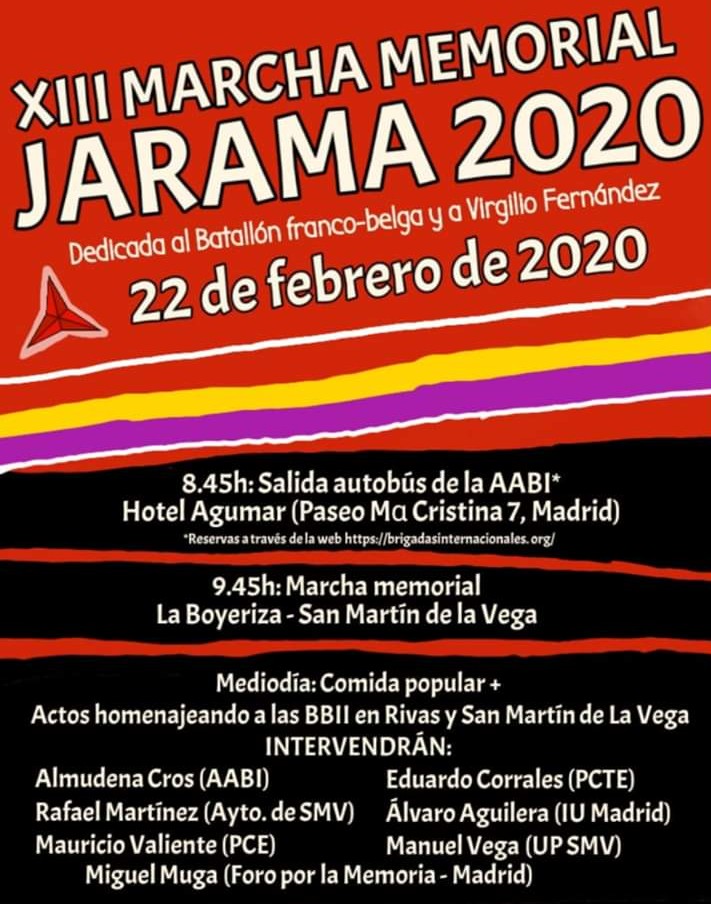
We will be there on Saturday.We are meeting an American whose uncle, Albert Beaulieu, was in the Canadian Mackenzie-Papineau battalion. On the Sunday we will follow the route of the Mac-Paps during the Great Retreats. In addition,I am lending our Mac-Pap flag to Pamela Vivian for Saturday, who is making a documentary on the Mac-Paps. We will take it up with us and photograph various locations where the Mac-Paps were on the Retreats (and at the Mac-Pap trenches at Fuentes de Ebro).
We will also take a then and now photo in Mas de las Matas (seen below). Sadly, the building behind has been drastically reformed.
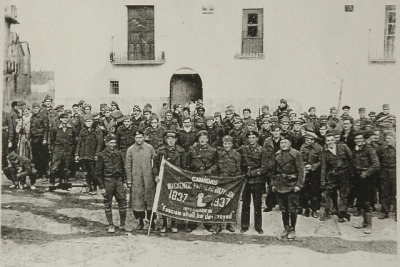
In Russell Palmer’s film, “Defenders of the Faith”, one can see the British battalion and Mac-Pap flags that were captured at Alcorisa in March 1938. Various illustrations of the flags appear in books, but we have used the film to design ours. You can see them both at 6’20”
Concerning the Mac-Paps, Tyler Wentzell will be releasing his biography of Edward Cecil Smith, the commander of the Mac-Paps. on March 15th. I am waiting for my copy!

Finally, a poster for other events following on from the AABI Jarama March:
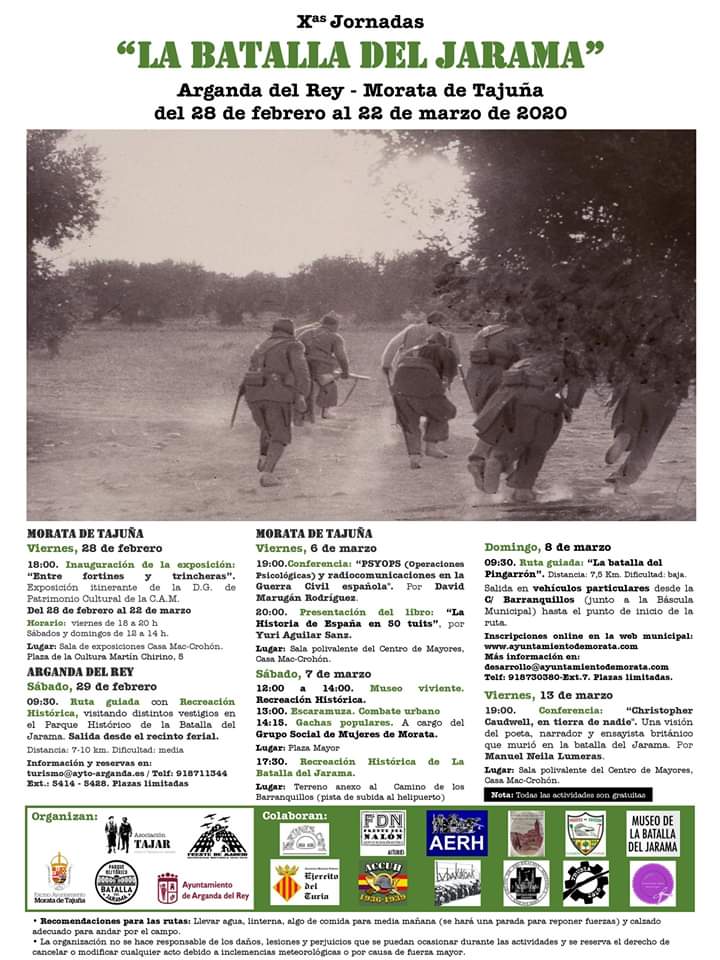
We are also working on The Merriman March with Anna Marti over the weekend of 21st to 22nd March- A 30km walk on the Sunday and a talk and showing of David Leach’s “Voices from a Mountain” with Spanish subtitles on the Saturday evening.
Poster to follow shortly.
Here is a short film we made on one of the first annual walks:
JANUARY 3rd 2020.
Our latest documentary! Very proud and happy to see the final result in Catalan, Spanish and English.
DOS RAMS DE FLORS. Les Brigades Internacionals a Tàrrega. Maig de 1938
TWO WREATHS OF FLOWERS. The International Brigades in Tàrrega, May 1938. ENGLISH VERSION
DOS RAMOS DE FLORES. Las Brigadas Internacionales en Tàrrega. Mayo de 1938. VERSIÓN EN CASTELLANO
JANUARY 2nd 2020.


NOVEMBER 30th 2019
I have now taken the first step towards updating the outdated theme that I had originally set up this Blog. It will take a while to become comfortable with it, and to keep this page updated, at least once a week. I must admit that I have kept using various Facebook pages to keep people informed. If you use Facebook, look up Porta de la Historia, The International Brigades Remembered and our reenactment group XV Brigada Mixta, I apologise if some readers feel uncomfortable with reenacting the SCW, but it is a didactic approach and engages many young people who visit such events to explore the tragedy of the conflict within their own familes and allow the subject to be openly discussed in public. Plus they say it is the most fun you can have with your clothes on, and I agree!
Here are some shots from my first reenactment at Fayon. Great fun and instructive in so many ways. Fayon for 2020 will be held on Saturday 25th July. XV Brigada Mixta will be there!
JUNE 17th, 2016
To commemorate the 80th Anniversary of the start of the Spanish Civil War, a few weeks ago I took Telegraph Travel writer Michael Kerr to the Ebro, as part of a trip organised by the Catalan Tourist Board.
And here is his article!
It mentions how to contact me by e mail, aswell as this blog, so I suddenly feel emboldened to update it so that people curious about doing such a tour of the Ebro battlefield can see that I am still alive!
In a nutshell my tours of the Ebro are usually over long weekends (though mad dash one day trips have been done!) from Barcelona, staying one or two nights in good quality accommodation on the Ebro. Depending on my workload, almost any weekend can be worked on, with ideally groups of up to a carload. And each tour is quite unique! From clambering up in the mountains, to visits to the museums on the battlefield, they are each adapted to clients’ needs and wishes. The Terra Alta is one of the poorest comarcas in Catalonia, and it is the real Catalonia! One can meet local people who take an interest in recovering the hidden history and also sampling the wonderful culture and beauty in the sleepy, but welcoming villages, aswell as the impressive countryside.
To find out more, and to discuss possible visits and available dates, please write to me at pdlhistoria@gmail.com
In the meantime, I am preparing for the re enactment of the Battle of the Ebro at Fayon on July 30th.All welcome!
And here is the poster for Fayon! To find us look for “Natalia”, the Russian armoured car!

Alan Warren.
MAY 23rd 2016.
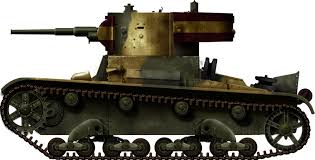
WHAT IS AVFGCE?
I am pleased to announce that the AFVGCE (Armored Fighting Vehicles Guerra Civil Española) blog has gone live. The intention is to form an International Research Group and Association concerning Armoured Fighting Vehicles used in the Spanish Civil War between 1936 and 1939.
However, the primary aim of this group is to build a replica T-26 tank! And maybe more! This may seem a mad idea, but with help and assistance from individuals and groups in Russia, we hope to have plans in the near future that can be used to construct such vehicles here in Spain. In the meantime we are seeking associations with Engineering Colleges in Barcelona to assist in the design and fabrication of such vehicles as a project for students. Individuals with an interest in history, engineering and a general curiosity to help are also welcome. All members will, in time, also be able to ride the T-26 too!
Look up the blog on www.afvgce.wordpress.com
To contact the organisers write to afvgce@gmail.com

MARCH 29th 2016.
The reburial of three International Brigaders found on Hill 238 east of Caspe, held on Saturday 26th of March, 2016 at Caspe cemetery.
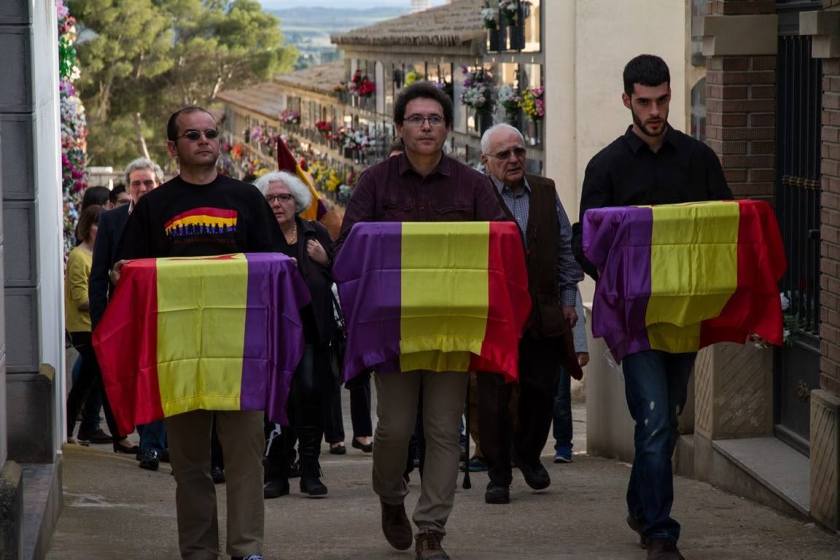



MARCH 26th 2016.

“Spain in our Hearts. Americans in the Spanish Civil War, 1936-1939” by Adam Hochschild. Houghton Mifflin Harcourt, New York, 2016. ISBN 978-0-547-97318-0
JANUARY 11th 2016.
Firstly, may I wish readers a happy New Year! There is a great deal of activity in Spain and Catalonia right now in recovering the Historical Memory.
And have you made a New Year’s Resolution? Mine is to make this blog more active and keep it up to date! For the past year or so, I have been using Facebook to inform people of my activities, but they disappear quite quickly down the page, with other equally exciting posts. Look up my Porta de la Historia FB page and also International Brigades Remembered on FB for up and coming events. There is such a lot going on!
For those curious to meet me, I will be attending the annual Jarama commemoration at Jarama this 20th February. See you then?
NOVEMBER 26th 2015.
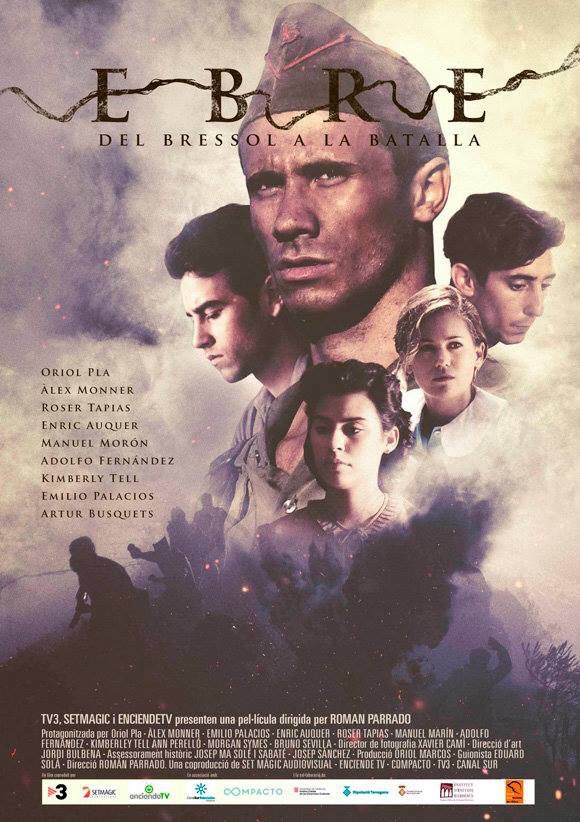
“I’m in this movie!”
Here is the poster for a forthcoming Catalan TV3 film on the Battle of the Ebro and the “Quinta de Biberon”, or “Baby Bottle” recruits of 17 and 18 years of age who were conscripted into the Republican Army in April 1938 to make up the losses from the “Great Retreats” through the Aragon.
The title in English is “Ebro. From the cradle to the Battle”.
The film will be released (with English subtitles) in early 2016. Crowdfunding is now online to add special effects, but to ensure a dvd of the film, please help support the campaign here: http://www.vkm.is/ebrefilm
NOVEMBER 14th 2015.
Apologies for my tardiness in keeping this blog up to date. I am just scared of using Windows 8 and don’t really like it! But that is no excuse
Still, to keep the ball rolling, here is an extract from Bob Clark’s “No Boots to my Feet” and a location on the Ebro that friend Octavio Marches has discovered from reading and fieldwalking the Ebro River near the village.
(The XV Brigade make plans to recross the Ebro at Garcia!)
(From Bob Clark. “No Boots to my Feet”. Student Bookshops, Stoke on Trent. 1984. pp. 89-93)
“A few days later (early April 1938) we were once again on the move and after an all-night drive through mountainous country we were placed in reserve positions on the banks of the Ebro. The next few weeks were busy ones indeed. Miles of trenches were built and numerous pill boxes constructed. It would be a very costly venture if the enemy attempted to cross the river. The machine gun company was detailed to cover the river front near the village of Garcia. Our Battalion had received further reinforcements of Spaniards and a few English newcomers. The position we were holding seemed to consist of a very shallow trench with, at the end of it, an extremely flimsily built machine gun post. It had been constructed in a great hurry and literally perched on the side of the hill that ran right to the water’s edge. What a position! A single salvo from a couple of light field pieces would have blasted it to hell. Still! We had to make the best of it.
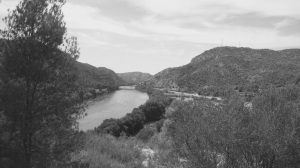 I was once again with my old machine gun crew with dear old Sergeant Cornwallis , but minus Johnny Hall and Barney Shields. They had died in the defence of Belchite. Peering through the slits in the nest gave a splendid view of the river, and the opposite bank. From a grandstand point of view the position was ideal, but the main protection which we had to rely on was half a dozen bags of cement left behind by the builders, along with a few railway lines, some angle irons and a couple of bricks. After peering for a short time, I realised how easy it would be for an enemy scouting party to cross the river in the dark and indulge in a real old-fashioned cutting out expedition. So that night our communication trench, which was almost useless in daylight, was considerably strengthened.
I was once again with my old machine gun crew with dear old Sergeant Cornwallis , but minus Johnny Hall and Barney Shields. They had died in the defence of Belchite. Peering through the slits in the nest gave a splendid view of the river, and the opposite bank. From a grandstand point of view the position was ideal, but the main protection which we had to rely on was half a dozen bags of cement left behind by the builders, along with a few railway lines, some angle irons and a couple of bricks. After peering for a short time, I realised how easy it would be for an enemy scouting party to cross the river in the dark and indulge in a real old-fashioned cutting out expedition. So that night our communication trench, which was almost useless in daylight, was considerably strengthened.
We worked into the early hours of the morning and were well satisfied when daylight came. True! One still had to bend one’s back but it was a damned sight more pleasant then crawling through the slush and debris on your belly. The day was clear and the scene along the river was a peaceful as a day in spring back in the old country. The Ebro was almost placid at this point, but farther along took a tortuous bend out of sight. At this bend stood the village of Garcia, perched precariously on the edge of a huge cliff; some of the houses were actually built over-hanging the river and fishing from the bedroom window was quite feasible.
After being relieved for a few hours, an excursion to the village was decided on to collect any pots or pans or any article which might come in useful. Leaving the communications trench, we followed a narrow path where in places we must have been visible to the Fascists, though only for a few seconds. Sitting down for a breather we noticed that a large valley ran almost to the river’s edge and was completely out of sight of the enemy. The whole of this valley was covered by crops of potatoes and other vegetables. This was a godsend. We visualised chips for supper and maybe Blind Scouse for dinner. The whole world at once took on a brighter hue. We felt as if we were on a picnic.
As we neared the village we had to be sure that we kept well off the skyline in case of enemy snipers. The first building we came to looked like a public hall with elaborate wrought-iron gates and a well-laid out pathway. Being curious, the four of us, our party total, pushed open the door. The place was in complete darkness. As we tried to pierce the gloom, a horrible stench it almost knocked us over. We staggered back into the open-air and decided that someone was dead in the building, but being consumed by curiosity, we held our noses and entered once again. After a minute or two we became used to the gloom and opened the shutters which covered one end of the room. We had entered the public mortuary. A man was laid out on the cold slab and judging by his appearance had lain undisturbed for more than a week. Probably some poor devil who had died naturally, but with the coming of the Fascists had been abandoned where he lay. When he was finally buried we never knew.
Continuing our way, we entered the main street. The village had been abandoned in a hurry. This was evident by the opened doors and flapping shutters. A deathly silence enveloped the place and a queer feeling of awe crept over us. This was a pitifully poor, isolated village that judging by its appearance had been forgotten for centuries. All the houses in the main street were quite substantial and built of heavy blocks of grey stone with plenty of wrought iron-work. Entering one of the houses we found ourselves in a somewhat gloomy room with the remains of an unfinished meal lying on the table. Thick dust covered the furniture pointing to the fact that the late tenants had left quite a time back.
Rummaging in the top rooms we found an old battered gramophone. This was a real find. After a lot of tinkering we soon had the motor running, although at a rather slow speed. We found exactly three records, all Spanish, one of them the aria from the opera, Tosca, the others being Catalan songs of amazing beauty and rhythm.
We now felt that our journey had been well-rewarded and anticipated the look of joy on the faces of the rest of the gun crew when we returned with our musical surprise. In the cellar we were overjoyed to find a number of large barrels of vino. The first barrel was tapped but the wine ran like treacle and was too rich for our palates. However, the smaller barrel contained white wine which to most Britishers was more palatable. Although wine in Spain was unbelievably plentiful, few of the men in the British Battalion ever became partial to it, and most sighed for a good drink of stout or bitter, or better still, a good pint of mild. A good swig of vino before going on guard made up for the lack of an overcoat in many cases.
There was nothing else except for a pile of anarchist magazines liberally covered with art studies which would come in handy to decorate the walls of our machine gun post, so we decided that if we tried another house we might find something in the eating line. Choosing a large house that looked as if it might have been the home of the local alcalde, we entered. What a godsend. There, staring straight at us, was a large rabbit hutch with at least a dozen large bunnies scurrying. Around. How on earth they had done for water puzzled all of us, as the water trough was bone dry. We decided that in the interest of humanity our duty was to kill those rabbits and the thought of boiled rabbit stew almost overpowered us. Dan, a big Canadian lumberjack, who was attached to the British soon had the dozen or so rabbits stretched out cold. He said that years of experience lay behind his appalling swiftness-less than twenty seconds and the hutch was empty.
We were now well loaded and coming out into the bright sunshine we met a Spanish patrol who were on the same errand as ourselves. They were very pleased when we presented them with a couple of rabbits. They admitted being rather unlucky in the food line.
We cached our stores and decided that tobacco must be the main item for our next search. Splitting up, each man commenced to search each building systematically. Choosing an ancient stone building, I pushed against the door and it refused to budge.
Glancing upwards I noticed one of the shutters swinging open. Hunting round to find a ladder did not take long and I soon found myself in a large room covered with dust. This room had not been used for years. It contained huge heavy wooden chairs, massive tables and a bookcase filled with enormous tomes, the largest books I had ever seen. Opening one curiously. I noticed that the date was the sixteenth century. Glancing at a number of the others I found that the youngest was dated 1750, everyone a religious work of some kind or another. A large number of foreign stamps of comparatively modern issues were placed between the leaves of one of the books.
After a. Short time the place made me feel quite morbid, so I was soon once again outside in the sunshine. My pals were really enjoying themselves, for they had found a beehive and were gorging themselves with honey. It was getting late, so shouldering our burdens we commenced the return journey to our post.
What a welcome we received; even Francis Drake, when he returned with the treasures of the Spanish Main, surely could not have received a more boisterous or more sincere welcome than we did with our decrepit gramophone, our nudist pictures, a sack of potatoes and the rabbits. As it was, the enemy across the river resented our exuberance and gave us a few bursts, but nobody minded that. That night the smell of boiling rabbit must have drifted across the Ebro with the strains of “La Tosca” wheezed out from our battered gramophone.
Once or twice the sharp rat-tat of machine gun fire accompanied by loud offensive remarks by Spanish Fascists from the safety of their machine gun posts, was answered by considerably more offensive remarks by the Spaniards on our side of the river. This slanging developed into quite an entertainment, as along this sector loud yells and cat-calls resounded across the waters.
The next morning we had a visit from the Battalion Commissar (Bob Cooney) who seemed rather perturbed at the situation along that sector of the river. It appeared that the Fascists had brought up a loud speaker van in an endeavour to win over the Republicans and indulged in a great deal of bitter attack on the IB, blaming them for the prolongation of the war. This propaganda had very little effect on the Republican troops but was liable to be rather a nuisance as it was quite possible that a general slanging match would develop along the river front, thus playing into the Fascists’ hands by holding up trench digging and fortification.
Before the day was finished the Commissar’s fears were partly justified. Late in the afternoon we heard many of the Spaniards on both sides of the river enquiring about each other’s work in civil life. The conversations ran something like this: “Hola! What province do you come from? What’s your name? Where did you work? Do you remember if Maria so-and-so was all right when you left Malaga or Uncle Cipriano of Zaragoza?” The Fascists entered into the spirit of the thing and information was freely given on the whereabouts of the various relatives in those Fascist towns which they knew, with the remarks of: “Why don’t you come across the river? We have plenty of tobacco, plenty of food to spare. Leave the Internationals and swim across.” This appeal was evidently useless as the Republic cans were quite happy to indulge in conversation on civilian matters, but even though the word, “Tabaco” made many of the IB sight for a smoke aswell as the Spaniards, not a single man was reported missing the next morning. Yet it was dead easy to cross the river, especially near Garcia there was very little current, no moon (30th April 1938) and the river was very thinly held. This interlude in the war vastly encouraged the IB, proving that propaganda had no effect, although discretion was used by the Command while these conversations were on and the machine guns were silent.
The following day we were amazed to see large groups of the enemy come to the water’s edge and commence to wash themselves, some even washing their clothes. In a few minutes small groups of Republicans copied their example and the amazing sight of both sides washing in full view of each other obviously called for some action. A runner was immediately despatched to Headquarters to find out what it was all about. In the meantime we were informed by a Spanish teniente that this was a short, mutually-agreed, truce. We had to stop this but once again discretion had to be used. It was useless to open fire as the enemy could retaliate and a terrible massacre would ensue. This would have an unfortunate effect on the Spanish troops, which would eventually play right i to the Fascistss’ hands. The whole affair reeked of a well-thought out plan by the enemy to discredit the IB.
The Battalion Commissars once again showed their worth by boldly stating the case against fraternisation and eventually all the Republicans left the river bank and resumed their positions in their trenches. In a few hours the whole riverside was deserted. The sound of desultory rifle fire and machine-gun fire brought the front back to normal.
We experienced a very quiet existence for the next week. Every night with the help of half a company of Spaniards, we constructed an excellent reinforced concrete machine-gun post. It was a weird scene as every night in single file men carrying buckets of ready-mixed concrete climbed up the mountainside keeping well below the skyline. In a few nights’ heavy work we almost completed our post. My own opinion of its strength was that it would take a direct hit from a heavy bomb to destroy it. The sides were over two feet thick and the roof was criss-crossed with old railway lines with sheets of steel and concrete on top of that. A communications trench leading to it was over six feet in depth. We had prepared a length of flex with a bell attached with this, along with a couple of armchairs and a small iron bedstead, the man by the gun could take it easy and of danger threatened just pull the bell and his comrades having a nap would soon be along the trench. We firmly believed that this post was an example or the Republican Army to copy, but, unfortunately, we were not able to prove its worth or to enjoy its amenities. The order to pack up and move out was given and our beautiful machine-gun post was abandoned to a new reserve corps who were taking over.”
And here is Bob Clark’s machine gun bunker!
5th May 2015.
I now have a new pc with Windows 8!
Having returned from a whistle stop trip to the Aragon and Ebro Fronts with American Brian Moyer, and having just purchased a new pc with Windows 8, I will have to take a few days to learn how to use it (I have been using forever Windows XP) and add photos to it from my other sources. Lots of new things to report on shortly.
Expect over the next few weeks a more regular input to this page. In the meantime, if you use Facebook, look up Porta de la Historia, myself and the new and exciting BATBIRG (British Anti Tank Battery International Research Group), as we now have a Soviet 45mm on display that is one of only 146 guns of this type sent to Spain by the Soviet Union. Photos later…..
22nd April 2015.
Just a brief explanation. I am trying to use an app. to update this page on my I Pad “in the field” so to speak. However, for some odd reason, since I started using it, I cannot access the main page to update when it was last updated!
I can now update the main page using my old pc, so over the next week or so, I will try and update and rearrange new materiel on this main page.
THE MATERIEL BELOW IS TWO YEARS OLD, BUT STILL OF INTEREST.
30th October 2013.
The Leaving of the International Brigades. 28th October 1938. Seventy five years on….
(designed by Manuel Montero. Gracias!)
Being lucky enough to live in Barcelona I have the unique opportunity to research photographs made during the Spanish Civil War in Spain in the very same locations. The role of photography in propaganda is vitally important in understanding its role and effect on the population not just in Spain but to a World-wide audience too. And in many places they have hardly changed The success that myself and friends also curious on the subject has been impressive, to say the least. But yesterday, on the 75th anniversary of the Leaving of the International Brigades, I deceided to walk the same route and to try and locate some of the shots. I must admit that I was surprised by what I did discover and very happy to observe the faces of two people in what I will call “The Farewell Kiss”. Here are some then and now photos with clips from the film below and timings noted by each one. Please enjoy this humble offering to remember this incredible event and the brigaders who marched in this event.
This film is used and timings are given beside the relevant photos below: http://youtu.be/xtJO_OG2MRk
The actual event took place on the afternoon of Friday 28th October 1938 at 1700. It seems that the actual march was only publicly announced some twenty minutes before it started as there was a fear that the Italian Airforce based in Majorca might attempt to bomb the event. A heavy Republican Airforce presence was in the sky to deter any attack during the Parade as seen in these two photos, with Russian Mosca fighters flying over the Diagonal and people staring up at them.
Edwin Rolfe wrote: “It was the most thrilling sight, we agreed, that we had ev seen. The planes flew overhead, dipping recklessly above the heads of the hundreds of thousands of men, women and children who lined the streets, perched on benches, hanging from balconies and from thr palm trees that lined the avenue. As the Internationals went by, hundreds of girls in native costume rushed forward, kissing them, pressing huge bouquets of flowers into their arms.” (“The Lincoln Battalion” by Edwin Rolfe, p. 307).
The march began in the barrio of Sarria to the south west of the city, and then marched down the Diagonal (then called “Avinguda 14 abril”). The review stand where the political leaders (including Azaña, Negrin, Companys, Ibarruri and Taradellas) saluted the Brigaders, was just before Placa Fransesc Macia (then called Placa Germans Badia, but after the War Plaza Calvo Sotelo!).
Oddly enough, here is photograph of Robert Capa photographing the Parade!
At 1’45” this image appears in the film http://youtu.be/xtJO_OG2MRk:
At 2’18” this image appears:
“The Farewell Kiss”
At 3’02” there is a kiss to one of the Brigaders, and here I include stills of the two people. I was very touched when I froze the film and found their faces. He is a captain, but who is he? And who is she?
This is where the clip was taken on Placa Fransesc Macia. Note the columns, lampost and arched window.
This is the same lampost that the children at 1’45” are hanging on to.
At 3’06 this flag is seen:
And here is the same building on 28th October 1938:
I think that these men are Americans, owing to the black Brigader in their ranks?
Fred Thomas wrote in his diary on 28th October:
“This Parade had better be good! Up at 3am, then to the church (actually Ripoll Cathedral where the brigaders messed) for “coffee” and bread. On the train at 6.30 and departed at twenty minutes to nine. We reached Barcelona at 1 o’clock and were brought to the Lenin Barracks by trucks. At 2 o’clock we have had some food and are now awaiting developments.” Saturday 29th October. ” Yesterday was a day I will never forget. The Parade was, I am sure, an emotional feast for us all. It was no simple march through the streets, but a glorious demonstration of the enthusiasm and affection of the people of Catalonia for the Internationals. Trucks took us through crowded streets, with flags and bunting everywhere. The people were cheering and throwing flowers, crowding every window and balcony. We dismounted finally at the Sarria road , starting point of the procession. There the Brigades of many different nationalities were drawn up nine abreast. Spanish troops lined the route as, led by military bands, we set off. Everywhere thousands packed the broad streets, time after time men and women broke through the cordon to hug and kiss us, holding up small children and babies to be kissed in return, smothering us with affection as they cheered amd cheered. For an hour and a half we made our slow way through some of the principle streets in one long glut of emotional excess. I was not the only Brigader sometimes reduced to tears; we, who were leaving the fight, were yet receiving the heartfelt homage of the Spanish people. In the Street of the 14th of April the March ended, and then came the speeches. From a platform full of important people from many countries as well as the Republic. Dr. Negrin, Prime Minister, addressed us and the vast crowds. Then came President Azaña followed by the Chief of the Army of the Ebro (Rojo). Finally we recognised the spare figure of the indomitable “La Pasionaria” who quickly had the crowd roaring their approval of her every word. But we British were not near enough to hear much, so I have had to wait until today to read her stirring speech; one sentence stands out-“Come back, as honoured Sons of Spain.” Then it was over. As dusk was falling the Parade dispersed. Trucks were parked in nearby streets and we were taken back to the Lenin Barracks to eat.” Thomas’ account raises the question as to the route that the Parade took. It is certain that it passed the Review stand by Placa Ransesc Macia towards the centre of the City, but then seems to have returned to it for the final speeches. This can be confirmed by some of thr photos taken on the day. But here are some photos taken on thr 75th anniversary of the Despedida to compare with the film linked above and some of the photos that were taken on Diagonal. Enjoy!
And finally, here are some photos taken near Placa Fransesc Macia of the Review. Very beautiful pictures to remember the Brigaders 75 years ago marching through the streets of Barcelona.
And I finish this work with a photograph of Austrian Brigader, Hans Landauer in the Parade., who is still alive. My regards to Hans on this special day.
__________________________________________________________________________________________________________________________________________________
28th October 2013.
75th Anniversary of the Despedida of the International Brigades in Barcelona.

La Pasionaria at the Despedida.
Well, today is the 75th anniversary of the Leaving of the International Brigades that took place in Barcelona. I will be walking the same route this morning and later at 1600 attend a commemoration at the IB memorial in Carmel. Bit for now, here is the speech made by La La Pasionaria in Spanish and English aswell as between the two versions a clip of her speaking at an earlier event to get an idea of why she was called “La Pasionaria”!.
Here is the original newsfilm with the Desoedida starting at 0’50″but dubbed in Spanish: http://youtu.be/xtJO_OG2MRk
And here is slightly shortened original English version; http://youtu.be/EZ1bvt4titA
La Pasionaria a la Despedida de las Brigadas Internacionales a Barcelona, 28 octubre 1938. 75 años antes hoy.
Es muy difícil pronunciar unas palabras de despedida dirigidas a los héroes de las Brigadas Internacionales, por lo que son y por lo que representan. Un sentimiento de angustia, de dolor infinito, sube a nuestras gargantas atenazándolas… Angustia por los que se van, soldados del más alto ideal de redención humana, desterrados de su patria, perseguidos por la tiranía de todos los pueblos… Dolor por los que se quedan aquí para siempre, fundiéndose con nuestra tierra y viviendo en lo más hondo de nuestro corazón aureolados por el sentimiento de nuestra eterna gratitud. De todos los pueblos y todas las razas, vinisteis a nosotros como hermanos nuestros, como hijos de la España inmortal, y en los días más duros de nuestra guerra, cuando la capital de la República española se hallaba amenazada, fuisteis vosotros, bravos camaradas de las Brigadas Internacionales, quienes contribuisteis a salvarla con vuestro entusiasmo combativo y vuestro heroísmo y espíritu de sacrificio. Y Jarama y Guadalajara, y Brunete y Belchite, y Levante y el Ebro cantan con estrofas inmortales el valor, la abnegación, la bravura, la disciplina de los hombres de las Brigadas Internacionales. Por primera vez en la historia de las luchas de los pueblos se ha dado el espectáculo, asombroso por su grandeza, de la formación de las Brigadas Internacionales para ayudar a salvar la libertad y la independencia de un país amenazado, de nuestra España. Comunistas, socialistas, anarquistas, republicanos, hombres de distinto color, de ideología diferente, de religiones antagónicas, pero amando todos ellos profundamente la libertad y la justicia, vinieron a ofrecerse a nosotros incondicionalmente. Nos lo daban todo; su juventud o su madurez o su experiencia; su sangre y su vida, sus esperanzas y sus anhelos… Y nada nos pedían. Es decir, sí: querían un puesto en la lucha, anhelaban el honor de morir por nosotros. ¡Banderas de España!… ¡Saludad a tantos héroes, inclinaos ante tantos mártires!… ¡Madres!… ¡Mujeres! Cuando los años pasen y las heridas de la guerra se vayan restañando; cuando el recuerdo de los días dolorosos y sangrientos se esfume en un presente de libertad, de paz y de bienestar; cuando los rencores se vayan atenuando y el orgullo de la patria libre sea igualmente sentido por todos los españoles, hablad a vuestros hijos; habladles de estos hombres de las Brigadas Internacionales. Contadles cómo, atravesando mares y montañas, salvando fronteras erizadas de bayonetas, vigiladas por perros rabiosos deseosos de clavar en ellos sus dientes, llegaron a nuestra patria como cruzados de la libertad, a luchar y a morir por la libertad y la independencia de España, amenazadas por el fascismo alemán e italiano. Lo abandonaron todo: cariños, patria, hogar, fortuna, madre, mujer, hermanos, hijos y vinieron a nosotros a decirnos: «¡Aquí estamos»!, vuestra causa, la causa de España es nuestra misma causa, es la causa de toda la humanidad avanzada y progresiva». Hoy se van; muchos, millares, se quedan teniendo como sudario la tierra de España, el recuerdo saturado de honda emoción de todos los españoles. ¡Camaradas de las Brigadas Internacionales! Razones políticas, razones de Estado, la salud de esa misma causa por la cual vosotros ofrecisteis vuestra sangre con generosidad sin límites os hacen volver a vuestras patrias a unos, a la forzada emigración a otros. Podéis marcharos orgullosos. Sois la historia, sois la leyenda, sois el ejemplo heroico de la solidaridad y de la universalidad de la democracia, frente al espíritu vil y acomodaticios de los que interpretan los principios democráticos mirando hacia las cajas de caudales o hacia las acciones industriales que quieren salvar de todo riesgo. No os olvidaremos, y, cuando el olivo de la paz florezca, entrelazado con los laureles de la victoria de la República española, ¡volved!… Volved a nuestro lado, que aquí encontraréis patria los que no tenéis patria, amigos, los que tenéis que vivir privados de amistad, y todos, todos, el cariño y el agradecimiento de todo el pueblo español, que hoy y mañana gritará con entusiasmo: ¡Vivan los héroes de las Brigadas Internacionales!
Link to an earlier speech by La Pasionaria to get an idea of her voice. http://youtu.be/VaEyv8J2XI8
It is very difficult to say a few words in farewell to the heroes of the International Brigades, because of what they are and what they represent. A feeling of sorrow, an infinite grief catches our throat – sorrow for those who are going away, for the soldiers of the highest ideal of human redemption, exiles from their countries, persecuted by the tyrants of all peoples – grief for those who will stay here forever mingled with the Spanish soil, in the very depth of our heart, hallowed by our feeling of eternal gratitude. From all peoples, from all races, you came to us like brothers, like sons of immortal Spain; and in the hardest days of the war, when the capital of the Spanish Republic was threatened, it was you, gallant comrades of the International Brigades, who helped save the city with your fighting enthusiasm, your heroism and your spirit of sacrifice. – And Jarama and Guadalajara, Brunete and Belchite, Levante and the Ebro, in immortal verses sing of the courage, the sacrifice, the daring, th discipline of the men of the International Brigades. For the first time in the history of the peoples’ struggles, there was the spectacle, breathtaking in its grandeur, of the formation of International Brigades to help save a threatened country’s freedom and independence – the freedom and independence of our Spanish land. Communists, Socialists, Anarchists, Republicans – men of different colors, differing ideology, antagonistic religions — yet all profoundly loving liberty and justice, they came and offered themselves to us unconditionally. They gave us everything — their youth or their maturity; their science or their experience; their blood and their lives; their hopes and aspirations — and they asked us for nothing. But yes, it must be said, they did want a post in battle, they aspired to the honor of dying for us. Banners of Spain! Salute these many heroes! Be lowered to honor so many martyrs! Mothers! Women! When the years pass by and the wounds of war are stanched; when the memory of the sad and bloody days dissipates in a present of liberty, of peace and of wellbeing; when the rancors have died out and pride in a free country is felt equally by all Spaniards, speak to your children. Tell them of these men of the International Brigades. Recount for them how, coming over seas and mountains, crossing frontiers bristling with bayonets, sought by raving dogs thirsting to tear their flesh, these men reached our country as crusaders for freedom, to fight and die for Spain’s liberty and independence threatened by German and Italian fascism. They gave up everything — their loves, their countries, home and fortune, fathers, mothers, wives, brothers, sisters and children — and they came and said to us: “We are here. Your cause, Spain’s cause, is ours. It is the cause of all advanced and progressive mankind.” Today many are departing. Thousands remain, shrouded in Spanish earth, profoundly remembered by all Spaniards. Comrades of the International Brigades: Political reasons, reasons of state, the welfare of that very cause for which you offered your blood with boundless generosity, are sending you back, some to your own countries and others to forced exile. You can go proudly. You are history. You are legend. You are the heroic example of democracy’s solidarity and universality in the face of the vile and accommodating spirit of those who interpret democratic principles with their eyes on hoards of wealth or corporate shares which they want to safeguard from all risk. We shall not forget you; and, when the olive tree of peace is in flower, entwined with the victory laurels of the Republic of Spain — return! Return to our side for here you will find a homeland — those who have no country or friends, who must live deprived of friendship — all, all will have the affection and gratitude of the Spanish people who today and tomorrow will shout with enthusiasm — Long live the heroes of the International Brigades!
Milton Wolff and La Pasionaria after the Parade.
Finally a flag that Miles Tomalin brought back from the Parade:
____________________________________________________________________________________________________________________________________________________
Tom Mann Centuria Banner returns to the Karl Marx Barracks! It was with great pleasure that members of the Calrion Cycling Club came to the old Karl Marx Barracks in Barcelona, now Universitat Pompeu Fabra, to place their beautiful copy of the Tom Mann Centuria banner in almost the same position in one of four possible corners (there are two blocks, each with two similar corners, so we hope we got the right one! Anyway, here are the photos of the barracks, then and now. Here is the main square in 1936: 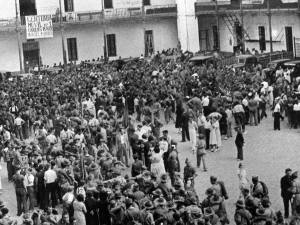 And here is the same view today:
And here is the same view today:  Here is the original photo of the Tom Mann Centuria banner with, from left to right, Sid Avner, Nat Cohen, Ramona (later Nat’s wife), Tom Wintringham, George Tioli, Jack “Blue” Barry (aka Sampson) and David Marshall.
Here is the original photo of the Tom Mann Centuria banner with, from left to right, Sid Avner, Nat Cohen, Ramona (later Nat’s wife), Tom Wintringham, George Tioli, Jack “Blue” Barry (aka Sampson) and David Marshall.  Here is the shot of the Clarion Cyclists and their banner in almost the same spot:
Here is the shot of the Clarion Cyclists and their banner in almost the same spot: 
 But I made a bish with the perspective and really the flag should have been further forward at this position: But it was close!
But I made a bish with the perspective and really the flag should have been further forward at this position: But it was close! 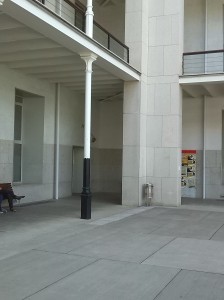 Many thanks to Lucia Conte of Universitat Pompeu Fabra for allowing us permission to recreate this iconical photograph in the same location. And also many thanks to the Clarion Cycling Club for coming to the location after their 800km cycle ride from London to Barcelona, which they only finished that morning at the International Brigade memorial in Carmel! Thank you all!
Many thanks to Lucia Conte of Universitat Pompeu Fabra for allowing us permission to recreate this iconical photograph in the same location. And also many thanks to the Clarion Cycling Club for coming to the location after their 800km cycle ride from London to Barcelona, which they only finished that morning at the International Brigade memorial in Carmel! Thank you all!
_________________________________________________________________________________________________________________________________________
22nd October, 2013
Lots of News!
Firstly my apologies for not keeping this blog up to date. Since the unveiling of the British battalion Last Stand plaque in Corbera last September 24th, preparations are in hand for the 75th Anniversary of the Leaving of the International Brigades on October 28th 1938.
But here are some news items of interest.
Last Stand of the XV Brigada Mixta (formerly XV Brigada Internacionale) at La Fatarella 23rd and 24th November 2013.
Here is the programme in English:
International Conference on the 75th anniversary of the Final Battle of the Ebro at La Fatarella, 23rd and 24th November, 2013
Sunday 23rd November.
11: 00-International Congress “The Recovery and Presentation of the Heritage of the Spanish Civil War”
“Archaeology of the Battlefields. Excavations at Fatarella”. University of Barcelona. 18: 00 Visit to the Exhibition of the Last Battle of the Ebro by Associacio Lo Riu. Sunday November 24th. Visit to the fortifications above La Fatarella 10: 00 Militaria Fair Guided tours with a 4 x 4 of the route of the Final Battle of the Ebro 12: 00 Inauguration of the plaque to the XV International Brigade/Brigada Mixta (with the family of Generals Vicente Rojo, Mateo Merino and Antonio Cordon) Laying of flowers in the trenches where “Charley”was discovered in September 2011 (see http://digital.csic.es/bitstream/10261/47780/1/2012_Informe%20La%20Fatarella%202011_Gonzalez.pdf) 12: 30 Recreation of the Final Battle in the trenches where “Charley”was discovered. 13: 30 h Popular Lunch in the Sports Hall of La Fatarella For further information contact Juan Sambro on loriuassociacio@gmail.com For further information on accommodation in the area contact Alan Warren on pdlhistoria@gmail.com
Here is a photo of the plaque being finished. It looks beautiful!
And here is “Charley”, one of the last defenders of this trench system who will be remembered on November 24th.
__________________________________________________________________________________________________________________________________________________
Event at Corbera de l’Ebre 1st and 2nd November
This reenactment will occur on Hill 402, the Estado Mayor of the 35th Division that had the XI, XIII and XV International Brigades. More trenches have been excavated and will be opened.
__________________________________________________________________________________________________________________________________________________
New book out on the Life of Georges Kopp, George Orwell’s commander in Spain.
Here is a review I wrote on a new book which has just been released. A very useful addition to the Orwell corpus and I highly recommend it.
“Most nurses are brunettes.”
“George Orwell’s Commander in Spain. The Enigma of Georges Kopp” by Marc Wildemeersch. With an Epilogue by Professor Peter Davison. Published October 28th, 2013 by Thames River Press (http://www.thamesriverpress.com/Book/1543/10045/George-Orwells-Commander-in-Spain.html). Price £8.99 paperback or £2.99 as an e book from selected retailers. Having just received a copy of the above book, it gives me great pleasure to write a short review of Marc Wildemeersch’s offering on the life of the enigmatic Georges Kopp. This book was originally published in Belgium under the title “De man die Belg wilde worden. Georges Kopp. Commandant van George Orwell” in 2010 by Uitgeverij In de Knipscheer in Dutch. Though a relatively slim illustrated biography of 144 pages, Marc has now produced an expanded version for an English speaking audience. The waiting has been interminable for Orwell enthusiasts, but the result is a charming and fascinating explanation of the thrilling but often confusing life of the character that appears in George Orwell’s compelling account of his experiences in Spain during the Spanish Civil War in “Homage to Catalonia”, aswell as his adventures during World War Two and post War. Though extensive research in various Archives in Europe, interviewing surviving family relatives of Georges Kopp, especially his son Quentin Kopp, committee member of the recently formed Orwell Society (http://www.orwellsociety.com/), aswell as visiting many of the places where Georges fought and lived, Marc has constructed what is to all intents and purposes the most complete biography so far of this man. Whilst almost seeming to be a “Walter Mitty” type character, Georges was often prone to constructing various stories about his life, but to save his own skin or to impress those around him? Marc has been able to uncover the details of Georges’ fascinating but also tragic life. A womaniser, a teller of tall tales, an inventor before his time, a fraud, a spy or even double agent but also a a person of great intelligence and wit. However, ultimately unable to achieve financial securty, his life ended in a small hotel in France in the early 1950s. Mention Orwell and “Homage to Catalonia” and one of the main characters that is also remembered by readers is Kopp. An almost ghostly figure in the background, but the Orwells’ attampts to save his life in Barcelona in June 1937 are incredible to read. How was he able to survive? Marc also explores the various accounts to try and understand, amongst other matters, the relationship between Eileen Blair and Georges Kopp. Nothing new here. However, Hugh Hudson’s proposed film adaptation of “Homage to Catalonia” with Colin Firth as Orwell and Kevin Spacey as Kopp, plays on this matter, which may be at odds as to what Marc proposes. Whether “Homage to Catalonia” will ever appear on the big screen is another matter, but I believe that Marc’s new book is worthy of reading if only to be aware of how films can sometimes change from the books they are based on. but this book explains and uncovers the mysterious Georges Kopp not just to those who are fascinated by the Spanish Civil War and its detail, but for those who are aware of the current Orwellian memes of “Big Brother” or “Room 101” in order to gain a brief understanding of the life and times of this fascinating man in the tormentuous events of this early part of the Twentieth Century in Spain and later across Europe. I heartily recommend this book to those who wish to know more about the actual life of George Orwell’s commander, Georges Kopp. Belgian or Russian? Former Belgian Army Reserve officer or story teller? Maker of explosives for the Spanish Republic or Double agent? But also for those curious enough to read this book in order to try to understand succinctly the conflicts, chicanery and double dealings in 1930 and 1940s Europe though the enigma of Georges Kopp, George Orwell’s Commander in Spain. Author Marc Wildemeersch and Quentin Kopp will be releasing and signing copies of the book at Bookmarks, 1 Bloomsbury Street, London, WC1A 1AW at 1830 on Monday 28th October. Entry £2, but redeemable on purchases of the book. (http://www.thamesriverpress.com/news/112/Book-Launch-George-Orwells-Commander-in-Spain.html). __________________________________________________________________________________________________________________________________________________
Mac Paps and Tom Mooney Machine Gun Company in action at Alcaniz last weekend!
Here are some photos taken at Alcaniz with the American Tom Mooney Machine Gun Company and the Canadian Mackenzie Papineau battalion. I think the Major Attlee Company now needs to be formed. Watch this space!
I was very taken by this photo. It seems as if it was taken only seconds later as this photo by Robert Capa!
This one too reminded me of another Capa photo. I cannot find it, but below is the photo on the cover of this well illustrated book by Skoutelsky and Lefebre.
And this one below reminded me of a quote from “Men in Battle” by Alvah Bessie.
“It was an edifying sight to watch the dung beetles rolling your manure away, laying their eggs in it. A beetle with a ball of dung about three-quarters of an inch in circumference would be attacked by a beetle without a ball. You could feel that even in so small a way you were contributing to the balance and economy of nature. You could again contemplate, but for not long, your death in action. But you could not contemplate it with equanimity. You could wonder about your kids, and take out of your pocket the first letter the older had written, dictated to his mother and hand-illustrated. Delivered on a mountain-top in Spain, almost 4,000 miles from home, it was shattering; it killed you with excitement and with longing.” (Alvah Bessie. “Men in Battle”. p.91).
Here are some others. All Alcaniz photos by Joan Queral Tapias. Thank you Joan!
This one is also a bit “Capa esque”!
__________________________________________________________________________________________________________________________________________________
An ambulance similar to James Neugass ambulance is up for sale in Spain for $4000!
Here is a photo of a converted 1937 ambulance very similar to the one driven by James Neugass. It was later converted to carry seated passengers, so the roof and sides have been altered, but it is a Chevrolet and very similar.
And below is a photo of James Neugass (left),, author of the excellent book “War is Beautiful”, with his ambulance nicknamed “Josephine”.
James writes.
__________________________________________________________________________________________________________________________________________________
Unveiling of the British Battalion Last Stand plaque at Corbera.
Duncan Longstaff organised an intensive and excellent visit for IBMT members which I am sure will be remembered for a long time to come! Here are some photos of the plaque and some videos done by a Catalan friend. I am sadly wittering way in Catalan in one of them, but you can avoid that one if you wish!
Thanks to Almudena Cros for providing powerful translations into Spanish of some of the speeches. It was a very emotional event for many of those attending. Thank you to Duncan and Almudena for all their hard work.
The plaque to the right of Corbera church facing the Last Stand position in the far distance
The flowers left at the Last Stand position.
Members of the IBMT group after placing of the flowers at the position of the Last Stand of the British Battalion
Here are some videos of the event and speeches in Corbera Church. Be careful as I am in the first one!
_________________________________________________________________________________________________________________________________________________________________
12th September 2013. CROWDFUNDING FOR “WAR IS BEAUTIFUL” DOCUMENTARY HAS BEGUN! OK. We have started our crowdfunding application and have 55 days to try and raise $6,000 to make the documentary a reality. This link takes you to information in Spanish and English about the film aswell as a link to the Crowdfunding website. If you can assist us we would be most grateful, and if not, please pass this link on to your friends. Thanks. http://www.warisbeautifuldocumentary.com/
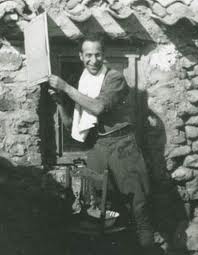 Here is a link to the English trailer: https://www.youtube.com/watch?v=WK2GH9U2lBQ I aqui el trailer en español: https://www.youtube.com/watch?v=ZfPZerjH0p0
Here is a link to the English trailer: https://www.youtube.com/watch?v=WK2GH9U2lBQ I aqui el trailer en español: https://www.youtube.com/watch?v=ZfPZerjH0p0  The book can be purchased in English at http://thenewpress.com/index.php?option=com_title&task=view_title&metaproductid=1756
The book can be purchased in English at http://thenewpress.com/index.php?option=com_title&task=view_title&metaproductid=1756  and in Spanish at http://www.globalrhythmpress.com/es/libros-151010100311000000/papel-de-liar/la-guerra-es-bella.html ____________________________________________________________________________________________________________________________________________________
and in Spanish at http://www.globalrhythmpress.com/es/libros-151010100311000000/papel-de-liar/la-guerra-es-bella.html ____________________________________________________________________________________________________________________________________________________
6th August, 2013.
Bits and Bobs….
Well, this Saturday we are off to New York, and I have been kindly allowed four days to work on the International Brigades Moscow Archives that are held in the Tamiment Collection. I have received some materiel through friends, and now I am being given the opportunity to delve deeper! Wish me luck and hopefully more knowledge can be offered about the International Brigade’s time here in Spain.
I am not sure if I will add things to the blog whilst there, but to keep you going over the three weeks I am away (I return on 27th August) I attach some links to relevant items.
The Battle of the Ebro re enactment at Fayon, 27th July 2013.
Sargento “Bunny” Warren with Jordi, whose grandfather was a Quinta de Biberon in the 227BM, and teniente Oriol Miró Serra at Fayon, 27th July 2013.
As you can see below, I had a wonderful time at Fayon with Miquel Farragut’s re enactors from Ejercito de l’Ebre. I attach some videos of what went on there for your entertainment.
The first one is a local tv news report and the second is an amusing montage of black and white film with a 1938 “News from Spain” introduction. I like the second one a lot. So, please enjoy!
http://www.youtube.com/watch?v=dajf6djQn68&feature=youtube_gdata_player
Here is the “Noticias de Guerra” pastiche.
http://www.youtube.com/watch?v=97Ijv53Btoo&feature=youtube_gdata_player
Nice black and white film. I especially like the Moor pinching the pistol from the prone cameraman in the final scene!
http://www.youtube.com/watch?v=JhHcRbi7c-Y&feature=youtu.be
Here is Dr Jordi Jara, a surgeon in real life, and his Hospital de Campana at the Living History site!
http://www.youtube.com/watch?v=bXzMLhERvNA
And here is a “Making of” video. The title in English is “We’re dead!”
http://www.youtube.com/watch?v=wSP5S_HZAco&feature=youtu.be
STOP PRESS!
“SPAIN IN FLAMES” FICTION FEATURE FILM ON OLIVER LAW.!
Finally, here is a link to a forthcoming Spanish production concentrating on Oliver Law and the Abraham Lincoln Brigade called “Spain in Flames”. Produced by Cibeles Productions in Spain for an American market, I look forward to seeing this production when it appears. The video looks fun. Enjoy!
http://www.produccionescibeles.com/en/movies/spain-in-flames.html
___________________________________________________________________________________________________
1st August, 2013
Seventy fifth Anniversary Ebro Commemorations.
Please excuse me for not adding more to this blog, but I had to prepare not just for the Ebro events, but also to help a Danish film crew. Lots of fun, and here are some photos and descriptions.
Fayon Ebro re enactment., 27th July 2013.
To cap it all, I was recruited to join the ranks last Saturday, and here I am with two fellow soldiers at the Fayon re enactment. I blame the sun! But it was great fun too!
Sargento “Bunny” Watren, with Jordi, whose grandfather was a Quinto de Biberon in the 227BM and teniente Oriol Miró Serra.
Here are some links to the Field Hospital
http://www.youtube.com/watch?v=bXzMLhERvNA&feature=youtube_gdata_player
and a montage of Laya Films “News from Spain” and acts from the event. Enjoy!
http://www.youtube.com/watch?v=97Ijv53Btoo&feature=youtube_gdata_player
The Lincoln Washington “Death Valley” position, 27th to 31st July, 1938.
On the 27th July I also took flowers to the “Death Valley” position of the Lincoln Washingtons
Looking from Cuatro Camins down into “Death Valley”
To the left the Lincoln Washington positions and to the right the enemy positions.
Alvah Bessie writes the following description which has enabled us to identify the following battalion position as to the north of “Death Valley” leading south towards the Corbera road.. “To your left was a low wooded ridge, and the Fascists were dug in on a jill beyond, about six hundred metres away. Directly ahead there was a small wooded island in the vine field, where we had a couple machine gun nests under George Cady (who took over when Jack (Hoshooley) was hit) and Nat Gross, with Scarlettos, the red eyed Greek (later killed , shot in the throat, according to Bessie), as one gunner and an eighteen year old boy named Charlie Bartolotta as the other.
Costa Scarloetas
They were alone in the middle of the field, with the enemy on three sides of them. On your right was another wooded hill, and somewhere farther to the right were the lines of the 3d Division (all Spanish), that faced Villalba (dels Arcs) and the church tower from which a Fascist machine gunner was doing effective work.”
Here is the “small wooded island” described by Bessie. It is “Punta Targa” by the Cuatro Camins, south of Vilalba dels Arcs, and oddly enough also has the same altitude of 481 metres as the British objective of Hill 481! This now has a monument to the Catalan Carlist Nuestra Senyora de Montserrat Tercio who a few days later were ordered to attack this hill from a similar hill to the north west. They were not given tank, armour or artillery support and they were slaughtered, it being said that they were sent forward drunk, knowing that a successful assault was impossible. Names of the Catalans who died here are on small stones leading from their hill to the hill which the Americans were earlier holding, a distance of a couple of hundred yards. I have taken Catalans here to show them this memorial to Catalans fighting on the other side in this Civil War and some have just cried. I hope that these flowers are a small recognition that both sides suffered in this Battle. Here are some dramatic action shots of the fighting on the ridge running south. Sadly, an underwater irrigation canal was built down the ridge occupied by the Lincoln Washington battalion positions and it is not easy to identify any of these photos, but this is “Death Valley”. I also attach a photo of Nicholas Kurculiotis (taken in the same place as the famous photo of Bessie at Darmos in April 1938) as Bessie writes of him as follows: “”Kurculiotis;got it right between the eyes, leading his squad-” he waved his arm to the left, indicating the general direction of the body.
Normie Berkowitz wounded.
Later Bessie writes: “Running to position I had passed Kurculiotis; I smelled him before I saw him, and I knew him from the uniform, for it would have been impossible to identify him otherwise. Lying there in the beating sun, hiscsmells came to me and sickened me, and I applied myself to the job of doing a little sniping with Pavlov’s Czech mauser.”
Nicholas Kurkulotis, Darmos, April 1938.
______________________________________________________________________________________________________________________________________________________
Hill 481, seventy five years on. 26th July 2013
“The Pimple”
Interestingly, between the the main line of attack, from where these photos were taken, in dead ground to the left, there are two ruined buildings. there is a reference to the British dead being buried at night close to a building below Hill 481, and I think that they may be buried by one of these buildings?
“It was in the fight against a key hill, protecting Gandesa, that the British fought their toughest action and by their gallantry won the title of Shock Battalion. This high fortified hill, officially known as Hill 481, was called by the men, the Pimple; and great was their sorrow that they did not succeed in busting the Pimple. (“Britons in Spain” by Bill Rust, p. 177).
Today, 26th July, I went up to Hill 481 to leave some flowers to the British battalion who began their attack here 75 years ago to the day. I have only added Bill Rust’s comment above as there are many memories to be told of this place. We spent time remembering the horrors that occurred here, and the bravery too, and also thought of those buried near here. There are too many names to list here, and I would recommend reading either Richard Baxell’s “Unlikely Warriors” or John Wainwright’s “The Last to Fall” as starting materiel, but there are many others. Please remember them today as we did. I will just finish with two messages written by Lewis Clive of No. 1 Company during this fighting shortly before he was killed: “Time 1015. Your message just received. You seem to visualise this Company giving covering-fire only, while the message also just received from Battalion gives irders to advance, taking advantage of artillery barrage. Assume the latter to be correct and will look out for opportunity to advance. Please let me know if I have not understood position correctly. Lewis Clive.” “Time 1615. I had orders some time ago to contact you re assault. The runner I sent has not returned. Our position was then, and is now: we are 150 metres from 481 and cannot advance further without coming into fire from both 481 and crossfire from our left flanks. Understand that some of your men were within 15 metres of 481. Have you further plan? L. Clive.”
Here is a well known photograph of British battalion officers on Hill 481:
And about 100 yards behind the main line I found this scene, which looks very similar to the photo above. The trees may be too young, but I am asking nature experts if the tree might just be the same tree as the one that sam Wild is leaning against? What do you think?
I also placed flowers at Hill 403 where the Mackenzie Papineau battalion supported the British attack on Hill 481 to the north, aswell as trying to attack Hill 382, just to the east of Gandesa.
Flowers for the Mackenzie Papineau batalion who held Hill 493 east of Gandesa. There was just open ground between this hill and then town seventy five years ago.
__________________________________________________________________________________________________________________________________________________
Quinta de Biberons Final Reunion on Hill 705, 25th July 2013.
Here are some photos of the final Reunion of the “Baby Bottle” troops who were conscripted into the Reublican army in April 1938 to make up losses caused by the Great Retreats.
Pere Godall, President of the Quinta de Biberons
Three serving Mossos d’Esquadra in the uniforms of the same unit from 1938 as an Honour Guard.
The fifteen survivors present at the event.
A video of the event with a Catalan explaining some of the British names on the memorial on Hill 705 to the dead of the British Battalion. Quite moving. My friend, Joan Guasch appears at the end. He was part of the 31BM of the 3rd Division and lost a leg on the Ebro. He remembers that out of his company, when he was wounded on September 3rd, there were only three original members of the company left.
http://www.youtube.com/watch?v=0dXZhqjZ7T8&feature=youtube_gdata_player
__________________________________________________________________________________________________________________________________________________________________
The crossing of the Ebro seventy five years ago. 25th July, 1938 -25th July 2013.
Crossing of the Ebro by the XV Brigade, 25th July 1938.
Compare the cliff to the left. The water level is now much higher.
In 2005 a group of IBMT members joined the family of Irish Brigader Michael O’Riordan to lay some of his ashes in the River Ebro. Some time before, Angela Jackson and I finally located a quiet and peaceful spot near Asco which could accept a coach and a large number of people. The event was well attended with over 100 people, and Michael got a good send off. The rest of the weekend explored various sites where the XV Brigade fought and a great time was had by all.
Note the twelve carnations on the barge to represent each of the four battalions of the three Brigades of the 35th Divivion, the XIIII and XV Brigades crossed here.
Soon after this event, I decided to try and identify the many photographs taken by Harry Randall of the XV Brigade Photographic Unit of the crossing on the 25th July 1938, and realising that it might be a good idea to start at the place where Michael O’Riordan’s ashes were scattered, I decided to start there.
Ventura Leris laying flowers for the XIII Brigade
Now, I am not sure if there are benign forces at work here, but I do believe that synchronicity does help me greatly in my field of research. And in this case I was not to be disappointed! The second photo that I looked at immediately identified the spot as being the same spot that July day! Here are some “then and now photos” to compare. The study of the standard texts on the XV International Brigade are also a source of fascination. Often, certain pieces of information are repeated from earlier sources and soon become hard truth. For instance, the British battalion histories state that the Last Stand of the Battalion on September 23rd 1938 took place near “Sandesco”. But no such place exists! And it is only now that this point is being challenged by authors such a John Wainwright in “The Last to Fall” and more recently by Richard Baxell in his excellent study of the British in the Spanish Civil War, “Unlikely Warriors”. Many sources concerning the crossing of the Ebro on 25th July 1938 also state that the International Brigades crossed in the early hours of the morning in darkness, but as you can see in these photographs, it is broad daylight. The XIV International Brigade of the 45th Division certainly crossed in darkness near Amposta and were subsequently slaughtered come daylight. However, the sequence for thr crossing of the 35th Division with the XI, XIII and XV Brigade is clear from the excellent “La Batalla del Ebro. Maniobres d’una Division” by Julian Henriquez Caubin (Silente Ediciones) . At daybreak, after arguments with the start time with the command of the XIII Brigade and Chief of Staff Hugh Slater, according to Percy Ludwig, he fired his pistol into the air to start the crossing. The XIII Brigade crossed followed at about 1000am first by the Mackenzie Papineau battalion of the XV Brigade and then the Lincoln Washington, Spanish and British Battalions. The XI Brigade crossed further north in front of Asco close to the modern bridge (only a ferry was there in 1938). The Mac Paps moved north to assist the XI Brigade to clean out Asco and then the Lincoln Washington and Spanish battalions advanced through the town and up the road towards La Fatarella and “Death Valley” near Cuarto Camins. The Mac Paps and British battalion then split from the XV Brigade and followed the XIII Brigade south towards Corbera and the bloodbath of Hill 481 south east of Gandesa.
XI Brigade crossing point near Asco, with flowers to represent each of its battalions in the water.
Note the large building in both photographs
This is just to explain where and at what time the International Brigades crossed the Ebro on 25th July 1938. And I attach a photo of some of the carnations that I placed in the River Ebro at approsimately the same time as the Brigades crossed exactly seventy five years ago. Slowly but surely, by studying the landscape and comparing the various accounts new and exciting discoveries are being made here. I feel very privileged to be able to do this work. Subsequently, the ashes of Moe Fishman and Jack Shafran have also been scattered here too. It is a beautiful and peaceful place to remember this important event. And if anyone wishes to visit the crossing point of the XIII and XV Brigade just drive up from Mora de la Nova towards Asco on the north bank by the River Ebro. Pass Garcia and as the narrow gorge opens iin fromt of you there will be the cooling tower of the Asco Nuclear Power Station and then to the left a sign saying “Embarcador”. Turn left down to the picnic area and walk down to the barge moored there. Car access is easy and safe. Compare the photos here (especially the photo of the cliff seen below which was the key to identifying the location), imagine the river level as much lower then and remember these brave men who crossed here seventy five years ago. And finally, here is just one description of the crossing and subsequent advance towards Gandesa written by Alvah Bessie from his “Spanish Civil War Notebooks”, University Press of Kentucky, 2002. “July 24: (midnight)–July 25: Moved out and down to the Ebro. Crossed under combined fire of artillery, air bombs and strafing, early in the morning of the 25th. Relatively little resistance by en emy, who retreated inland fast. 13th Brigade was first to cross. As we were crossing in boats, a catwalk bridge of barrels and planks was being thrown across. First experience of air bombs and strafing; awful feeling; alleviated considerably if you fire at the plane instead of just lying on your face. Terrific march in dreadful heat — all morning till 2 p.m., constant avion warning. Made camp on top of hill. Sent out with peloton later, as observation patrol to contact 3rd Division across valley. Could not, but contacted 11th Brigade. Enemy aviation very active, bomb- ing our bridgehead & points they thought we had troop concentrations on the other shore of the Ebro. Terrific loads of bombs dropped. Our AA hit one plane, forced it down. From what can be gathered now, our advance toward Gandesa is progressing well, with practically no resistance being encountered. That, I should say, will come later when the fascists have gathered their material for a counterattack. Last night we took up position along extended line atop high hill, facing SW. The Ebro is behind us. Mora de Ebro is supposed to have been taken by us. No food has come up yet, as we probably haven’t a bridge big enough thrown over. (July 26). Slept last night in straw, in stone barn; dead tired, hungry, wet with perspiration. July 26: Advanced toward Gandesa; advance halted to capture two companies of fascists who had broken through our lines at Mora. We had taken (La) Fatarella, early morning (4 a.m.), taking much food, chocolate, cookies, canned fish, tobacco). Brief skirmish with fascists who killed Loyalist armored car driver, surrendered. A ragged, dirty crew, mostly very young — tired, thirsty. Had tobacco, which they gave freely. Much avion overhead. Hung around a couple hours. Advanced toward Gandesa, camping for night in open field; cold. Late at night rifles started firing. Cde. of Co. 4 wounded, others. Seems that a guard thought a tree was advancing on him, opened fire. Hot fire — our own men firing on each other. Couple wounded.”
_______________________________________________________________________________________________________________________________________________________________
20th June 2013.
“La Guerra es Bella/War is Beautiful” by James Neugass documentary trailer.
Last July I had the pleasure of taking James Neugass’ son, Jim, on a journey to the places that his Father describes in his lost diaries recently discovered by Peter Glazer and Peter Carroll, and subsequently published in 2008. The places are still there and we were able to visit many places that have hardly changed in over 75 years. http://www.warisbeautifuldocumentary.com/ So it is with slight embarrassment, but also with great pleasure that I am putting up a link to the trailer of the forthcoming documentary of the journey of James Neugass’ son to discover the Father he hardly knew. Due to be released at the forthcoming International Brigade Conference in Barcelona 28th and 29th October 2013, we hope that readers can support the production of the documentary by using crowdfunding, to enable this hidden history to speak to future generations.The crowdfunding project will start in the next week or so and we hope that readers will be kind enough to support this work. Please keep your eyes open for developments. Notification will be put on this site aswell as www.pdlhistoria.wordpress.com 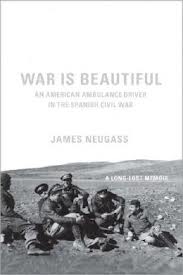 The book can be purchased in English at http://thenewpress.com/index.php?option=com_title&task=view_title&metaproductid=1756
The book can be purchased in English at http://thenewpress.com/index.php?option=com_title&task=view_title&metaproductid=1756 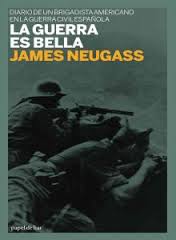 and in Spanish at http://www.globalrhythmpress.com/es/libros-151010100311000000/papel-de-liar/la-guerra-es-bella.html
and in Spanish at http://www.globalrhythmpress.com/es/libros-151010100311000000/papel-de-liar/la-guerra-es-bella.html
_______________________________________________________________________________________________________
7th June 2013
Madrid University City Monument to the International Brigades ordered to be taken down by Madrid Court.
NOTE: I WILL ADD NEWS REPORTS BELOW THIS REPORT AS I DISCOVER THEM.
It is with great sadness that I understand that the International Brigade Memorial in University City in Madrid has been ordered to be removed by a Court by the reason that it did not apply correctly for planning permission. There are, of course, other reasons for this, but I wanted to make people aware of the situation. It is summarised in Spanish here on the AABI website: http://www.brigadasinternacionales.org
There is also a petition to sign asking for a review of the decision, and I hope that as many people can give their support to the petition. It can be found here:
I hope that you can give your support to this.
Thank you.
UPDATE: As of 7th June 2013 at 1232, 6,751 people have signed the above petition, but at least 15,000 signatures are now needed. If you haven’t already done so, please consider signing.
Giles Tremlett, author of “Ghosts of Spain” (well worth reading if you want to try and understand Spain) wrote this for the Guardian today, 6/6/13.
http://www.guardian.co.uk/world/2013/jun/05/spanish-civil-war-monument-court
Another article in the Guardian from 6/6/13 by my good friend and fellow SCW freakie, David Mathieson. What is of interest is that this article has a Comments section if you wish to add something constructive?
A Catalan article 7/6/13
Oh yes. as an aside, the photo with the article by Giles Tremlett has supplied a name for my work.
Here is the photo:
This photo was taken as one of a series of the survivors of the British battalion taken in Darmos on September 24th 1938. Kneeling left to right are Sam Wild , Battalion commanderand “Hookey” Walker, the battalion quartermaster. Standing left to right is firstly a man I have been trying to identify for a long time. He appears in many shots and film. But I have yet to find his name! The others are to the right of this man, are Bob Cooney, Alan Gilchrist,, Bobby Walker and an unknown brigader. But I noted that the photo accompanying the article was courtesy of Benny Goldman who also served in the British battalion. I therefore believe that the man standing next to Bob Cooney on the left is none other than Benny Goldman! I am very happy, but wait for confirmation from his family. Another piece of this huge puzzle joined! And for the record, here are the two other photos taken at the same time and place: 

In the Placa de Llibertat. Left to right: Hooky Walker, Allan Gilchrist, Bob Cooney, George Fletcher, unknown,
Sam Wild, unknown, Johnny Powers and Bobby Walker
And finally. the film below is of the return of the British battalion to England on 7th December 1938. See if you can spot the man who I think is Benny Goldman in this film. There is also a section with him and also the Clement Attlee flag on display taken also at Darmos around April 10th 1938. I was surprised to also see Harry Pollit addressing the battalion. The shot is often atributed to August 1938, but I now believe that it was also taken at Darmos when he visited the battalion after the Great retreats on 14th April 1938 in a surprise visit. Enjoy! http://www.youtube.com/watch?v=LhFON5OjG7k&feature=youtube_gdata_player ___________________________________________________________________________________________________
5th June 2013. TWO TRIPS EITHER SIDE OF THE IBMT LAST STAND COMMEMORATION OFFERED:
A VISIT TO TERUEL, THE GREAT RETREATS AND FIGUERAS AND RIPOLL.
I have had my arm twisted by Americans keen to make best use of their time here in Spain while taking part in the IBMT organised Last Stand event between September 20th and 24th. With this in mind I offer the following two trips either side of the event:
Travellers visiting Spain for the September IBMT event commemorating the Last Stand of the XV International Brigade, 20th to 24th September 2013 may be interested in further travel on either end of the IBMT trip.
With this in mind, I would be happy to offer two possible trips for those wishing to take part: . 1. Teruel and the Aragon Front. A Frozen Hell and a Bloody Retreat. 16th to 20th September. Leave Monday 16th September from Barcelona to Teruel and then to Segura de los Banos, Aguaviva, Quinto, Belchite and the Great Retreats. James Neugass “War is Beautiful” would be used. The group would arrive at Cambrils on the afternoon/evening of the 20th September to take part in the IBMT event. Monday, 16th September. Drive to Teruel via Benicassim hospital. Sleep in Teruel. Tuesday, 17th September. Explore the Battle of Teruel. Sleep in Teruel. Wednesday, 18th September. Visit Cuevas Labradas, Segura de los Banos, Muniesa and sleep in Fuendetodos (birthplace of Goya). Possible visit to the Museum devoted to Goya and his birthplace. Thursday, 19th September. Follow the Great Retreats from Belchite via Hijar to Caspe. Possibly visit Quinto and Fuentes de Ebro if desired. Sleep in Caspe. Friday, 20th September. Visit the locations around Batea of the final part of the Great Retreats where Merriman and Doran disappeared and discuss new evidence being discovered. In the evening drive to Cambrils to join with the IBMT Group. 21st to 24th September. IBMT event to commemorate the Last Day of the International Brigades in combat.(I will be offering a more energetic and exciting trip for those keen to explore Hill 481, Hill 666 etc. See beloe)Depending on what is planned for Monday September 23rd (at present it may be a free day in Cambrils?) it could be possible meet some people in Tarragona railway station from Cambrils (its a direct line) and with Catalan friends and their cars, show Sabinosa Hospital where Aaron Lopoff died and where he is buried in the mass grave in Tarragona cemetery and one could maybe leave some flowers. If Dan Bessie attends I know that he wishes to leave some flowers in memory of Aaron. Then Valls hospital and Darmos before bringing the group back to Tarragona raliway station to return to Cambrils.2. The Beginning and the Final Days of the Interrnational Brigades.
25th to 26th September. A trip Figueras Castle (where most of the International Brigades came in to Spain), Ripoll (where the XV Brigade stayed up to December 1938 before being sent home) and Mataro and Vic hospitals. Thursday 25th September. drive up from Cambrils to Figueras to visit Castle of Sant Ferran where many brigaders first came into Spain. Visit the Museum of Memorial and Exile in La Jonquera. Visit Ripoll where the XV Brigade was held before returning to the United States. Sleep in Figueras. Friday 26th September. Return to Barcelona via Vic and Mataro hospitals. Possible visit to the first night of the musical “Goodbye Barcelona”? Sleep in Barcelona at your own cost or standard of accommodation. The cost for three to four people would be 200€ per person per day. For between 5 to 8 people maximum the cost would drop to 150€ per person per day. This would in both cases include all aaccommodation (all ensuite), meals, transport and guidance.
NEWS. 30th May 2013 BRUNETE 2013 Commemoration, 29th June 2013  Just to let readers know that the annual Brunete Commemoration will take place on Saturday 29th June. For further information, watch this space or contact Brunete en la Memoria on evcos37yahoo.es ___________________________________________________________________________________________________ 22nd May 2013.
Just to let readers know that the annual Brunete Commemoration will take place on Saturday 29th June. For further information, watch this space or contact Brunete en la Memoria on evcos37yahoo.es ___________________________________________________________________________________________________ 22nd May 2013.
An Invitation to visit the unknown and little explored sites of the International Brigades during the IBMT commemoration
20th to 25th September 2013.
Survivors of the British battalion, 24th September, 1938 after their withdrawal.
The IBMT 75th anniversary commemoration of the Final Day of the International Brigades is now being organised for over 50 IBMT members and I understand that there is much demand for places. This will be a significant and emotional event with hopefully a memorial placed in Corbera to remember the International Brigades’ final day of combat on 24th September 1938 on the very same day seventy five years later. The IBMT group will be sleeping in Cambrils on the coast and will journey backwards and forwards by coach each day between the Ebro battlefield and there. I will be following and attending the event to meet local friends and from further afield and to take part in some of the activities, but there will be some places where the group in a coach will just not be able to visit, such as Hill 481, Hill 666 and the XV Brigade Estado Mayor used in early September aswell as the recently located British battalion Estado Mayor that was used on the last day of action. I think that this is a great shame, but understandable as the group will be large (50 plus?) and will include some people unable to explore these remote positions easily. But I hope that some people who are reasonably fit enough would like to join me and be shown some of these locations. With that in mind, I would like to invite a small group of individuals to join me between Friday September 20th and Wednesday 25th September to stay on the Battlefield and to explore various locations in the afternoons and evenings while the main group returns to Cambrils. This will help support the local economy in the area and also allow individuals a more intimate understanding of the battle. The events organised for the IBMT group will be also joined where possible, but this will be an opportunity to explore the area and to see places that are not so well known or often visited. This idea is also to allow those who may not be able to join the group due to demand of places, and also to locate places related to individuals should family members wish to visit such places. The XV Brigade memorial in the Sierra Pandols aswell as the XV Brigade Estado Mayor there and the Battalion Estado Mayor towards Hill 666 can also be visited, but a certain level of fitness will be necessary. Not super fit, but able to walk paths and to be pushed or pulled up a couple of terraces in the case of visiting the XV Brigade memorial that was built during the Battle and which has survived to this day. There is a lot to see and hopefully with information provided it will be possible to identify places where family members were during the Battle. It is also planned that on the 24th September the musical “Goodbye Barcelona” will have its Premier in Barcelona. Though it will be in Catalan, it is hoped that English text will also be viewable on the stage. This has still to be confirmed, though. With this is mind, it could be possible to also include tickets to the Premier on the evening of the 24th and a night’s accommodation in Barcelona too. This would need to be confirmed nearer the date, though. If the Premier does not take place, the group can stay the fifth night on the Ebro and return in time for flights home on the 25th September. I would therefore like to offer this special bespoke tour for up to four to six individuals of the Ebro Battlefield alongside and separately in the evnings when they return to Cambrils from the IBMT group between Friday 20th and Wednesday 25th September. The cost will be 500€ per person for five night’s accommodation, all meals, transport and my guidance. The only thing not included will be flights to and from Barcelona. This will be up to each person to organise (I use www.skyscanner.net to find cheapest flights). If people who wish to fly in during Friday 20th September I will collect them from Barcelona airport and then we will drive down to La Fatarella on the Ebro where we will stay for the four days (with the intention to stay the fifth night of 24th September in Barcelona). After the Musical you will have one night paid for in Barcelona, and from the morning of the 25th you will be free to explore Batcelona or to fly home as you wish. If people wish to find accommodation before or after these dates this can be arranged at cost. Once the itinerary of the IBMT group has been decided this bespoke tour can be adapted around the organised events. It will be a special tour and only for a limited number of people, but hopefully significant in understanding the Battle from various sources including official War Diaries, personal accounts and published memoirs aswell as numerous identified photographs and local knowledge acquired over the past number of years studying the landscape. Please e mail if you wish to take part in this tour. We look forward to welcming you to the Ebro with all its tragic history and now in all its autumnal beauty and evidence of its aasilent history seventy five years later. Alan Warren pdlhistoria@gmail.com

In the same Placa de Llibertat. Left to right: Hooky Walker, Allan Gilchrist, Bob Cooney, George Fletcher, unknown,
Sam Wild, unknown, Johnny Powers and Bobby Walker
______________________________________________________________________________________________________ 5th May 2013 Dave Doran’s hat discovered? “Merriman and Doran took a different direction, rushing, whether they knew it or not, toward the insurgents. Brandt and Ivan (Rujevcic) heard a series of shots ring out of the darkness into which the two highest-ranking Americans of the Brigade had disappeared. Then finally the order; “Manos Arriba!”-hands up!. That was the last ever seen of them”. The Lincoln Battalion. Edwin Rolfe, VALB, 1939. p. 213 Until now……. Have a look at this photo taken yesterday: 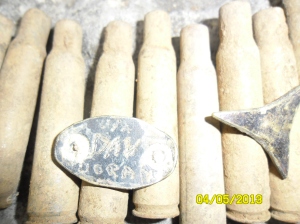 I am very excited to pass on the photo above which has just been discovered by a Catalan metal detector on the Ebro as of yesterday. No further details yet, but he seems to have discovered the metal name plate of Dave Doran’s hat and badge! We are talking with him to locate it and to understand the context All very exciting news! And here is Dave Doran (with another hat!)
I am very excited to pass on the photo above which has just been discovered by a Catalan metal detector on the Ebro as of yesterday. No further details yet, but he seems to have discovered the metal name plate of Dave Doran’s hat and badge! We are talking with him to locate it and to understand the context All very exciting news! And here is Dave Doran (with another hat!) 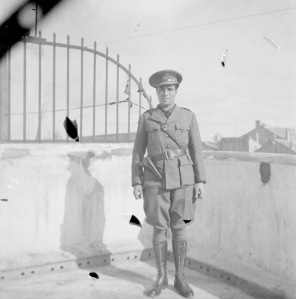 All early days yet, but I have now added this to my blog tonight and will update from here. Very exciting news! I also attach a link to Anna Marti’s report on the Retreat of the Lincoln Washington Battalion between March 30th and April 2nd, 1938. http://www.albavolunteer.org/2012/07/in-the-footsteps-of-the-lincoln-washington-battalion/ Note that Edwin Rolfe’s account above is at odds with the data currently being compiled, but it is a contemporary report of some value. I love this work! _________________________________________________________________________________________________________ 21st April, 2013 Photos of survivors of the British Battalion taken at Darmos on April 10th, 1938 “One morning about the 10th April 1938, before we went to our “foxholes”, we were paraded for photographs. At that time, about ten days after the massacre of the battalion at Calaceite on March 31st, there were no more than sixty to eighty men with the HQ of the Battalion, the rest were dead, prisoners, wounded or scattered over Catalonia.” Edwin Greening. From Aberdare to Albacete.
All early days yet, but I have now added this to my blog tonight and will update from here. Very exciting news! I also attach a link to Anna Marti’s report on the Retreat of the Lincoln Washington Battalion between March 30th and April 2nd, 1938. http://www.albavolunteer.org/2012/07/in-the-footsteps-of-the-lincoln-washington-battalion/ Note that Edwin Rolfe’s account above is at odds with the data currently being compiled, but it is a contemporary report of some value. I love this work! _________________________________________________________________________________________________________ 21st April, 2013 Photos of survivors of the British Battalion taken at Darmos on April 10th, 1938 “One morning about the 10th April 1938, before we went to our “foxholes”, we were paraded for photographs. At that time, about ten days after the massacre of the battalion at Calaceite on March 31st, there were no more than sixty to eighty men with the HQ of the Battalion, the rest were dead, prisoners, wounded or scattered over Catalonia.” Edwin Greening. From Aberdare to Albacete.
 Welsh Brigaders at Darmos, 10th April, 1938.
Welsh Brigaders at Darmos, 10th April, 1938.
A recent flare up of photos has taken place on the IBMT Facebook page which I have been helping add to with the kind assistance of Kev Byers. There are some names identified, but many still not. I will shortly place all the photos that I have identified as having been taken at Darmos and you can now see the photos together in the right hand column by clicking on THE DARMOS PROJECT. I look forward to hearing from you with names. Thanks! This at least will be a bit more permanent than Facebook! ___________________________________________________________________________________________________ I am nearly famous! Ooh! This came up today in the Sunday Telegraph!  http://www.telegraph.co.uk/travel/destinations/europe/spain/barcelona/10005749/George-Orwells-Barcelona.html And dont forget this event on Thursday too! Filling up fast! A walk and Round table (in Catalan) on the 75th anniversary of the Publication of George Orwell’s “Homage to Catalonia”, 25th April, 2013 “There’s been some kind of trouble at the Telephone Exchange, I hear.”
http://www.telegraph.co.uk/travel/destinations/europe/spain/barcelona/10005749/George-Orwells-Barcelona.html And dont forget this event on Thursday too! Filling up fast! A walk and Round table (in Catalan) on the 75th anniversary of the Publication of George Orwell’s “Homage to Catalonia”, 25th April, 2013 “There’s been some kind of trouble at the Telephone Exchange, I hear.”  Just to remind readers that places on this walk and talk are filling up fast. I may have four Americans and two British already! We will organise translation for non Catalan speakers. It is free and all are welcome, but please register now as places will be limited. http://www.amiando.com/diaorwell.html ___________________________________________________________________________________________________ 18th April 2013. A visit to Les Masies where a Farewell was made to the International Brigades on 25th October 1938, and the plans for the Despedida events in October 2013
Just to remind readers that places on this walk and talk are filling up fast. I may have four Americans and two British already! We will organise translation for non Catalan speakers. It is free and all are welcome, but please register now as places will be limited. http://www.amiando.com/diaorwell.html ___________________________________________________________________________________________________ 18th April 2013. A visit to Les Masies where a Farewell was made to the International Brigades on 25th October 1938, and the plans for the Despedida events in October 2013  ” At 2 am Oct. 25th left Marsa in violent thunder and windstorm for station, soaked to the skin within five minutes after stepping outdoors. All night in leaky train-carriage, no windows, wretched night, huddled, unsleeping men, cold and shivering, hard 3rd class benches-to Espluga-8am. There, sun coming up, but cold and wet too. Marched 4 kilometres to town of Poblet, where 35 and 45 Division Internationals were gathered. Fed and stood in square courtyard of house to await farewell speeches. Negrin- fine intellect, forceful speaker, but very tired. Colonel Modesto, chief of Army of the Ebro, visibly overcome with emotion.-strong, male guy. Marty- the demagogue, old and flabby. Others present. Rojo etc. Herbert Matthews, remembering me from April, gave Luckies to the guys. Robert Capa, photographer, taking pics.” Alvah Bessie’s Spanish Civil War Notebooks IMPORTANT NEWS! I had originally put up a suggestion that this location could be used for a possible conference over the weekend of 25th to 27th October before the 75th anniversary commemoration and possible conference that is being organised by Terra de Germanor. Just now I had a phone call from Sebastian Agudo of TdG and it seems that the events will start in Tarragona on the morning of Friday October 25th and in the afternoon move to Les Masies for a commemorative event. Hopefully they may organise a series of talks here on the Saturday and then slowly move everyone to Barcelona on Sunday 27th in time for the commemoration at the Horta IB memorial on the morning of the 28th and then the start of the Conference that afternoon and a second day of talks on the 29th. So now you know the dates and can hopefully book tickets cheaply if coming from afar? So I have offered to help with this event and will confirm details as they appear.But below is my original report from April 15th, edited after having talked with Sebastian. On Saturday, on the way down to Corbera, myself and a couple of Catalan friends stopped off at an Alberg at Les Masies near Poblet by Montblanc. On 25th April 1938 the International Brigades were paid farewell to at this location by Negrin. Modesto, Lister and Marty and others. Just look at this News report and between 0’18” and 0’48 you can see the same building. http://www.youtube.com/watch?v=EZ1bvt4titA&feature=youtube_gdata_player And of course there are many, many photos by Capa, Chim and Henry Buckley-Look at these: Here is an article by Nil Thraby who identified the location of the Capa photographs. http://www.nojubilemlamemoria.cat/pdf/Montblanch_near_Barcelona.pdf And here is an article (in Catalan, but with incredible photos) by Carles Queralt on Henry Buckley with many of the photos that Henry Buckley took whilst covering the War in Spain for the Daily Telegraph. I hope that the new and important English edition to be published this 6th August of Buckley’s “Life and Death of the Spanish Republic” by Tauris, will include these very important photos that have appeared in the exhibition by Carles.. http://carlesquerol.wordpress.com/dossier-henry-buckley/
” At 2 am Oct. 25th left Marsa in violent thunder and windstorm for station, soaked to the skin within five minutes after stepping outdoors. All night in leaky train-carriage, no windows, wretched night, huddled, unsleeping men, cold and shivering, hard 3rd class benches-to Espluga-8am. There, sun coming up, but cold and wet too. Marched 4 kilometres to town of Poblet, where 35 and 45 Division Internationals were gathered. Fed and stood in square courtyard of house to await farewell speeches. Negrin- fine intellect, forceful speaker, but very tired. Colonel Modesto, chief of Army of the Ebro, visibly overcome with emotion.-strong, male guy. Marty- the demagogue, old and flabby. Others present. Rojo etc. Herbert Matthews, remembering me from April, gave Luckies to the guys. Robert Capa, photographer, taking pics.” Alvah Bessie’s Spanish Civil War Notebooks IMPORTANT NEWS! I had originally put up a suggestion that this location could be used for a possible conference over the weekend of 25th to 27th October before the 75th anniversary commemoration and possible conference that is being organised by Terra de Germanor. Just now I had a phone call from Sebastian Agudo of TdG and it seems that the events will start in Tarragona on the morning of Friday October 25th and in the afternoon move to Les Masies for a commemorative event. Hopefully they may organise a series of talks here on the Saturday and then slowly move everyone to Barcelona on Sunday 27th in time for the commemoration at the Horta IB memorial on the morning of the 28th and then the start of the Conference that afternoon and a second day of talks on the 29th. So now you know the dates and can hopefully book tickets cheaply if coming from afar? So I have offered to help with this event and will confirm details as they appear.But below is my original report from April 15th, edited after having talked with Sebastian. On Saturday, on the way down to Corbera, myself and a couple of Catalan friends stopped off at an Alberg at Les Masies near Poblet by Montblanc. On 25th April 1938 the International Brigades were paid farewell to at this location by Negrin. Modesto, Lister and Marty and others. Just look at this News report and between 0’18” and 0’48 you can see the same building. http://www.youtube.com/watch?v=EZ1bvt4titA&feature=youtube_gdata_player And of course there are many, many photos by Capa, Chim and Henry Buckley-Look at these: Here is an article by Nil Thraby who identified the location of the Capa photographs. http://www.nojubilemlamemoria.cat/pdf/Montblanch_near_Barcelona.pdf And here is an article (in Catalan, but with incredible photos) by Carles Queralt on Henry Buckley with many of the photos that Henry Buckley took whilst covering the War in Spain for the Daily Telegraph. I hope that the new and important English edition to be published this 6th August of Buckley’s “Life and Death of the Spanish Republic” by Tauris, will include these very important photos that have appeared in the exhibition by Carles.. http://carlesquerol.wordpress.com/dossier-henry-buckley/ 

(Capa photographing on the left!)

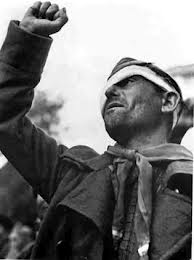

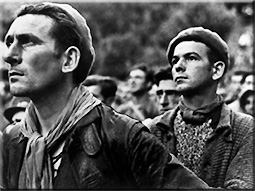
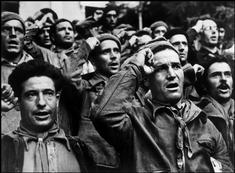 The place has little changed except for a new roof over the area where Negrin and other officers are addressing the Brigaders. Here are some photographs taken last Saturday to help you identify the film and photos above.
The place has little changed except for a new roof over the area where Negrin and other officers are addressing the Brigaders. Here are some photographs taken last Saturday to help you identify the film and photos above. 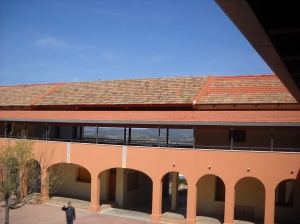
The open area where Negrin stood has now been roofed over and there is an additional canopy all along the walkway
(In the film and photo below you can see Capa clicking away this side)
(Henry Buckley was taking photos from this side)
Comrades Ventura and Josep take the place of the Brigaders! I am Negrin!
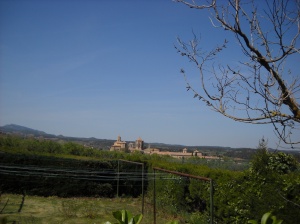
Poblet monastery from the Jaime I alberg
Oh yes. and we might have a dance! Look at this photo taken in the Square! 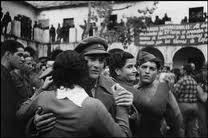


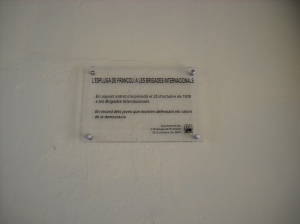
Plaque inside the entrance archway commemorating the 65th anniversary of the Farewell Parade.
International Brigade Memorial Trust are organising a trip to the Ebro 20th to 27th September to commemorate the battle of the Ebro and the last stand of the XV international Brigade.
Then and now shot of the Mac Paps resting in the Battalion Estado Mayor in the Sierra Pandols by Angel Sola (Well, actually I took the shot of Angel and then he did his voodoo stuff to make this incredible composition!)
Details of the International Brigade Memorial Trust’s September commemoration of the last stand of the XV Brigade have just been passed to members. It looks as if it will be very exciting and moving. I think that this is just for IBMT members, but if you are not a member maybe you can join then maybe you can go? The company will be friendly and welcoming to newcomers and I am sure eager to share their knowledge and family histories concerning the International Brigades. Author and historian Richard Baxell, author of “Unlikely Warriors” the new book on the British in the Spanish Civil War will also be taking part.
As to how to join (its not expensive), look up their website at www.international-brigades.org.uk
However, forthose going on this trip I heartily recommend John Wainwright’s moving and highly readable book, “The Last to Fall. The Life and letters of Ivor Hickman”. I took John on a trip to the places that the trip will try to go to on the Ebro when he was working on this excellent book. He left a laminated photo of Ivor at the last stand position where Ivor died (It is still there,John!). You can find it on Amazon and as a Kindle, but please go to John’s Facebook page and order a signed copy straight from him. It will help him more than Amazon, I think? https://m.facebook.com/pages/The-Last-to-Fall/340481165986752?id=340481165986752&_rdr Sadly, for some unknown reason I have not been asked to help organise this event but I know it will be a success with AABI members such as Almudena Cros and Seve Montero assisting. It is also probably good that the trip is being based in Cambrils so as to allow any “Spanish Civil War widowers” (and “widowers”?) to stay on the beach surrounded by the many Russians who now holiday there! However, I would like to offer a complimentary trip to those who may wish to see more than what will be offered by this trip. The announcement by the IBMT says that they know noone who has any knowledge of the fighting on Hills 481 and 666. If they could have asked me I could have easily showed them, seeing as I have been field walking this area for a number of years now! I am not sure if there is a breakdown in communication here, as I showed Duncan Longstaff, the organiser of this trip the same places a year or so ago. I wrote to him offering my help when this was first proposed, but seeing as he has not taken me up on it, I am offering this. However, in mitigation, some of the locations are not easy to get to. But armed with photos and memoirs taken during the fighting there is a great deal to see. Therefore I am announcing a trip for up to six people to join me on an intensive trip to explore the Battle of the Ebro, hopefully taking part in the events organised by the IBMT, but staying on the battlefield (in a nice hotel!) and seeing things that they will just not be able to see as they drive between Cambrils and the Ebro each day and as a large group. Sadly, the cost would have to be a bit more in total than what the IBMT group will be paying, but you will be able to see much, much more and hopefully understand the battle better and all transport, meals and guidance will be provided.. I am therefore offering a trip from Friday 20th September from Barcelona airport down to the Ebro battlefield and stay there until Tuesday 24th September, taking part in some of the activities organised by the IBMT, but also visiting various less well known places connected with the XV Brigade. Memoirs, photos and other information to enhance the silent locations will be offered on this trip. There is the intention that Karl Lewcovicz’ excellent musical “Goodbye Barcelona” will premier on either the 24th or 26th September in Barcelona. Having just talked to Karl, they may provide a transcript of the words and music in English for non Catalan speakers. If the premier is going to take place on September 24th I could also offer seats at the premier, but if on the 26th I can organise hotel rooms at cost in Barcelona to allow people who would like to come with me to stay and enjoy Barcelona a day or so before the Premier. I wait for confirmation from Karl.And if you do come, please bring a dinner jacket or evening dress!!!! If you would like to join me and tag along with the IBMT group the cost would be slightly higher but certainly more informative. I dont want to start a war here, but this is too important an opportunity to miss and more importantly to share the work I have been doing on this subject (See this blog!). . I wish the IBMT event every success with this important event, and have offered my assistance and advice since this was first thought of, but no positive response was ever received, sadly. So if you would like to see the Ebro battlefield please contact me. The cost (to include my accommodation, food car hire and some of my lost earnings taking time off work to do this) would have to be 120€ per person per day (down to 100€ if six people can come), but you would have a very intense experience unlike in a large group. So from Friday 20th September to Wednesday 24th September would cost 600€ per person (500€ with six) with all food, accommodation, entrance fees (including the premier of “Goodbye Barcelona” on either the 24th or 26th (hotel rooms in Barcelona at cost if the latter) of September). A 50% deposit would be very much appreciated to reserve rooms and hire a car etc. Flights would be each person’s responsibility, however. I am limiting this to four or six people in order to make it a more intimate and hopefully educational trip. If anyone has family who served here that they wish to follow then any information provided can help me locate them in the landscape. If you wish to visit the many important locations in the Sierra Pandols however, a certain level of fitness would be necessary. Please just be aware of this. As I said, I wish the IBMT event every success. And I know that Duncan will organise it very well. But the above offer is for people who would like to touch and understand the battle on a more intimate and intense level. To discuss this further, please e mail Alan Warren on pdlhistoria@gmail.com I look forward to seeing my many friends in the IBMT over that weekend in September and to remember together the Last Stand of the International Brigades!
_________________________________________________________
_________________________________________________________________________________________________________
A weekend on the Ebro with the son of British Brigader Clive Sexton. 13th and 14th April.
Last weekend, by some strange syncronicity I had the pleasure of meeting Clive Sexton and his partner, Dawn, on the Ebro to discuss his father’s experiences in Spain in the British battalion. Clive and I had been nattering on the excellent IBMT Facebook Page after he started to put up a variety of incredible photographs from his father’s collection. Clive also very kindly passed me a copy of his father’s memoirs written in 1986. I will study them more and add information to the memoir in time. Thank you Clive for your generosity. They make fascinating reading!
We agreed to meet in Gandesa on Saturday afternoon and to attend the talk by Anna Marti on the retreats of the Lincoln Washington battalion between Batea and Corbera just over seventy five years ago. The talk was organised by Associacio Cota 402, based in Corbera and they will also have a four day event in Campredo to commemorate the XIV French Marsellaise International Brigade who were slaughtered at Tortosa when they were caught between the River Ebro and the canal on July 25th 1938. If anyone would like to join me for this long weekend, please write to me at pdlhistoria@gmail.com. Leave Friday 2nd and return evening of Sunday 5th May.
Here is a summary of Anna’s work on the retreats. I have put it up a number of times, but gof those who may have missed it, here it is again! In Spanish and English
http://www.albavolunteer.org/2012/07/in-the-footsteps-of-the-lincoln-washington-battalion/
The excellent Diari de Guerra blog also put up this report:
I am pleased to say that Battle of the Ebro expert Fransesco Cabrera has agreed to work with Anna Marti to try and share information. Now to get Jaime Cinca and Samuel Basterra onboard. Here is hoping!
Here is a photo of Anna with Clive Sexton and Dawn.
Having sped read (is that areal word?) Cyril’s memoirs that night, I was able to show Clive the locations where his father was before he was wounded on the way towards Corbera. I was also able to show them the location of where Cyril was taken back over the Ebro over a pontoon bridge at Asco after having been wounded somewhere between Camposines and Corbera. Here are some photos of the engineer unit taken near Asco. Clive and Dawn take the place of soldiers who appear in the propaganda shots that one often sees!
This was General Modesto’s Command Post during the later part of the Battle. the adjacent tunnel was where they held wounded during the day before evacuating them overnight due to bombing of the bridges.
Now to get down to studying Cyril’s memoirs!
____________________________________________________________________________________________
12th April, 2013
A link to an incredibly useful guide to Spanish Civil War Archives and resources in Spain.
Please find below a link to a download of a 212 page document in Spanish and English detailing Spanish Civil War Archives in Spain. I hope it might be of use to readers.
The rather long-winded title is “Vademécum de Historia Contemporànea de España. De la Guerra Civil a la Democracia. Guia de archivos, instituciones, bibliotecas, asociaciones, museos y lugares de memoria” by A. Pelka, 2012, Berlin, Fundación Federal para la investigaciön y evaluaciön de la dictadura comunista en la RDA. Enjoy!
This document was referred to in the new book “Didáctica de la Guerra Vivil española” by Maria Feliu Torruella and Fransesc Hernández Cardona, published by Editorial GRAÓ last month. .www.grao.com (see below). Here is the ink to the book to download for free: https://www.bundesstiftung-aufarbeitung.de/download.php?file=uploads%2F2012-pdf-publikationen%2Fvademecum_spanisch.pdf
_________________________________________________________
11th April, 2013
New book in Spanish with a great deal of useful information for SCW “freakies”.
“Didáctica de la Guerra Civil Española” by Maria Feliu Torruela and Fransesc Xavier Hernàndez Cardona. Editorial Grau, http://www.grao.com
Though many readers may not understand Spanish, I have just received a copy of this very useful little book with various links to subjects appropriate to the subject of the Spanish Civil War. comprising 160 pages studying many subjects from contemporary press, archaeology, boardgames and re-enactment, I heartily recommend it to those curious to know more about current research here in Spain.
_________________________________________________________
10th April, 2013
A Review of the new dvd “War in Spain” based on the unique colour film “Defenders of the Faith” by Russell Palmer.
I recently received a copy of this 2 dvd set of a series of five tv programmes produced by Eclipse Media (www.cannystore.com). This is a fascinating summary of the Spanish Civil War using the unique colour film entitled “Defenders of the Faith” made for Nationalist sympathisers in the United States by American publisher Russell Palmer. Much additional black and white film has been added to supplement the dialogue. Whilst the original film is worth watching, perhaps this series of five 45 minute programmes might be of interest to class groups studying the Spanish Civil War? It also includes on a bonus dvd Hemingway’s “Spanish Earth” and “Fury over Spain”. I recommend obtaining a copy of this dvd set.
_____________________________________________________________________________________________________________
Review of Atlas de la Guerra Civil Española. “Les Brigadas Internacionales” by Victor Hurtado. Dau Ediciones, Barcelona, 2013. Price 28,80€. Available to order from www.edicionsdau.com
I recently received a copy of the above book for which a Youtube video (http://www.youtube.com/watch?v=HWxUF5ADwu8&feature=youtube_gdata_player) was passed around IB circles recently. Having had the opportunity to read it closely, I am very happy that it has been published, but have sadly noted some glaring errors in the text. Whilst graphically an exciting work in colour, I have made below a list of errors which I hope will be corrected in a future edition.
Dau Ediciones also published the excellent “Atles de la Guerra Civil a Catalunya” (in Catalan), which soon had a second edition out. I hope that Dau can do the same with this book.
Comprising 78 pages in a hardback format measuring 27 by 22cms, this book is the second in a series of books that began with “La Sublevación” and will also eventually have three other atlases on the Condor Legion, the Italian contribution and the Post War Repression and victims. This book will especially interest those studying the International Brigades, and a lot of work has been put into it , for which I commend Victor Hurtado. There is a three page English abstract for non Spanish speakers at the end of the book. However, a number of quite serious errors have appeared, probably due to poor proofing of the finished pages? These things do happen, but it is a great shame that they have appeared in this book. I summarise the errors that I have located so far: Page 16. “Hans Heimler” should read “Hans Beimler”. The “Batallón Britanico” should not exist. “Tom Man” should read “Tom Mann” Page 20. For “Jason Guerney” read “Jason Gurney” Page 28. For “Dispersión (noviembre de 1937- enero de 1937)” read “Dispersión (noviembre de 1936-enero de 1937)” Page 50-Belchite. “Malcolm Dumbar” should read “Malcolm Dunbar”. The grey lines of advance on the Belchite map should read as follows: “4 de octubre” should be “4 de septiembre”; “5/6 de octubre” should be “5/6 de septiembre” Page 58. “La Batalla del Ebro (junio-agosto de 1938)” should read “La Batalla del Ebro (julio-agosto de 1938)” Page 59. “El paso del rio (24-26 de junio de 1938)” should read “El paso del rio (24-26 de julio de 1938)”. Page 59 “El desastre de la Marsellaise (28 de julio de 1938)” should read “El desastre de la Marsellaise (25 de julio de 1938)”. Page 60. “Infierno en Gandesa (25 de junio-6 de agosto de 1938)” should read “Infierno en Gandesa (25 de julio-6 de agosto de 1938)” Here are the errors in Spanish should Spanish speakers require them: ERRATA por @Atlas de la Guerra Civil Española. Les Brigadas Internacionales” de Victor Hurtado. Dau Ediciones, Barcelona, 2013. www.edicionsdau.com Página 16: Por “Hans Heimler” debe leer “Hans Beimler“. The “Batallón Britanico” no existe. Por “Tom Man” debe leer “Tom Mann“. Página 20: Por “Jason Guerney” debe leer “Jason Gurney” Página 28: Por “Dispersión (noviembre de 1937- enero de 1937)” legir “Dispersión (noviembre de 1936-enero de 1937)” Página 50: Belchite. Por “Malcolm Dumbar” debe leer “Malcolm Dunbar“. Página 50: Deben ser las lineas grises en el mapa de Belchite: “4 de octubre” legir “4 de septiembre”; “5/6 de octubre” legir “5/6 de septiembre” Página 55: Por “transcripcion planatada en la cima de la cota del Muleton por el mayor Hill Alexander, jefe del bataillón British, el 19 de enero de 1938” debe leer “transcripcion planatada en la cima de la cota del Santa Barbara por el mayor Bill Alexander, jefe del bataillón British, el 19 de enero de 1938” Página 58: “La Batalla del Ebro (junio-agusto de 1938)” debe leer “La Batalla del Ebro (julio-agusto de 1938)” Página 59: “El paso del rio (24-26 de junio de 1938)” debe leer “El paso del rio (24-26 de julio de 1938)”. Página 59: “El desastre de la Marsellaise (28 de julio de 1938)” debe leer “El desastre de la Marsellaise (25 de julio de 1938)”. Página 60: “Infierno en Gandesa (25 de junio-6 de agosto de 1938)” debe leer “Infierno en Gandesa (25 de julio-6 de agosto de 1938)” I would like this book to succeed. I would like this book to sell so that a second edition can be made. I sincerely hope that at least an erratum slip can be added to each book to highlight the errors and to allow enough sales to warrant a corrected second edition. I want to like this book. But at least this might make it worthy of buying. I will have to let the reader decide. But if noone buys it there may not be a second edition! Damned if you do, and damned if you don’t! And maybe a first edition might be worth something in the future? Copies can be bought at 28,80€ post free to addresses in Spain, plus 6,50€ postage to addresses in Europe and plus 9,50€ to addresses in the rest of the World. If people can work together with individuals coming to Spain either for the 75th Ebro commemorations in July, or the IBMT September 23rd commemoration on the Ebro, I can pass on copies post free to someone to pass on to those who cannot come and save them postage?
If anyone wishes to coordinate this idea with people in the United Kingdom or United States, please contact me on pdlhistoria@gmail.com
_________________________________________________________
9th April 2013
In the footsteps of Harold Hoff.
A tour with Ray Hoff to find his father in Spain. 23rd to 31st March 2013
This is a summary of a tour I conducted with Ray Hoff, son of Harold Hoff, an American who served in the Lincoln-Washington and Mackenzie Papineau battalions between September 1937 until he returned to the United States in December 1938. We left Barcelona in the morning of Saturday March 23rd to drive down towards Segorbe and Teruel. We had been invited for lunch by a Spanish friend, Marisa Gonzalez, who is working on her Phd at Valencia on poetry by Spanish brigaders, after her original dissertation on poetry by English speaking brigaders. However, on our way down we quickly stopped at Benicassim cemetery to see the memorial to the Brigaders who died at the IB hospital in the town.
Monument at Benicassim cemetery to the International Brigade dead
Many of the original villas such as the Ralph Fox, Garibaldi and Thaelmann used to house recovering brigaders are still there, and the old hospital is now a rather nice hotel. We eventually made it to Segorbe to meet Marisa with her family and she made us all very welcome and we ate a delicious paella at her home in the beautiful City of Segorbe. I want to visit this city again and explore it more. After lunch we were invited to visit a former Republican airfield at Alcublas and all got locked in by Paco, our host! Luckily he eventually found the keys in his pocket!
Interpretative plaque at Alcublas airfield
Here is a compilation of photos of the airfield at Alcublas. Juan Negrin’s son was a pilot at this airfield. If anyone wants to visit it then I can put you in touch with Paco who peaks English and can open up the air raid shelter (but make sure he has the keys!).
http://www.youtube.com/watch?v=lUr1WX32YmU&feature=youtube_gdata_player
Here also is a link to a report (in Spanish) on the airfield at Alcublas. http://www.alcublas.es/sites/alcublas.portalesmunicipales.es/files/estelas-en-el-cielo.pdf By Saturday evening we had got to Teruel to stay in the Hotel Orient, beside the Teruel Bullring.
I attach a link to the 1937 SIE film “Toma de Teruel”. The first three minutes cover the attack on Zaragoza in the summer of 1937 and the last half with shots of the fall of Teruel in late December 1937l. Actually, the film (and famous photos of troops and tanks advancing towards the bullring ) are pure propaganda, as the city is the other side of the gorge! You may be able to make out a bust on a plinth in some shots. This is the architect Toran, who designed the bridge across the gorge and the Esplanade from the railway station up to the city. The bust is still there staring across the bridge! Cool shots of Russian T26 tanks milling about!
http://www.youtube.com/watch?v=cC4N4UUSqM8&feature=youtube_gdata_player

The monument to Jose Toran, who designed much of Teruel’s architecture in the 1930s
Ray in front of the famous Bullring
The Bullring in December 1937
A building opposite the Bullring riddled with bullet holes, seen in the film below:
After a good rest we explored Teruel city and I showed and identified photos and film taken here, the British battalion positions by Mas del Chantre, the Mac Pap positions by the railway, the “North Pole”, the IB hospital at Cuevas Labradas, the Lincoln Washington graffiti at the nearby station and the railway tunnel where the Brigade tried to shelter. We also tried to find Dr Eloesser’s hospital at Alfambra from a photo, a possible photo of the British battalion at Fuentes Calientes, but with no joy on either, sadly.
Plaza del Torrico now.
Plaza del Torrico in January 1938
Sunday 24th March. As we explored the besutifully reconstructed City of Teruel and the hinterland. We read James Neugass’ vivid and detailed descriptions of the area from his diaries “War is Beautiful”. We also visited Mezquita del Jarque and explored positions above the Alfambra valley near Pancrudo (where the British battalion briefly stayed- see John Dunlop in “Voices from the Spanish Civil War” edited by Ian McDougall). The reason for this was that we were accompanied by Pau Rubio, a historian who has been transcribing his grandfather’s brother’s letters from his time on the Teruel Front and he mentioned staying in Pancrudo. This really was an odd place. It seemed to have hardly changed in over seventy five years. Huge open plains and wild terrain. Rock strewn fields and very few people. Monday 25th March. We drove up from Teruel to Alcorisa, Mas de las Matas, Aguaviva and Morella. Alcorisa was where the XV Brigade was based over Christmas 1937 and from where they moved towards Teruel in the freezing cold of December 31st,1937. Hard to imagine on a pleasant Spring day! Mas de las Matas was where the British, Canadian and Spanish battalions rested. Neugass gives some descriptions of the village and many photos have been identified as having been taken here. Javier Diaz, who runs the mail order bookshop Llibereria de Cazabaret lives here and we wne to visit him. Masses of fascinating books on the Spanish Civil War! Aguaviva was where the Lincoln Washington battalion stayed for Christmas. Oddly enough, one of the villagers first thought that the Americans were Italian because he heard them speaking Italian! The Americans argued with their commissars about giving their cigarrettes as Christmas presents to the villagers, but were eventually persuaded to do so. The same villager remembers being given a die-cast plane with Republican colours by members of the Lister Division who wre also here over Christmas 1937. He was treated by the American doctors when he bumped his head, and his Mother had a tooth removed! We showed Ray the graffiti left by American Brigader Edward Muscala in a ruined hermitage nearby.
We then drove towards Morella, which the brigaders visited when they were based in Aguaviva and Mas de las Matas. This is a beautiful fortified city perched high on a mountain.
Sadly, Ray and I chickened out climbing to the top of the castle and sat and drank coffee while Pau and Ray’s travelling companion climbed to the top. They were very happy to have seen the views from the top, despite the miserable weather. Sadly, we had to say goodbye to Pau as he had to return to Barcelona for work, but hopefully Ray will keep in touch with him in the future.
We then drove to nearby Mirambel, a beautiful village fortified by the Templars and a quite charming place. This was where Ken Loach filmed the battle scenes in “Land and Freedom”.
Mirambel
Tuesday 26th March
After a morning exploring the charming village of Mirambel (a Nationalist cavalry unit occupied the village during the Nationalist advance in March 1938, and some of the buildings still have the quarters named for each cavalry troop, the Estado Mayor and Colonel’s quarters in red paint if you look carefully), we identified scenes from “Land and Freedom”. I suddenly realised that the film is 18years old! I know that others may not agree, but I still enjoy the film.
For those interested in watching the film, here is a link: http://www.youtube.com/watch?v=ITTlvf0vfto&feature=youtube_gdata_player We then drove to Segura de los Banos where the XV Brigade fought in February 1938 as a diversion. Ray’s Father fought in this Battle. We passed Vivel de Rio Martin as we entered the valley.

Seguro de los Banos
This was the objective of the British battalion while the Lincoln Washington battalion advanced across the valley to take the Atalaya and the Mackenzie Papineau Pedregosa mountains. Bill Titus and Hy Greenfield were killed here and the location of the mass grave of dead in the cemetery is known. Every All Saint’s Day (November 1st), villagers leave flowers there. Also, the late American IB expert, Tom Entwhistle, assisted the family of Hy Greenfield to place a small plaque above the mass grave a few years ago. It is still there as a silent memory.
We then drove to Muniesa where James Neugass in his diaries “War is Beautiful” vividly describes the building used as the hospital there for the Segura de los Banos operation close by, that has now been identified. He wrote on February 16th:” All night long Captain Alexander of the English, shot through the shoulder, gives orders:” Get the men out in camions, bring up the anti-tanks and water for the machine guns, bring up dynamite bombs, get the men out in camions”.
The place has hardly changed. Interestingly, Neugass asks why the Nationalists bombed the defenseless village killing Joe Leguera? In actual fact, he probably never knew, but there was a Republican airfield right beside the village. For those curious about Herman “Hy” Greenfield, who was killed at Segura de los Banos and where a memorial to him above the mass grave of XV Brigade (it is visible on the left on the wall if the gate is locked), here is link care of ALBA of letters from him. Very moving. http://cdm15052.contentdm.oclc.org/cdm/search/collection/p15052coll1/searchterm/herman%20greenfield%20abraham%20lincoln/field/all/mode/all/conn/and/cosuppress/ 
Hy Greenfield memorial in Seguro de los Banos cemetery. below is the mass grave of Brigaders killed in this battle
Finally to Fuendetodos, birthplace of the artist Goya and near Belchite. A bit of culture and a change from the Spanish Civil War! Wednesday 27th March What a fascinating day this was! Firstly, the evening we came to Fuendetodos, a Spaniard came up to me in the hostal and said he was Russian. I was curious, but did not follow it up that evening. The following morning Howver, I talked to him over breakfast with his Russian wife, Russian son and daughter in law and discovered he was one of the Spanish niños who was sent to the USSR in the summer of 1937! He also mentioned that his older brother, Lluis, lived in the village and that I should go and meet him. Sergio had lived in Russia until the ’90s but returned to live in Valencia. His brother then turned up and we were introduced. Suddenly I realised that I was talking to none other than the sons of Antonio Salueña, a Republican Airforce pilot who was based at Sarineña and who was allegedly the pilot who dropped the two bombs that did not explode on the Cathedral of Santa Pilar in Zaragoza! We agreed to meet later and he told me about his life as a refugee child in the USSR. An incredible story! 
Lluis Salueña, me, Sergio Salueña and Sergio’s son
This day Ray Hoff and I followed in his Father’s footsteps of the start of the Great Retreats of March 1938 when Harold was in the Brigade machine gun company with the Mac Paps near Letux and Azuara, identifying certain locations. The odd thing is that Edward Cecil Smith’s report on the Rretreats states that the Brigade Machine gun company were ordred to postions 2 km north west of Lecerea and later turned up without rifles or machine guns at Azuara where the rest of the Mac Paps were. I suddenly realised that this might have been the reason why Jack Dooper was courtmartialled by Dave Doran in the Batea theatre in late March 1938 and sentenced to death for losing his machine guns! Luckliy, Sandor Voros persuaded the Brigade Staff to recind the order by the fear that if Hemingway or Matthews got to hear of it, it might produce bad press in the United States. ![11_0147s_Isadore Levitt [alias Jack Cooper], Brigade Machine-Gunner Company_Apr 38](https://pdlhistoria.files.wordpress.com/2009/12/11_0147s_isadore-levitt-alias-jack-cooper-brigade-machine-gunner-company_apr-38.jpg?w=218&h=300)
Jack Cooper (alias Isadore Levitt), Darmos, April 1938
We also visited Quinto, where Harold was filmed in October 1937 by Cartier Bresson in his film “With the Abraham Lincoln Brigade” and also Fuentes de Ebro where Harold states in his carnet that he was stationed on the Front (but probably in the rear at Quinto in Oftober 1937). However, a great surprise awaited us in Belchite!
Quinto Church
You can see the same ruined church above in this 1938 extract from the Cartier Bresson film, “With the Abraham Lincoln Brigade in Spain”
http://www.youtube.com/watch?v=9AhGGC_i-WY&feature=youtube_gdata_player
Sadly, Belchite has always been a very sad place. Forgotten, unloved and a melacholic place of ruins. But something very interesting is happening. The ajuntamiento are clearing the place up and organising tours!

Sant Augustin Church
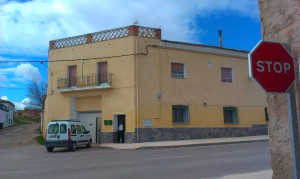
“Nelson`s Factory” today
“Nelson`s Factory” in September 1937
The Nationalist Commandancia

The same building today
I met Juan Carlos Salavera Pardus at the Goya entrance with a group of about twenty Spaniards. We knew each other from the 75th anniversary event we conducted there last September, and he invited me to the tourist office later that afternoon. We talked there and it seems that the ajuntamiento are organising guided tours at 6€ per person. They also have equipment for other languages (including just one in English at this moment in time!) to which I listened to a part and Ray the rest. I asked him his opinion and though he also thought the English voice a bit soporithic, he mentioned that he thought the description of the Belchite battle brief, though he admitted he may have pressed the “forward” button too much? Sadly, I did not have time to listen to the whole thing, but the ajuntamiento are finally doing something, selling souvenirs and hopefully later books? Lets see. But it pleased me greatly to see this important development in the successful interpretation of this tragic battle, whilst also stimulating the local economy. I want to give it my full support and wish it the very best!
Further details can be found on www.belchiteturismo.com
Incidentally, did you know that Terry Gilliam’s “The Adventures of Baron Munchausen” siege scenes were filmed in Belchite? One of Bob Doyle’s sons was a special effects technician on the film and when they laid cables for fires and explosions they often found human remains! Thursday 28th March We left Fuendetodos at a reasonable hour in the morning to meet local historian Jaime Cinca in Lecera. Jaime is the expert on the Battle of Belchite and I introduced Ray to him. He helped produce the excellent book published by Amarga Memoria entitled “Viejo Belchite”, with incredible then and now photos. What Jaime doesnt know about Belchite isnt worth knowing! One exciting development is that there is a very good chance of Fausto Vilar’s autobiography, “A Little Valencian in the Abraham Lincoln Brigade” may soon be available to download from the web in both Spanish and English. This manuscript is incredible and quite unique. I have used passages and Jaime and Samuel Basterra used part of it for their recent report “4km en Belchite” which I have put up a number of times on Facebook and also here in English:
http://faustovillar.blogspot.com.es/2012/11/4-km-in-belchite.html
It pleases me greatly to see such developments. I will let you know when it becomes available. It will be worth the wait! Jaime showed us a location south east of Lecera where the Mac Pap machine gun company tried to hold off the Nationalist advance in March 1938. He mentioned that three or four Canadians were captured and showed us where they were executed. A moving moment to stand in front of the wall where this happened. One of many such events.
The wall where three or four Mac Paps from the machine gun company were lined up and executed.
Jaime Cinca and Ray Hoff. The hill to the left was where the Mac Pap machine gun company set up to defend the retreat.
Jaime mentioned that he had been involved with a Canadian film crew and historian a few years ago and showed them this site. i think I know which programme he is referring to and will try to add a link to the programme if it is still on Youtube. The presenter came to Spain in October 2008 with Canadian brigader Jules Pavio and I seem to remember he showed Jules where he was captured along with Carl Geiser on April 1st 1938 between Calaceite and Gandesa. They were almost executed too, but an Italian staff car came up and stopped the act.
As an aside we stopped for lunch at Hijar following the Great Retreats towards Alcaniz and then Caspe and ate at a very nice restaurant. I add a photo of the Restaurant’s wine bottle!
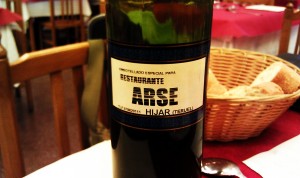 Here is one shot we have identified from photos taken during the Great Retreats on the road between Alcaniz and Hijar:
Here is one shot we have identified from photos taken during the Great Retreats on the road between Alcaniz and Hijar: 
 Friday March 29th We left Caspe at km1. Bob Cooney in his unpublished memoirs “Proud Journey” wrote that the British and other brigaders were ordered to meet there before retiring, but that John Gates ordered them back into the town after apologising for issuing a misunderstood order. It is at the end of an arched stone bridge with the town towering above it and the viaduct of the railway bridge to its right. Over this partially destroyed railway bridge, some brigaders had to rush over from defending the railway station being shot at by enemy forces from the old convent of Sant Domingo. No cover- just run like hell.
Friday March 29th We left Caspe at km1. Bob Cooney in his unpublished memoirs “Proud Journey” wrote that the British and other brigaders were ordered to meet there before retiring, but that John Gates ordered them back into the town after apologising for issuing a misunderstood order. It is at the end of an arched stone bridge with the town towering above it and the viaduct of the railway bridge to its right. Over this partially destroyed railway bridge, some brigaders had to rush over from defending the railway station being shot at by enemy forces from the old convent of Sant Domingo. No cover- just run like hell. 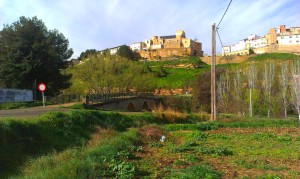
View of the bridge below Caspe at km 1
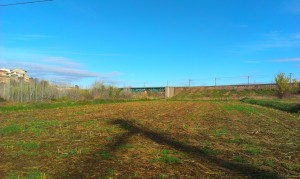
To the right of km 1 there is the railway bridge which was partially destroyed at the time.
Milton Woolff in his autobiographical novel “Another Hill” mentions he with Sam Grant (who always wore a steel helmet!) and others setting up a machine gun in the upper window of a warehouse and piling up bags of flour as protection and damping down any dust by pouring wine over the bags (and drinking some too!)! The warehouse is still there. They were firing at Carlists beside the railway station and one can see faint traces of bullet holes on the wall facing the warehouse.
Milton Woolff’s machine gun was situated in the far left upper window of this warehouse

The wall of Caspe railway station with faint bullet marks from Woolff’s machine gun
Cecil Edward Smith’s report on the Retreat is a Godsend, but he muddles up Reservoir Hill (to the west of the town) with Cemetery Hill (to the east). Reservoir Hill had brigaders charging up to take it, some only armed with rocks and shouting! This was where Nilo Makela was mortally wounded. But they took it. The little red house by the railway described by Smith is still there. From the railway and either side visible there are windows to defend it, which a party of British tried to do, but the invisible far side has only a tiny circular ventilation hole impossible to defend. And that wall is riddled with enemy machine gun fire!
Look on the report in the right column on the Great Retreats for further information and photos.
The streets of old Caspe are narrow. There is the story of mistaken identity of a German tank surprising a group of Americans and driving over the wounded. One survivor, according to Harry Fisher in “Comrades” lost his mind after experiencing this. It happened here.
The road to Maella and Batea is almost the same as then, but with some alterations. The old bridge over the Algars is still there and below is the beautiful river where Alvah Bessie bathed as bombers flew over on Sunday March 20th after he joined the Brigade.

The River Algars
His “Spanish Civil War Notebooks” and “Men in Battle” are excellent and have helped us no end in locating various places on the Ebro. Towards Batea is the Estado Mayor of the XV Brigade where photographs of Robert Merriman have been identified. Bessie describes meeting the survivors of the Brigade here. It is a miracle that they survived. They were here between March 17th and 26th before moving to Corbera. But worse was to come when the XV Brigade was called to the Front again on March 31st. That is why we were going to do this 30km walk on almost the same route as the subsequent retreat of just the Lincoln Washington battalion in which 196 of them died.
However, to continue Ray’s journey, we met author Angela Jackson in Marça, author of “At the Margins of Mayhem”- a book describing the experiences of local people and brigaders when they were here training for the Ebro Offensive. Angela is assisting the IBMT to organise a 75th anniversary commemoration of the final stand of the XV Brigade the weekend before 23rd of September 2013 and unveiling a memorial in Corbera old town on the 23rd. The group (50+!) will stay overnight in Cambrils and other events are being planned there too. It should be good. Duncan Longstaff is organising the event if you are interested in taking part(son of runner John Longstaff whose memoirs may soon be published by his son). His Father’s memoirs are a fascinating description of his experiences during the Battle of the Ebro.
After leaving Angela and meeting Catalan historian Josep Xaubet, who has researched Mataro International Brigade Hospital, we followed the locations of where the XV Brigade fought in a whistle stop tour for Ray. Sadly, my partner wanted some days for just the two of us over Semana santa, so this tour had to be curtailed by two days, so a more leisurely visit to all the sites had to be hastily reorganised before this tour was to begin. But Ray has been shown the locations where his Father was (especially Hill 287 where he was a machine gunner on September 23rd and with whom the two unnamed young Spanish ammunition carriers were killed, followed by his comrade Jack Eegan by a bullet in the head. Harold scrambled down the terraces and ran. Like many people before him who have joined me on these trips, this is a journey of discovery with great meaning in subtle different ways. We also visited the “Internacionales a l’Ebre” exhibition and the Associacio Lo Riu museum in La Fatarella on the trenches and bunkers above La Fatarella which have been recently excavated. The XV Army Corps “Fortified City in the Forest” is well worth visiting! Finally, we also visited Corbera old town. The old church now has a plastic transparent roof and one can walk up the church tower for an incredible view of the remains of the town. There is also the biannual art exhibition there. It is open at weekends until 12th June. 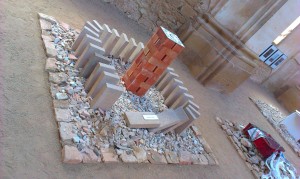
Just one of the striking art exhibits in Corbera church
Close up of the above exhibit. On the red bricks the word “Them” with a euro sign and on the grey bricks below “Us”. Powerful exhibits under the title “Victimas”
I returned there after the walk on Saturday walk to talk with a local historian about the possible burial place of Jim Lardner. This man knows his stuff and I will be curious to listen to his story and visit the site. But in the meantime we are looking at seven graves of Internationals shot just outside Corbera in April 1938, which may include Robert Merriman? Oral memory and an anonymous Nationalist officer’s report seem to indicate “a tall soldier” being executed here. We are working with the University of Barcelona (who found “Charley” of the XV Brigada Mixta (ex XV International Brigade) at the La Fatarella trenches to possibly excavate the burials after seeking appropriate permission. Lets see. I also showed Ray the possible location of a mass grave of fifty Americans near Gandesa based on oral memory. I bumped into the landowner and introduced myself. I hope to organise ground search radar to confirm the story, but not sure what to do afterwards? We discussed this with UB and their comment was that it would be too expensive to excavate! Ho hum. 
Possible location of the mass grave of 50 Americans executed on April 2nd 1938 according to oral memory. The vines were here at the time, but just to the right of the tree is a curious bare patch.
Just below the possible mass grave a profusion of red, yellow and purple flowers grew. The colours of the Republic.
75th Anniversary March from Batea to Corbera to remember the 196 American dead of the Lincoln-Washington Battalion. 30th March 2013. Saturday 30th March 2013
The start of the Walk from Venta de Sant Joan
In the company of Harold Hoff’s son, Ray, twenty people met at Venta Sant Joan, the “great lime-washed stone house” as described by Bessie as the forming up place of the Lincoln-Washington battalion as they started their retreat to safety from north of Batea. The route had been laid out by Catalan historian Anna Marti two years ago, and she and her partner Enric had sprayed Republican flags to direct walkers over the 30km route.
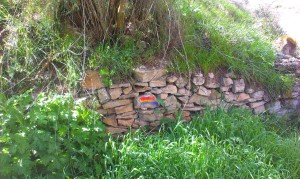
One of Anna’s and Enric’s markers
Fair weather and a four wheel drive vehicle (Thanks Kelvin!) supported the walkers. Sadly, Ray did not walk all the way, but his presence was very meaningful for many of the walkers. We asked Ray to lay some flowers above Gandesa in memory of the American dead, and he said a few words in memory of them.

Ray leaving the flowers above Gandesa from where the Lincoln Washington battalion tried to get into the town, but failed.
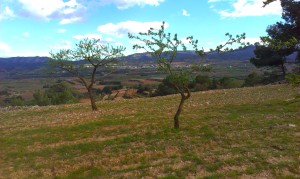
View from the hill overlooking Gandesa
Luckily, because he was not on the walk in the afternoon per se, we were able to show Ray the route of the Mackenzie-Papineau battalion, to which his Father had been attached to after Caspe on March 17th till April 18th 1938. He was with the Canadian battalion as they followed up behind the British battalion advancing towards Calaceite, but were unable to reach the fortified line that they should have occupied. Like the British and Spanish battalions, they escaped towards Gandesa south of the Calaceite to Gandesa road in small groups trying to reach safety across the River Ebro
Before the main group arrived at the agreed finishing point by Corbera, we took Ray to Hill 287 where the Lincoln-Washngton battalion held out on September 23rd, 1938 before their final withdrawal. Whilst Ray walked Hill 287 before Corbera, I walked Hill 281 behind it. It was a great pleasure to get an excited phone call from Ray having discovered the trenches occupied by the Americans and, of course, his Father. It seems that Harold Hoff was in the trenches with two young Spanish loaders and a Jack Eegan. The two Spaniards were killed and suddenly Egan fell, shot through the forehead and then the wounded Harold made a run for it. Ray had found his Father in Spain. 
Hill 287 from Hill 281 looking towards Corbera
And then we were able to join the walkers outside Corbera. As a memory, I had made up small sheets with some olive leaves attached that we had picked up on our route of Harold Hoff and the XV International Brigade from Belchite to the Ebro. I still have some left and may send them to FFALB to offer to their members as a memory of this tragic event. They might even be able to auction them as I believe that their financial resources are not huge? I will send them to Georgia Wever in the States shortly, and hopefully they might be of interest? All the Catalan versions have gone. No more will be made to commemorate this tragic event. But the decision was made at the end of the walk to make another March in 2014. Everyone enjoyed themselves and hopefully it can keep the memory alive.
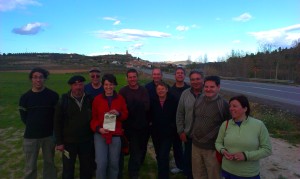
Some of the walkers at the end of the 30km walk looking happy! Corbera in the distance behind
One very interesting thing happened out of this day. In the morning I went to pick up floral arrangements in Gandesa to use for this day and for the following morning of the 31st of March for the British Battalion ambush at Calaceite. The florist mentioned that her sister’s daughter was doing a project in her College on the American brigaders, and later in the evening this young woman came to interview Ray. I hope that her curiosity might be inspired. Ray noticed that when he mentioned the age of the two Spanish loaders who were with his Father on the last day of action on Hill 287, the young woman aged sixteen gave a shudder, as the two young Spaniards were almost the same age as her. But who were they? Maybe we will never know. She is the future generation to keep this memory alive, and it was good of Ray to talk with her and answer her questions. Thank you Ray. This is very important. And so ends the report of this Tour. Much of this was added day by day on Facebook, but without photos. But now you can see some of the photos we took on the Tour. I hope that Ray enjoyed it. I certainly did and also learned new bits to add to future tours. Next plan. The 75th anniversary of the Battle of the Ebro between July 23rd and July 29th. Anyone interested in coming? If so, contact Alan Warren on pdlhistoria@gmail.com _________________________________________________________ 4th April, 2013 75th Anniversary of the Ambush of the British Battalion at Calaceite, March 31st, 1938.
Kelvin Ling and Alan Warren with flowers just before daybreak on March 31st 2013 at the position of the ambush of the British Battalion on March 31st, 1938
(Photo taken by Ray Hoff using Ken’s camera!)
Last Sunday at 0700 three hardy souls stood on the exact spot where almost 140 Britons were killed and 140 captured after marching into an ambush at dawn on March 31st, 1938. The previous day we had attended the 75th anniversary March commemorating the 196 Americans who had been killed on the retreat between Batea and Corbera, and we thought it only right that we should acknowledge this event too. Depsite losing an hour’s sleep, we stood before dawn, close to where Wally Tapsell was shot down and where many others died, were captured, or escaped up the hill. Numerous accounts exist, and recently, through the Moscow Archives, I have been reading the contemporary reports by Sam Wild, Bob Cooney and George Fletcher, aswell as the Orders of the Day. The materiel is fascinating to read and to try and understand the reasons why the battalion walked into Italian tanks. This will take time to study, but maybe in time something more can be written on this event. In the meantime, I need to compile the many accounts provided by survivors. With all the other activities going on here, it will take time.
Dawn at Calaceite
Needless to say, we spent a quiet minute remembering these men as the sun slowly rose in the east. Probably everyone involved in the study of the International Brigades knows at least one story from this action. But now there are some flowers close to the spot and flowers by the memorial to Robert Wardle and James Bentley in Calaceite cemetery. Hopefully that is a fitting locus of memory, should people wish to visit the village and remember the British who died here that day.
Later in the morning, after dropping off Ray and colleage at Mora de la Nova station to return to Barcelona, I returned and put the flowers by an olive tree close by.

The road is visible and the hill on which the survivors clambered up to try and escape beyond
View of Calaceite towards the east and the hill , which the survivors escaped up to the right. The machine gun company tried to set up machine guns along the left bank of the road and set fire to at least one Italian tank driving up and down the road

Italian CV33 tanks of the type used in the ambush.
View to the west from where the the Italians were advancing
A column of advancing Italian tanks were also coming down this road from the north west.

Looking west from the approximate position where the British battalion camped the night of March 30th, before leaving before dawn towards their ordered positions. west of the village.
If anyone wishes to visit the actual location it is easy to find. For further information and directions, please contact Alan Warren on pdlhistoria@gmail.com
Below, on the 19th of March entry of this blog I added the report on the Retreats by Sam Wild. And on 4th of March a transcription of Bob Cooney‘s account from his unpublished memoirs, “Proud Journey” . I am also transcribing the Report by the Battalion commander, George Fletcher, but please wait for that.
In memory of the British who died at Calaceite seventy five years ago. You have not been forgotten. _________________________________________________________ 23rd March 2013. Off on a tour today.. ![177_180042s [Bundled-up troops on the march] Teruel](https://pdlhistoria.files.wordpress.com/2009/12/177_180042s-bundled-up-troops-on-the-march-teruel.jpg?w=300&h=215)
Photo of British battalion troops possibly taken in Fuentes Caliente north of Teruel in early January 1938. There is also some film of the distinctive building behind with a field kitchen. We hope to try and identify this photograph on our journeys.
Today I am taking the son of American brigader Harold Hoff on a tour of the places that his Father fought at in Spain. Teruel, Aguaviva, Segura de los Banos, Belchite, the Great Retreats and the Ebro. It should be an action packed week, but I do not think I will be able to update this blog until after I return on the 1st of April. I hope to identify some more photos (see above) and we will be meeting various people studying the War and keen to talk. It should be quite a voyage of discovery for Harold’s son. But in the meantime have a nice Easter and speak in April! _________________________________________________________ 19th March 2013. Report on the Retreats by British Battalion commander Sam Wild
Here is a transcription of Sam Wild’s report on the actions of the British Battalion between Belchite and Batea, 10th to 17th March 1938 and also after the ambush of the battalion at Calaceite on March 31st when he returned to the Battalion. I hope it is of interest.
Left to right. Sam Wild and George Fletcher after the Retreats
57th “British” Battalion
REPORT BY THE BATTALION COMMANDER ON THE LAST ACTION. Late on the 9th March I received orders from Brigade by telephone to move the Battalion which was then resting in the Campo outside Lecera to a position about a kilometre before Belchite where I would receive further orders. On arrival at this position I contacted Brigade and was ordered by Comrade Merriman to place the Battalion in position on either side of the road I waited for these positions to be evacuated by the Lincoln-Washington Battalion who had been holding these positions. I was then summoned to Brigade at 0430 hours and told to place the Battalion on the right side of the road and railway track and to form a line two kilometres long in line with kilometre 41. This I did and sent the advance guards out from each company to form a line of vigilance in line with kilometre 42 with sentries on all roads and paths. This was completed by about 0900 hours. The Lincoln Washington and the Spanish Battn. was in position of the left of the road in position round vicinity of castle (“the castle” refers to Santuario del Pueyo further west of Belchite). These we contacted and stated where our position was. The only troops on our right that we came into contact was a body of 50 men of the 135th Brigade who claimed that they had been retreating throughout the previous day and night. About 1400 hours the Lincoln-Washington commenced to retreat when I attempted to stop them. I was told by their acting Commissar a retreat had been ordered by Comrade Maxim of the Brigade. I ordered. the battalion to muster at the railroad track and at 1600 hours we marched towards Belchite where we took up a position on the high ground and formed a line of defence. By this time we had no flanks and the position we had taken up had been made untenable by the superior forces of the enemy. In the defence of these positions the adjutant, No. 1 Company Commander and about thirty were killed and wounded.. We retired through the town where we met Jim Bourne who requested me to put the battalion on a hill in a castle (this “castle” refers to the chapel on high ground just east of Belchite). I refused to do this stating that it was an obvious target for the tanks which were following us up. Bourne, however, prompted three of our machine gun crews up into this position. These were blown up with their guns (reports of Sargento McCartney-Machine gunner). I ordered the remnants of the Battalion to follow me across country. I met Major Merriman and Comrade Nicolai who ordered me take up position at three kilometre mark and defend the road. Lin-Wash Battalion was on our left doing the same job. During the night the Lin-Wash Battalion deserted their positions. This was reported to Brigade who ordered us into a fortified position at kilometre 6.5. This was at about 4am on the morning of the 11th. We remained until the evening of the 11th and then moved under Comrade Merriman’s orders and also accompanied by him and took up position at kilometre 9. While the men were fortifying I went to contact Brigade outside Lecera. Brigade H.Qtrs were abandoned. I proceeded to where Division H.Qters had been and found this also abandoned. Then I went into the town of Lecera which I found occupied by the Fascists. I met comrade Doran then working on Brigade Staff and his actions were of a suspicious nature that I reported him to Brigade afterwards. On finding myself alone Page 2. I ordered a march across country in the direction of Albalate, arrived there at daybreak on the 12th, remained until 1400 hours summoned to Brigade , ordered by Comrade Nicolai to take Battalion to Hijar, commenced this march, met Captain Wattis who told us that Hijar was in the hands of the enemy so I struck across country to Hijar accompanied by comrade Merriman. We marched to within a short distance of Hijar and arrived there the morning of the 13th, and placed into positions by comrade Doran. Captain Kamy was there at this time and we were instructed to hold these positions. We held these positions until I was ordered to Brigade at 0300 hours the morning of the 14th and told to take the Battalion outside Alcaniz-kilometre 82. Met Comrades Nicolai and Kamy, Dunbar, Doran and was told we were to form a line on the road into Alcaniz. This was countermanded almost immediately and we were ordered across country by Brigade to Caspe. It was at this juncture that we lost a patrol that Brigade had ordered into Alcaniz. This included a Spanish Company Commander. We arrived two and a half kilometres beyond Caspe in the evening of the 14th. Rested for the night. In the forenoon of the 15th ordered into position to defend Caspe. These positions I critised (criticised) to Capitan Dunbar. The enemy attacked us and the line broke. Retirement was ordered by Brigade-word of mouth (enlace). Met Comrade Ivan outside Caspe who led us back to Brigade H.Qtrs on outskirts of Caspe who instructed us to retake positions that had been previously held by the Lin-Wash Battalion. This we did during the night. Early on the morning of the 16th, we found we were surrounded. The result of the enemy firing at our back was one Company Commander killed and one company commander was wounded and the acting Battalion Commissar was also wounded and Observation Officer and over 30 men. We fought our way out and I arrived at Brigade H.Qtrs with approximately 20 men. I was told to organise as many as I could to go into the town of Caspe. I met Gates and Ruskin who Comrade Doran had told me would be in charge. The withdrawal from Caspe was a result of a verbal message misinterpreted to Comrade Gates and we arrived back at the new position taken up by Brigade H.Qtrs which had retreated a kilometre. We were told by Comrade Merriman that no order had been given to withdraw. Comrade Gates spoke to the men explained mistake and asked them to return. This was the evening of the 16th. Went back into Caspe under Capitan Diaz who told us to take up positions to prevent retreat the line ahead which was occupied by the 14th Brigade. The retreat had disorganised and Comrade Gates attempted to form a line this was impossible and he ordered us to the position occupied previously by Brigade H.Q. I went with Comrade Merriman who placed us outside Maella and from there we went on to Batea arriving there on the 17th. The Battalion moved from Batea to Corbera on the 26th. On the 27th I applied to Comrade Copic for leave through the Battalion Commissar, I was granted five days leave and still possess the evidence of permission and was in Barcelona when the Battalion moved ip into the Calaceite action. I returned on the 2nd of April to Mora de Ebro and reported to Brigade. At night when hearing that the main body of the Battalion was outside Gandesa I jumped the camion that was taking supplies to them and contacted the Battalion which was marching to Cherta accompanied by Capitans Dunbar and Wattis. Arrived Cherta night of the 2nd, crossed the Ebro from Cherta afternoon of the 3rd. Arrived Benifallet night of the 3rd. On the forenoon of the 4th we observed the enemy marching towards Cherta. We marched outside Rasquera. We stopped there for a few hours where Brigade Page 3. provided camions and took the Battalion some three kilometres outside Reus. We spent the night of the 4th in this position and the afternoon of the 5th we were again picked up by camions and returned to the Brigade. NOTE. from the time that I rejoined the Battalion on the 2nd of April until the 5th I was under the orders of Capitan Wattis who was named Commander of the Brigade in the field. A complete list of this Battalion’s casualties has been submitted to Brigade. I complain to Brigade after the Caspe action on the lack of written orders, stating at the time that the lack of written orders was responsible for a lot of the confusion. War Zone. (signed) Sam Wild 23.4.38. CAPITAN Officer Commanding. 57th “British” Battalion. _________________________________________________________ 18th March 2013. Advanced announcement of an afternoon tour of Orwell’s Barcelona on Thursday 25th April.  Just to confirm that there will be a late afternoon tour on Orwell’s description of Barcelona concerning Orwell’s “Homage to Catalonia” to be held on Thursday 25th April, to commemorate the 75th anniversary of the book’s publication on 25th April 1938. This will be run by Barcelona’s Spanish Civil War expert, Nick Lloyd, and is free to those who wish to join a group of Spanish and Catalans. I will be going along too and can help translate if people do not understand Catalan or Spanish. It should be a good day out, if people wish to come to Barcelona that weekend. Incidentally, if you want to plan a longer holiday, April 23rd is Sant Jordi’s Day, alias Saint George. Sant Jordi is also the patron saint of Catalonia, and this day is the equivalent of Valentine’s Day for Catalans and here men buy their loved ones a rose, whilst women by their partners a book. It is also “The Day of the Book” and the whole of the Ramblas is full of bookstalls including various anarchist stalls selling badges, dvds etc etc. So if you bring your loved one for a weekend in Barcelona, you can buy her a rose on the street and explain the tradition just as you pass a bookstall with a nice book on the Spanish Civil War that you always wanted! I will be there too selling my books. There will hopefully be a session of talks over the weekend at the CCCB in Barcelona 27th or 28th April. To be confirmed. _________________________________________________________ 17th March 2013.
Just to confirm that there will be a late afternoon tour on Orwell’s description of Barcelona concerning Orwell’s “Homage to Catalonia” to be held on Thursday 25th April, to commemorate the 75th anniversary of the book’s publication on 25th April 1938. This will be run by Barcelona’s Spanish Civil War expert, Nick Lloyd, and is free to those who wish to join a group of Spanish and Catalans. I will be going along too and can help translate if people do not understand Catalan or Spanish. It should be a good day out, if people wish to come to Barcelona that weekend. Incidentally, if you want to plan a longer holiday, April 23rd is Sant Jordi’s Day, alias Saint George. Sant Jordi is also the patron saint of Catalonia, and this day is the equivalent of Valentine’s Day for Catalans and here men buy their loved ones a rose, whilst women by their partners a book. It is also “The Day of the Book” and the whole of the Ramblas is full of bookstalls including various anarchist stalls selling badges, dvds etc etc. So if you bring your loved one for a weekend in Barcelona, you can buy her a rose on the street and explain the tradition just as you pass a bookstall with a nice book on the Spanish Civil War that you always wanted! I will be there too selling my books. There will hopefully be a session of talks over the weekend at the CCCB in Barcelona 27th or 28th April. To be confirmed. _________________________________________________________ 17th March 2013. 
14.15, March 17th 1938 over Barcelona
Today is the 75th anniversary of the second day of a 40 hour bombing of Barcelona by the Italian Airforce from Majorca with horrific loss of life. Today at 1425, 75 years ago, a bomb landed on top of a truck full of explosives close to the Teatro Coliseum on the Gran Via and caused the death of 500 civilians. A monument to all the civilian victims of all bombings now stands close by. 
Coliseum theatre far right on the Gran Via after the explosion shown in the photo above, taken on 29th March 1938 after extensive clearing up.
Refugi 307 (http://www.barcelonaturisme.com/English/_3Ngb8YjSpL3IOAs7oO2GTYt1nCojK1e-e8SVYz2umxpZmfjZn8c2ue2iYg3xvrVIoc0lqslBfVuKBD-Y_0LvoCTUcVTqRu8vdbTsDkj3zZit3wNSGBFmEQ) Refugi 307 is just one of over 1,000 air raid shelters built during the Spanish Civil War in Barcelona. Just below Montjuic, it is well worth visiting over a weekend in Barcelona. It was discovered a few years ago by Valerie Powell, a British ex pat who I had the pleasure of knowing until she died last year. A great character and it was only due to her determination that the Museum of the History of Barcelona helped to repair and open the air raid shelter to the public on weekends. Placa de Diamant also has another shelter open by appointment too. Many air raid shelters were much later opened up as underground car parks and are now gone. But others still exist. Torre de la Rovira anti aircraft battery (http://bienetreenbarcelona.wordpress.com/2013/03/08/las-baterias-antiaereas-del-turo-de-la-rovira-en-el-barrio-del-carmel/) On Torre de la Rovira, close to Parc Guell, there are the remains of an extensive anti-aircraft battery too. A bus from Placa Catalunya can take you up there where one can examine the bunkers and gun emplacements still standing (aswell as remains of the shanty town built there by immigrants from other parts of Spain looking for work after the war. They only ceased being homes in the late 1970s) aswell as take in the magnificent views of the city of Barcelona below. See my entry below for 12th March to watch clips of films on the Barcelona bombings and in particular, the effects of these three days of bombings in the 1938 propaganda film “Catalunya Martir”. Here is a link to the English language exhibition entitled “Catalunya Bombardejada” on the Bombing of Catalonia. http://www20.gencat.cat/docs/memorialdemocratic/21_Catalunya_Bombardejada/Documents/Expo_Cat_Bomb_ANG_Web.pdf “La Vaquilla” film on the Spanish Civil War. 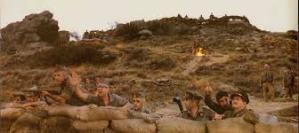 Just by chance today I came across the interesting 1985 film on the Spanish Civil War, “La Vaquilla”, or “The Little Cow”. It is in actual fact a comedy by Luis Garcia Berlanga but it is quite good for the uniforms and the front line activities of propaganda and is well worth watching even if you do not understand Spanish. I particularly enjoyed two of the three T26 tanks that drive into the village Placa Mayor! Anyway, enjoy this film if you have time. http://www.youtube.com/watch?v=fxe5jZx-Pmc&feature=youtube_gdata_player
Just by chance today I came across the interesting 1985 film on the Spanish Civil War, “La Vaquilla”, or “The Little Cow”. It is in actual fact a comedy by Luis Garcia Berlanga but it is quite good for the uniforms and the front line activities of propaganda and is well worth watching even if you do not understand Spanish. I particularly enjoyed two of the three T26 tanks that drive into the village Placa Mayor! Anyway, enjoy this film if you have time. http://www.youtube.com/watch?v=fxe5jZx-Pmc&feature=youtube_gdata_player  On an aside, the running T26 in Nationalist colours that appears in the new Catalan film, “El Bosc”, will hopefully appear in working order at the Fayon re enactment of the Battle of the Ebro on July 27th this year. But in Republican colours this time!
On an aside, the running T26 in Nationalist colours that appears in the new Catalan film, “El Bosc”, will hopefully appear in working order at the Fayon re enactment of the Battle of the Ebro on July 27th this year. But in Republican colours this time! 
Scene from “El Bosc” with the running T26 tank in Nationalist colours in the background with a bunch of nasty Moors!
_________________________________________________________ 15th March 2013. The Retreats 75 years ago today…. I set out below a transcription of a report by Edwin Bee who was in charge of the Topographic unit of the XV Brigade and his experiences in the Retreats. This time today the survivors of the XV Brigade had retreated to Caspe and then held the town for two days. I have written in detail about the Retreats on the Great Retreats page on this blog (well, there’s a surprise!). Just pan down that page and you can see the evidence that is still there today. To set the events in perspective, here is a map to help orientate you.
(from Richard Baxell’s “British Volunteers in the Spanish Civil War”).
Edwin Bee writes: Spent most of the night hanging round a casa on the Alcaniz to Hijar road. The battalion are about 7 kilometres outside Hijar. About 6 o’clock instructions come through to see Major Merriman. The Brigade HQ is a splendid dugout carved into the side of the cutting which road runs through. “Croques” (maps) are wanted of our position for the Division and the Artillery. The British battalion and the Mac Paps are merged into one Battalion under the command of ……. And the Lincolns and the 24th into one battalion, even so, they are nothing like full strength. There is a small town on our right flank, nobody knows whether it is ours or not. Avion came over several times and machine gunned the road. Somebody potted at one of the strafers with a rifle, and hit it with the second bullet. The pilot hurried for home, smoke pouring from the engine. We got one in the evening with a machine gun. Jackson (Burt Jackson) and I spent the whole night sketching out rough fire plans of the line. The cols are so steep a fly couldn’t crawl up, and the cross fire well arranged, so that I think our position impregnable, but there is no news of who is on the right flank- if anybody! 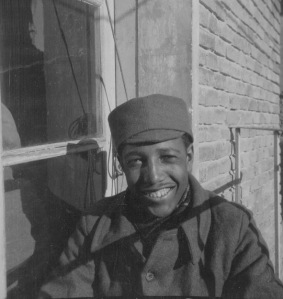
Burt Jackson
The 15th International Brigade Photographic Unit Photograph Collection ; ALBA Photo 011-0667.Tamiment Library/Robert F. Wagner Labor Archives. Elmer Holmes Bobst Library, 70 Washington Square South, New York, NY10012, New York University Libraries.
Spent most of the night going over the left flank with Dunbar and the Captain of the Genie (engineers), a splendid person, whose name I can never remember (Egan Schmidt). Our extreme left to the rear flattens out to a sort of undulating table land, where we have no forces, apparently.
Enemy cavalry had come across during the afternoon, but was put to flight with our tank guns and artillery. Dunbar does the best he can with what remains of the Dimitrovs in a wide semi circle to our rear. 4.am. The order has come through for us to retreat. Burnt the sketches I had spent the whole night doing! We are to march to …… and the retreat to be covered with tanks and aircraft. Everybody is dog tired. The road is one long line of marching men as far as the eye can see. Three kilometres outside the Fascists had just cut the road as I arrived with machine gun fire and shells. Everybody is making east across the fields, and a blue two seater in front of me makes a rough going of it, but keeps going. The 13th Brigade are having difficulty with their heavy machine guns, we run all out until we make the hills to the left of ….. I chuck away my overcoat, but keep my blanket. After a couple of kilometres, I luckily strike the British battalion resting. They have been pretty badly strafed by Avion. Major Merriman and Captain Dunbar and Johnny Gates turned up. Warbrick (kia Hijar, 15th March 1938) and Hughes were also there, and we couldn’t help shaking hands, the others were still in the land of the living. (Warbrick however, was very lame, and was last seen sitting at the side of the road, ten or so kilometres further on).. The decision was made after consultation with the 13th Brigade to march over the mountains to Caspe. If Caspe was in the hands of the enemy, we were to try to cut the road. Four tanks preceded the British Battalion, and then the Lincoln Washingtons and the Mac Paps. Four tanks brought up the rear. Innumerable halts were inevitable on the way ,while the Scouts laboriously climbed one observation post after another. An amusing incident happened in entering Caspe, when one of our tanks suddenly rattled round the corner of the road, swung its gun at point blank range, and stopped. For a few moments the situation was ticklish, however, Major Merriman, who was leading, had the presence of mind to march straight ahead without hesitation. During the retreat Captain Dunbar gave us a botanical lecture on the tiny flower that apart from its size, identically resembles a daffodil, which grows on these mountain slopes. 
Malcolm Dunbar
When ten kilometres outside Caspe, Commissar Gallo who had raced ahead, in his car, brought back the news that Caspe was still in our hands. The news spread from lip to lip, and about 9.30 we marched into Caspe, singing “It’s a Long Way to Tipperary”, “Armentieres” and the Hunger Marchers Song. Peasants told us, however, that Fascist spies had boasted Caspe would be theirs by tomorrow. The town was deserted, with broken masonry and window panes, twisted balconies and bedsteads. Tangled telephone wires made progress in the dark streets difficult. Houses were allotted to the Battalions, search parties sent out for food, and scouts detailed for “another night up.” Very soon the square looked in the moonlight, like a gigantic Barcelona café. In the middle anis and other expensive liquers were served from a bar rigged up on packing cases. Everybody smoked quite decent cigars, cracking nuts and eating oranges. The Topographical Dept. made itself comfortable in a very nice flat with all the modern conveniences, including feather beds! At 4 o’clock marched 1 kilometre out of Caspe and finished our sleep in an olive grove. This morning about 9.30 the Brigade moved up to the line, everyone had the worst foreboding. I was ordered with two Spaniards to stay with the HQ dump. A tree near the road in the corner of the olive grove we camped last night. No sooner had the battalion moved up then the strafing started. All day long we had hardly a moment’s peace. Every inch of the grove was strafed for about a kilometre. After a time we got so tired of running for ditches we sat in a small caseta nearby. A women and her daughter were packing ready to move. She said she wasn’t afraid of the Avion. I thought it was just as well! He daughter, about eighteen, slept through most of it. At 4 o’clock news came through that the Brigade was retreating to our right. One of our scouting parties had just come in from the left flank, having seen nothing of the enemy. Reports from camion drivers became very confused. No traffic came down the road for an hour, so we decided to do a circular movement north eastwards, as a safety precaution. After an hour, our observers reported traffic on the road, so we returned. False news once again! We attacked last night. The Lincoln Washingtons captured a small hill and saw Fascist Genie. Spent the whole night observing on the left flank with Jackson, and the Brigade photographer. Sleeping in ten minute spells. We got a machine gun working, and drew their fire for a bit. Caspe is built on the edge of a large basin, about five to ten kilometres in diameter. The Fascists hold the hills opposite, across the bowl of the basin. I think if they get artillery up tomorrow it will be impossible to live or move in front of the town. Wonderful to say that hot food came up, with coffee and cognac! We have at last bid adieu to Caspe! A perfectly shocking day and night. About 7 o’clock in the morning the Brigade HQ and the English Battalion moved into reserve positions about a kilometre outside of Caspe. Brigade HQ was a very fine dugout under the second hill by the roadside. For some unknown reason they plastered this particular hill and strip of road with shell fire all morning and afternoon. At about 9 o’clock the battalion who had relieved the English gave way, and for a quarter of an hour the situation was very ugly. Technicians were ordered to the rear, the rest of the staff, officers and men were told to get rifles and as much ammunition as we could and to “stand to.” However the shells were now coming over seven or eight a minute, so there was no immediate danger of an attack. My job was to question all traffic on the road, and send down all soldiers from Caspe up the line again, and short circuit ammunition carriers to a new dump we had. Our tanks were constantly coming back for ammunition. I suppose I was standing in rather too soldierly a stance (our sentries usually lean on their rifles or even sit down). Anyhow a tank suddenly stopped about twenty yards from me, the gun turrets revolved the gun and pointed at me. Had the gunner mistaken me for a Fascist? A cold shiver ran down my spine, and I glanced casually at the gun. God! And then equally casually at a shell bursting nearby. After an eternal ten seconds the gun turret again turned towards Caspe, and the tanks passed. I had the grace to salute! 11 o’clock. For a quarter of an hour a battle has been going on two kilometres or so behind us on our left flank. Observers are instructed to report every five minutes, and Lieut. XYZ goes into the olive groves on the left to watch events. Half an hour later the road is cut behind us, and we retreat up the hillside. The top of the hill is a small table land, about a kilometre across to the valley the other side. We are, of course, observed and shelled, but there is no alternative way, and we have to run for it. Vicky Shammah is sent with then order for the battalions to retire. I am set out on scouting ahead. The Ebro winds its broad strip of silver through the olives below. Caspe straggles down the hillside on the left. Part of the railway bridge across the Ebro (Guadalope) is destroyed, the great girders bent in fantastic shapes. I choose a hill which commands the valley, and with a good view of the Caspe-Fraga road. A shell drops quite near me! They’ve chased us with their artillery for two kilometres. Whizz over my head. Where did that one go? Two kilometres on the other side of the river. Whatever can they be shelling over there? Must be our territory still, which is north. Hullo, who are these four chaps in single file? Might be an enemy scouting party. Better keep low. No glasses, too far away to be sure who they are. All by myself, too risky to challenge them. God, it’s hot, the white glare makes you sleepy too. Hullo, that’s somebody coming my way, I’ll get my rifle on him. Think its one of our chaps, I’ll scare the wits out of him! Walking in the wrong direction, must be lost. “Alto”… He nearly jumped out of his skin. I direct him to Brigade HQ. Hour after hour, 5 o’clock I should think. I’ll go and report. Climbing the hillside, I hear a voice. “We must make one more attempt to hold the line. The Government calls upon us to give the Fascist every possible resistance under our circumstances.” I recognise the voice, Johnny Gates, Political Commissar of the Lincolns. How strange the echo of his voice on the mountain. So we are going back, I think to myself, and to try and stifle the conviction that its madness. I am told to bring up the rear with the stragglers. There is some diffidence about crossing the plateau again, although it is nearly dusk now, so I agree to find the way round. Some want to keep off the road and go through the olive trees; however, I stick to the ditch, and a shell drops in the trees; I can’t resist turning round and smiling grimly at the others. Somebody wants water ao we cross the road to the stream. Shells drop here every minute, so we have to be quick. I have to take the chaps up to Lieut. H. on the first Plaza and then return. Halfway there we find a dozen of our fellows with Lieut. H. defending the left side of the road… another break on our flank! This morning we moved off at 7 o’clock in two camions! Dunbar remarked it solved our transport problems as we usually needed forty! However, ten kilometres along the road we struck what was left of the English, Lincoln and Mac Pap battalions, about 300 chaps altogether. After coffee (all the kitchens were captured except the Brigade kitchen) we moved off to the olive groves about seven kilometres outside Batea on the Gandesa road. We had to commandeer various camions that were passing. Transcribed from the Edwin Bee Memoir. Marx Memorial Library, Box 50, File Be/Be1 
Edwin Bee standing to the right of the door in the officer’s cap with members of the Topographic Unit taken at Batea near km 63 in late March 1938 just after the Retreat described above. The African American Burt Jackson is standing far left.
The 15th International Brigade Photographic Unit Photograph Collection ; ALBA Photo 011-0302.Tamiment Library/Robert F. Wagner Labor Archives. Elmer Holmes Bobst Library, 70 Washington Square South, New York, NY10012, New York University Libraries
Sadly, Jason Gurney as a Brigade observer in his excellent book on the early days of fighting, Crusade in Spain, describes Edwin Bee at the Jarama front on the Brigade staff. I worked all day under the tutelage of the abominable Bee, who enjoyed the title of Brigade Cartographer, and loved every minute of it. He had completely reverted to the world of the petty and oppressive bureaucracy from which he had sprung, demanding respectful subservience to himself in the name of the Cause, on which he constantly delivered the most boring lectures. I suppose that he was a useful and sincere individual after his fashion, but he was a product of his environment, which was characteristic of everything I hated most. Jason Gurney, Crusade in Spain. 1974, Faber & Faber. p. 130.
________________________________________________________
12th March 2013. The 75th anniversary of the 3 day consecutive bombing of Barcelona, 16th to 18th March 1938.
I am going to commemorate this anniversary a few days in advance for visitors to this blog to consider as we approach the 75th anniversary of a massive three day bombardment of Barcelona by Italian bombers between March 16th and 18th 1938. This should be a time to pause and reflect on the birth of the horrors of the bombing of civilian targets and the development of such terror and destruction in the Second World War. At the end of the Spanish Civil War, the British government analysed the effects of the bombing of Barcelona to work out how many ambulances, hospitals and aid London might need should it be bombed by the Luftwaffe. Luckily they over estimated the casualties, but they named the report as “The Barcelona Effect”. Sounds more like a bowel movement caused by a laxative than the horrible results which in some places in Barcelona are still visible.
Here is a photo of one of the bombing raids which occurred on the 17th March 1938:
Herbert Matthews reported the destruction caused by one of these bombs (the big explosion in the photo) as having been caused by a top secret “liquid air bomb”. However, in actual fact, one of the bombs had landed on an ammunition truck, causing the huge explosion seen in the photo above.
Here is the result of that bomb by the Coliseum Theatre on the Gran Via close to where the ammunition truck exploded (where there is now a memorial to the victims of all bombings):
Here is a link to a Catalan tv report on a recent Catalan film, “Mirant el Cel” by Jesus Garay, with a recreation of this raid. I believe that there were five Savoia 81 bombers in this raid rather than four here, but the effect is impressive nonetheless. I am mesmerised by the bombs gracefully falling out of the bomber. I know those streets underneath!
http://www.youtube.com/watch?v=a9yGy52V6RY&feature=youtube_gdata_player
More importantly, here is a link to a propaganda film made by the Catalan Generalitat which has only recently been discovered, called “Catalunya Martir”. It is also in French, but the images speak for themselves. Tonight I am attending a commemoration of the 75th anniversary of the bombings in Barcelona.
http://www.youtube.com/watch?v=34702-gGwTI&feature=youtube_gdata_player
As a footnote, I add this photograph of some of the thirty children killed in Placa Sant Felip Neri on January 30th 1938. If you visit this Placa you can still see the effect of the bomb on the walls of the church. A 250kg bomb fell here at about 10am on Sunday 30th January 1938 killing 42 people. The refugee children were in a Guardaria (a nursery) in the church when the bomb fell. The urban legend during Franco’s time was that the damage to the walls was caused by anarchists executing Nationalist sympathisers in the first days of July 1936. But that, I feel is a lie. Sorry to put this graphic photograph here, but war is not beautiful.
And here is a then and now shot of Placa Sant Felip Neri.
_________________________________________________________
NEWS. 10th March 2’13
75th Anniversary of the start of the Great Retreats from Belchite of the XV International Brigade
Today is the 75th anniversary of the start of the Great Retreats and in order to remember the men who were killed in this Retreat I add a link to a piece of research (in English) into the unpublished autobiography of Spaniard Fausto Vilar Esteban. His as yet unpublished memoirs are an incredible source of information and probably the only autobiography by a Spaniard in the International Brigades. Historians Jamie Cinca and Samuel Basterra are to be thanked for providing this account. Please read it and consider the men who are still lying in the Spanish soil, unknown, but hopefully still remembered.
http://faustovillar.blogspot.com.es/2012/11/4-km-in-belchite.html
_________________________________________________________
9th March 2013.
Today I was interviewed by Nigel Richardson of the Daily Telegraph for a travel piece on Orwell in Barcelona to be published on or around the 75th anniversary of the publication of Orwell’s “Homage to Catalonia” on April 25th 1937.
We ate later at a very nice restaurant called “Caracoles”, or the “Snails”. The reason being that it is not just a very nice restaurant (but a bit out of my price range, though Nigel kindly invited me. Thank you Nigel!), but that a letter from American Lois Orr describes it in detail. Here is her letter:
Letter written by Lois to her family on 4th January 1937.
The place has hardly changed and if you ask Aurora, the grandaughter of the owner who ran the place then, she can put you on the balcony where Lois Orr and John McNair, aswell as possibly Eileen Blair (Orwell) sat, watching the cooking in the kitchen below. Well worth going to if you can afford it. However, I am glad that I had eaten beforehand as I am afraid to say that the snail in the photo looked to me rather phallic! It must have been the wine that we drank? Maybe it brings good luck if you touch it? Or fertility???? Lets not go there, shall we?
_________________________________________________________
4th March 2013
“International Brigade Sites in Central Madrid: the Spanish Civil War” by Ken O’Keefe.
Just a brief mention of a new guidebook that has been published by AABI (www.brigadasinternacionales.org) in Madrid. This small, compact, but very handy guidebook only measures 15 by 10.5 cms, but is packed with useful information for three routes by foot through the bustling Capital of Spain in connection with the International Brigades and the Spanish Civil War. Published in both English and Spanish editions, a good quality colour map is also provided with three routes to follow , being Red (the route of the XI Brigade from Atocha railway station to University City on November 8th, 1936), Yellow (Hotels and locations associated with the International Brigades) and Purple (other locations representing the international support to the Spanish Republic during the Spanish Civil War) routes to discover. Eighty pages and illustrations of relevant buildings in colour, I highly recommend it to all those who are planning a weekend trip to Madrid. But how you can obtain a copy on arriving in Madrid, I am not sure. Priced at only 5 euros it would be an inexpensive guidebook that will fit snugly in your coat to explore the hidden history of the International Brigades in Madrid. Maybe the International Brigade Memorial Trust (www.international-brigades.org.uk) might take some to sell at their many events throughout the year? They are offering more and more merchandise bit by bit. Maybe ask them if they would stock it?
____________________________________________________________
The ambush of the British Battalion at Calaceite on March 31st 1938
Bob Cooney, British Battalion commissar at the Calaceite ambush.
At dawn next morning we passed through Calaceite, led by a Spanish lieutenant who was to guide us into fortified positions which , he assured us, were a kilometre and a half ahead. We marched in artillery formation, one file on each side of the road, with scouts ahead of us and on both flanks though we had little expectation of danger, our positions being a kilometre and a half ahead. But we felt uneasy. Things were too quiet. And we began to notice things which we had learned to associate with a retreating army-abandoned blankets-a tin of jam etc..
Then it happened- more suddenly than anything I had ever experienced. A column of tanks rounded the bend ahead of us and ran between our files. “Of course they’re ours!” we thought. Weren’t our positions still a kilometre ahead? In any case no alarm had been given by our scouts-for a very good reason, they were dead or captured.
We were soon disillusioned. With terrifying suddeness the tanks opened fire on us. Another group of tanks emerged from the wood on the right, and simultaneously hordes of Italian infantry appeared yelling their heads off. It was a shambles! Many of us in No. 1 Company owed their lives to the fact that we were so close to the tanks that the enemy guns could not be trained down to us.
Captain George Fletcher who held temporary command of the Battalion at the time of the ambush
“Use your rifles and make for the high ground” shouted Fletcher. We fought our way up the hill while the tanks ran backwards and forwards on the road, their machine guns barking viciously. Screams came from the ditch where several comrades were being massacred.
Bob Cooney. Proud Journey. Unpublished manuscript. Marx Memorial Library.
In Richard Baxell’s excellent new book on the British in Spain, “Unlikely Warriors”, an intriguing sketch of the ambush at Calaceite by an “unknown British volunteer” appears. Having now studied the sketch in greater detail, three names appear in the sketch- Wally Tapsell. Bobby Walker and Joe Fuhr. In the bottom right is the signature of the artist, which I believe is Joe Fuhr, judging by the writing.
Yesterday the photograph below was taken at almost the same location as where the sketch was made. We believe that this sketch was made some time after the event. Possibly by Joe or whoever the artist was in more peaceful times? I am trying to locate the sketch and to understand better who it was from and when it was passed to the Marx Memorial Library.
Sadly, I am not at liberty to put the sketch up on this blog to allow you to make an immediate comparison, but for those who have the book, please compare the photograph below with the sketch in the book. And for those who have not yet got the book. I urge you to consider buying it. At only twenty five pounds (and cheaper at Amazon if you wish to support that company) for a hardback book, it is very good value.
Photo taken at almost the same location in Calaceite as the sketch in Richard Baxell’s “Unlikely Warriors”. Bobby Walker and the wounded in the bomb crater are at the grey building across the other side of the road. Wally Tapsell et al are at the curve where the road disappears to the left. (Anna Marti)
_________________________________________________________
3rd March, 2013
Ken Loach’s “Spirit of ’45” film to be released on March 15th
Though not directly related to the Spanish Civil War, I feel that this film has a relevance to the hopes and dreams of the British Brigaders who served in Spain. Sadly, it may not hold much interest to other nationalities reading this page, but I wish to raise British people’s awareness and to ask them to pass it on, as for me, this is a film which hopefully shows the great possibilities that occurred (and seem almost to have been lost in the recent past by both New Labour and Conservative governments) by the Labour Victory of 1945 and the radical changes in British Society including, amongst other major plans, the Nationalisation of state industries and the formation of the National Health Service.
I don’t want this…..
Here is a link to a review in today’s Observer about the film:
http://www.guardian.co.uk/film/2013/mar/02/spirit-45-ken-loach-nhs-history
And here is a link to the film website:
http://www.thespiritof45.com/All-About-Ken-Loach
To my shame, my grandfather, who was a doctor in 1948, did not agree with the formation of the NHS and emigrated to New Zealand. My Father, however, was one of the first dentists to practice in the NHS after graduating in 1948, and when he retired was also sadly the last dentist in his area to still have NHS patients whilst the rest of his colleagues had gone private.
I want this. And you?
The gradual destruction of the NHS which helped rear me and care for me, the rampant profits made by those who already have enough money to live more than comfortably and the destruction of what was meant to be a more just system of society started by Attlee’s Labour government after the horrors of the Second World War, is something I feel ashamed of. It is not right. Of course, it was not perfect, but the best of intentions were there by harnessing the resources for “the common good”. I feel almost angry, but certainly very sad to see the destruction of the principles of what was started then, and I hope that this new film by Ken Loach covering that pivotal moment in British history will be shown to as many people as possible in the UK and to make them realise that even after a costly war, with no money per se, that the Labour government made dramatic changes for the common good.
Clement Attlee wining the 1945 General election
Please tell your friends and pass the word. The film will be released on March 15th and on March 17th there will be a live broadcast discussion in cinemas showing the film with Ken Loach and others about the film. Sadly, I will have to wait till the dvd comes out as I live in Spain, but I look forward to seeing this programme greatly.
Nye Bevan. Founder of the National Health Service in 1948. What did he call the Tories?
“That is why no amount of cajolery, and no attempts at ethical or social seduction, can eradicate from my heart a deep burning hatred for the Tory Party that inflicted those bitter experiences on me. So far as I am concerned they are lower than vermin.”
3rd July 1948 at the Bellevue Hotel, on the eve of the start of the National Health Service.
_________________________________________________________
21st February 2013.

Possible photo of Mac Pap Percy (or Perry) Hilton, the sole survivor from the Mac Pap machine gun crew and squad of riflemen, captured at Azuara on 11th March 1938. He survived because the situation after his immediate capture was defused by the Nationalists putting the tall Hilton beside a short Nationalist soldier and laughing at him? I only have two blurred distant photos of Percy Hilton (one on the back of the kitchen lorry of the Mac Paps), but I think these might be Percy and the short Nationalist soldier? What is odd, is the “ghost” face to the right of Percy on the wall! Probably a double exposure?
Two 75th Anniversary Events concerning the XV Brigade and the Great Retreats. 30th to 31st March 2013.
It gives me great pleasure to announce two events over Easter that may be of interest to readers. Firstly, the 75th anniversary March to remember the Retreat of the Lincoln Washington battalion between March 31st and April 2nd 1938 and the death of, amongst many others, Robert Merriman, which will take place starting in Batea and finishing in Corbera on Saturday 30th March 2013.
Secondly, a small commemoration very early on Sunday 31st March 2013 at Calaceite where the British Battalion was ambushed by the Italian CTV.
Action shots. Batea – Gandesa, April 1938
The 15th International Brigade Photographic Unit Photograph Collection ; ALBA Photo 011-0332.Tamiment Library/Robert F. Wagner Labor Archives. Elmer Holmes Bobst Library, 70 Washington Square South, New York, NY10012, New York University Libraries
Saturday 30th March 2013. 75th Anniversary of the Retreat of the Lincoln Washington Battalion 1st to 2nd April 1938
On Saturday 30th March, 2013 a commemorative Walk to remember the 75th anniversary of this part of the Retreat under the guidance of Catalan historian Anna Marti, has been organised from Batea to Corbera (a walk of 30 km/20 miles) following the approximate route made by the Lincoln Washington Battalion in 1938 during their Retreat. The starting point will be at Venta de San Joan, north of Batea, at 9:00 in the morning (directions on request). The route is divided into different stages, for those who only want to do part of itinerary. It will also have a four wheel drive vehicle to pick up those who feel tired. Various memoirs will be read and discussed at relevant points on the walk, and Anna Marti will be happy to discuss her research while on the walk. The walk should end at Corbera at about 6.00pm with a vehicle to take drivers back to collect their cars from the start point. All are welcome to join this Walk.
It is necessary that participants bring appropriate walking shoes, clothing appropriate to the climate, liquid refreshment and picnic lunch and to have informed that they wish to join the walk by sending an email with the number of attendees to Alan Warren at pdlhistoria@gmail.com Please note that this is just an informal walk and not organised as such. You will have to be responsible for your own health and safety on the walk. But you will be in good company!
Action shots. Batea – Gandesa, April 1938
The 15th International Brigade Photographic Unit Photograph Collection ; ALBA Photo 011-0333.Tamiment Library/Robert F. Wagner Labor Archives. Elmer Holmes Bobst Library, 70 Washington Square South, New York, NY10012, New York University Libraries
Here is a link to Anna Marti’s paper on the Reteats that was published in the September 2012 issue of “The Volunteer”.
http://www.albavolunteer.org/2012/07/in-the-footsteps-of-the-lincoln-washington-battalion/
Sunday, 31st March 2013. 75th Anniversary commemoration of the ambush of the British Battalion at Calaceite.
A rededication of the Memorial to the British Battalion at Calaceite with Alan Warren will take place at 0700 (!!!) on Sunday 31st March on the same date and at almost the same time (daybreak is at 0730) as the action 75 years ago. This will just be a small event, and afterwards breakfast in the village. Later the memorial to Robert Wardle and James Bentley in Calaceite cemetery will be visited to place some flowers there. The rest of the day can be spent visiting other relevant locations connected with the route of the Retreat of the XV Brigade to the Ebro for those interested (including Hill 481 from the Ebro Battle, which was where Walter Gregory and Malcolm Dunbar with other brigaders held a line of defence in April 1938 before retreating to Cherta!). Directions can be provided and advice on places to stay can also be offered. This will need individuals to make their own way by car. The Ebro Battlefield is also possible to visit as it is right next door. I will be on the Ebro until April 2nd exploring various locations on the Ebro battlefield if people wish to tag along, depending on their interests.
Action shots. Batea – Gandesa, April 1938
The 15th International Brigade Photographic Unit Photograph Collection ; ALBA Photo 011-0331.Tamiment Library/Robert F. Wagner Labor Archives. Elmer Holmes Bobst Library, 70 Washington Square South, New York, NY10012, New York University Libraries
Directions for both events can be provided on request to those who wish to attend by writing to Alan Warren on pdlhistoria@gmail.com We look forward to seeing people over this important weekend.
_________________________________________________________
21st February 2013.
Something to occupy the children when they are bored…….
Ummm. I put this link up realising that some may take slight offence, but I dont care! Basically this is a link to a page with modern cut out drawings of various vehicles, tanks, planes and troops of the Spanish Civil War. It may not appeal to everyone, but the tanks look quite impressive. And before people moan, the history of cut out figures before, during and after the Spanish Civil War is immense and deserves looking at. But anyway, if people wish to print these illustrations out please use blunt scissors with adult supervision, and that includes you adults! And it beats Play Station by miles by actually making something! Have fun!
http://www.juniorgeneral.org/index.php/figure/figureList/early20th#48
The book to get is Soldados de Papel. Recortables de la Guerra Civil, 1936 1939 by Editorial Salvatella. It is still available at a very reasonable reduced price of about 4 euros in certain outlets in Barcelona.
A few years ago an excellent exhibition was held in the Museu Historia de Catalunya on this subject.
The catalogue for the exhibition was quite impressive and still available from the museum shop at 15 euros. These are just illustrations and not appropriate to actually cut out. In fact, I would love to produce these as facsimiles for enthusiasts. Anyone else interested?
Here is a review of the exhibition.
And just out of curiosity, below is a Nationalist 1939 cut out model of Shirley Temple giving a fascist salute! But I like the flamenco dress!
_________________________________________________________
20th February 2013.
Alun Menai Williams, Spain, May 2005
Alun Menai Williams would have been 100 years old today!
I just wanted to write about an old friend who sadly passed away in July, 2006. Alun Menai Williams would have been 100 years old today and I wanted to remember him, but also to share the memory of him with readers of this blog.
Alun was a Welshman after having been torpedoed off Malgrat de Mar on May 30th 1937, swam to shore and subsequently served as a medic with the Washington, Garibaldi, Lincoln Washington and British battalion from the battle of Brunete in July 1937 through to the Ebro in the summer of 1938. I knew Alun very well, and in May 2005, he returned to Spain to unveil the memorial on Hill 705 to the British battalion members killed on the Ebro. A programme was made on his return to Spain for BBC Wales, which may be about (it was shown thirteen times in the UK!) and also a version was shown on Catalan tv too. Alun was very pleased to see that he could speak perfect Catalan in that programme! He spent the last three months of his life in Catalonia and was well looked after by Catalan friends. Here is a photo of him with a great suntan in May 2006!
His life up to the end of the Spanish Civil War was covered in his autobiography “From the Rhondda to the Ebro”
and in Catalan under the title of “I vaig tornar i creuar l’Ebre”.
If readers are after a copy please write to me (pdlhistoria@gmail.com) as I still have some copies available. I hope to restart book publishing sometime in the near future, but I have copies of previous Warren & Pell books if people are curious.
Below is a photo of Alun taken in early July 1937 with his good friend, Billy Davies, in Tarrazona de la Mancha. Sadly, three days later Billy was killed outside Vilanueva de la Canada at the Battle of the Brunete. One of Billy’s antics in London before he went to Spain was to disrupt Oswald Moseley’s Blackshirt meeting was to be held suspended by a ropefrom the dome in the Albert Hall in London and shouting and showering the people below with various CP propaganda leaflets!
Look at David Leach’s excellent programme on Youtube, “Voices from a mountain” for interviews with Alun, especially about Harry Dobson.
http://www.youtube.com/watch?v=-iUIIqn8v58&feature=youtube_gdata_player
I got quite emotional thinking of Alun today. A friend made the comment that we were lucky to have met these incredible people when they were alive, but others now cannot. And, yes, they were incredible people. And like you and I, far from perfect, but with different strengths and weaknesses that you and I have. And that makes them human beings rather than “heroes” (I hope you understand my viewpoint in respect to who are considered “heroes” now) that hopefully many of us can relate to. But perhaps most importantly, they DID SOMETHING rather than cower and prevaricate. That is what makes them special to me. And to you?
Here is to Alun. Happy 100th Birthday! A gentle man!
Alun Menai Williams holding the Clement Attlee No 1 Company flag near Torre de la Fontabella on 18th October 1938. Jim Brewer holds the Spanish Republican flag. Photograph taken by Robert Capa.
_________________________________________________________
8th February, 2013.
The anti tank battery House of Culture in Ambite is up for sale.
“Spain. Rest position, August 8 (1937)
Now we are resting, well out of the war-eating like horses, bathing three or four times a day, sleeping outside and having a good time of it. There was some confusion as to where we were to go, so we set to and found this place for ourselves. There is a mill besides a river, sitting prettily enough among poplars and other trees. I imagine the mill was once privately owned; it now belongs to a workers’ organisation. Nobody lives in the cottage attached to it. We have obtained the keys, and the three rooms on the upper floor now make reading and writing quarters for the Battery. This is my special province. I have enjoyed cleaning out the rooms and finding or improvising what furniture I can to make it comfortable. I have been able to clean up some pieces of fabric-curtains and so forth-that were lying in the house, and I have spread them over our boxes and logs as a gesture at upholstery. Now when you come to sit down, you almost think that you are going to sink into a soft seat. Comfort is suggested which doesn’t really exist. Curious what a difference it makes. I have been able to get hold of one or two posters for the walls- published as propaganda for the better conduct of the war (Some remarkably fine posters are produced out here). I have a photograph of Lenin, which was purchased from elsewhere, and is very striking. A gay little children’s picture found in a box, a map and a dried corn cob complete the decorations on the wall. I like the corn cob- orange and straw colours, a good, crisp shape.” Miles Tomalin to his Mother  I have been informed earlier this week by friends in Ambite that the original “House of Culture” where Miles Tomalin and others of the anti tank battery stayed in 1937 is up for sale. I am sure those who have studied the history of the British battalion will be aware of the significance of this building. The village is a beautiful place, only an hour’s bus east of Madrid and is also of great importance as the Estado Mayor of the XV Brigade was also based in a larger mill just outside the same village between June and December 1937. Numerous descriptions exist which I can provide on request. The plethora of photographs that have been indentified so far is impressive, and there will be more to come in time. Mondejar, where the British battalion was based, is just up the road and Albares where the Lincoln battalion was based beyond that village.
I have been informed earlier this week by friends in Ambite that the original “House of Culture” where Miles Tomalin and others of the anti tank battery stayed in 1937 is up for sale. I am sure those who have studied the history of the British battalion will be aware of the significance of this building. The village is a beautiful place, only an hour’s bus east of Madrid and is also of great importance as the Estado Mayor of the XV Brigade was also based in a larger mill just outside the same village between June and December 1937. Numerous descriptions exist which I can provide on request. The plethora of photographs that have been indentified so far is impressive, and there will be more to come in time. Mondejar, where the British battalion was based, is just up the road and Albares where the Lincoln battalion was based beyond that village.
Mondejar Plaza Mayor
Officers of the British battalion in Mondejar Plaza Mayor following the presentation of the British battalion banner with Bill Rust, 30th November, 1937 (compare the pillars behind).
Last October a group of us visited Ambite to show Miles Tomalin’s daughter, Stefany Tomalin, the anti tank battery House of Culture. We had heard rumours that the building might be up for sale then, and here is a link to details of the property as up for sale.
http://www.idealista.com/inmueble/25480592/ For those curious, in the photos in the notice above, the cottage behind the large “Ali Baba” pots is the House of Culture that Miles describes. The large white building over the other side of the river across the bridge is the Mill where the anti tank battery stayed before and after the Battle of Brunete. The price is a rather mind blowing (550,000€ or £471,500). There is the original “House of Culture” which has been partially renovated and behind over a bridge crossing the River Tajuna is the mill where the anti tank battery originally stayed. This is a large building but would need extensive work to repair. The roof is partially collapsed and the first floor is unsafe. Other outbuildings adjoin. The river Tajuna flows between the Mill and the House of Culture and it is a quite beautiful and restful place. There is also land to the north east of the buildings fronting the main road from Ambite to Mondejar. The land amounts to 2.5 hectares in total. Some sort of planning permission has been permitted to the cottage, but not sure as to the mill. There is a disconnected electricity junction box on the property and a well. I think that offers below the asking price might be accepted. 
The Fabrica across the bridge.
It so happens that the weekend of February 16th and 17th there will be a large number of people interested in the International Brigades at Jarama. It could be the perfect opportunity to visit the actual House of Culture. Line 326 leaves regularly from Madrid to Ambite (http://www.redtransporte.com/madrid/autobuses-interurbanos/326-madrid-orusco-de-tajuna-ambite.html). If someone is brave enough to ask for a visit to the property it could be possible for a group visit if people feel intrigued (and who are either genuinely curious about a possible purchase of the property, or who are honestly curious about visiting this building and can pretend to be a possible purchaser!). Please write to to the advertiser to arrange an appropriate time and place in Ambite in relation to the bus times. We have supportive contacts in the village, but current village politics mean that at present they wish to keep low and not raise attention to themselves. If people are curious to look from the roadside (trespassing laws are very strict in Spain!), I can give directions. Here are descriptions by Miles Tomalin from his letters held in the Imperial War Museum (The manor mentioned below is still there, but access is restricted and I am not at liberty to include descriptions by Miles Tomalin of their stay there, sadly). “Nov. 24,1937. Rest position-point of leaving it, Just now we are in orders to go from the manor in which we have been resting. A pity, for this place has its attractions. We rested in the same valley after the Brunete action. At that time, the battery was quartered in a small mill by the river. There we started our wall newspaper, which has since achieved fame, and is said to rank among the best in the Republican Army. We fitted out an upper chamber in the adjoining cottage as a park (sic?) of culture and rest, improvising furniture out of odds and ends from the Mill. By the time we had finished, it got to look like somebody’s weekend cottage. I found a bird cage there, also some coloured wools. I couldn’t resist the temptation to build a gaily coloured bird out of the wools and put him in the cage. We hung him in the window recess. “ Miles Tomalin to Katharine Monro. I hope that whoever buys the property might allow visitors interested in the anti tank battery’s connection to visit the place. Lets see. In time I will make contact with the new owners and see what can be done. In the meantime, if you have 550,000 euros doing nothing would you like to buy a unique piece of International Brigade history? From Hugh Sloan. p 203. “Voices from the Spanish Civil War” Edited by Ian MacDougall. “We were then taken from Jarama and sent to a place I’m sure was Ambite, where we stayed in a little mill with a fast flowing mill stream. There we had a very pleasant fortnight of rest in preparation for our going into the big battle at Brunete later on. When we were in the mill we had a visit from Professor Haldane. He wore a Durruti cap and a big leather jacket. When he arrived I thought he was a big dock worker from the way he was dressed. He gave us in what Miles Tomalin called the Room of Culture and Rest lectures on what to do in case there would be any gas attack. If we were caught without any gas mask he told us to piss on our hankies and put them over our mouths. 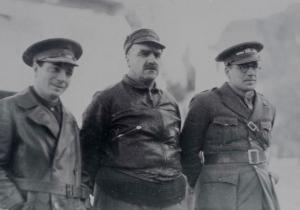
(l-r) Dave Doran, Professor Haldane & Robert Merriman. December, 1937.
While we were at the mill in Ambite Miles Tomalin, who had been at Cambridge University, set up his “Assault & Battery” wall newspaper that became famous among all the International Brigaders and journalists who happened to come by. Miles was a very talented person, a very gentle person, who carved the name of each battle he was in on his musical instrument, the recorder. While doing his ablutions down by the mill stream early in the morning as the sun was rising Miles would play his recorder, which put me in mind of the great god Pan. So I dubbed Miles the Good God Pan, and I drew a cartoon of him with goat’s legs down by the reeds in the river. A fortnight before Miles died in 1983 I wrote him and sent him a similar cartoon to remind him. I had described him as “the unlikely warrior”. Miles wrote back and said, “Hughie, we were all unlikely warriors.” Miles was a very, very talented person, a lovely person, and I regretted his passing. From Ambite we proceeded to positions near Madrid……. When Malcolm Dunbar was wounded and Hugh Slater took over after the battle of Brunete we returned to our little home of culture and rest in the old mill. Hugh Slater expected me to act as a batman who would clean his dishes and look after his own requirements. And I made it quite plain that that was not on for me. I did have some kind of relationship with Hugh Slater on a personal basis, but sometimes we were a little bit antagonistic….. 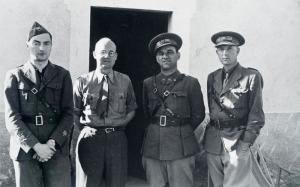
(l-r). Malcolm Dunbar, Bill Rust, Vladimir Copic & Hugh Slater
So after the battle of Brunete we went back to the little mill near Ambite where the British battalion was sheltered. And we were about half a mile away in a mill with a fast flowing mill stream. We took it up as our abode of rest. That’s where Miles Tomalin, our very cultured member of the battery, set up his famous room of culture and rest, in which we entertained people like Jock Cunningham and Professor Haldane and others. We stayed there for a fortnight. It’s strange how immediately an action stops you become completely involved in what you’re doing at the moment and disengaged from what has passed. That fortnight on the mill was a lovely period. But I had to travel with a report every day a kilometre or so back to Ambite, where Brigade headquarters were in a larger mill. And this day I discovered that Major Attlee, the Labour leader, was to visit the Brigade headquarters. I decided to stay as long as I could at headquarters to see Major Attlee making his appearance. 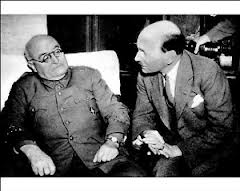
General Miaja and Clement Attlee in Madrid.
Attlee visited the British battalion on December 6th 1937. As he drove into Mondejar Plaza Mayor, the battalion were on parade with torches singing “God save the King”?
Attlee got a bit confused when addressing the battalion at this meeting by wrongly shouting the original slogan from the well known poster printed at the time of the Battle of Brunete (“No Pasaran! Pasaremos! – They shall not pass! We shall pass!”) which became “No Pasaran! No Pasaremos!” (“They shall not pass! We shall not pass!”).
 The emergence from the grounds of the mill took a sharp turn away to the left. So we couldn’t see who was approaching. Word was given to the Brigade headquarters that Major Attlee was on his way. So the whole headquarters staff, including all the commanders, were drawn up to salute to his appearance. I was sitting on the gate waiting on Major Attlee coming and could also see the Headquarters staff drawn up outside the mill, when suddenly round the bend came Segundo. He was a little comical character who was treated with a lot of deference and humour by everyone including the staff. They had I think as a joke made him a corporal. And the corporal’s stripes were a big inverted red v-sign the whole length of the arm. On a big bike rocking from side to side that was meant for a six foot person Segubdo, who was a very little person, about five foot two or three, rode up. Somebody must have carried the joke a wee bit too far and told the staff that Attlee was on his way. But the staff drawn up and expecting Major Attlee, appreciated the humour of the situation. It was a lovely period at the mill and we spent most of the time playing in the fast flowing mill stream because the weather was really terrific. That was the first official rest we had been given since leaving Albacete where the anti-tank battery was set up. INTO THE ARAGON After a fortnight’s very pleasant stay at the mill which still stands in my memory we took our trucks and moved down the road to Valencia on the Mediterranean coast…..” Miles Tomalin’s diary references to the Ambite “House of Culture” (courtesy of Stefany Tomalin): August 16th, Tuesday. The following day we were taken off to the Tajuna valley. Nobody had remembered to find quarters for us. The British battalion was quartered in Mondejar, but there was no room for our battery. We eventually found our own place, and as things have turned out we are now better off then any other section of the Brigade, with the exception of HQ, who are back in a lovely mill where we spent a night on our way up to Jarama. We also have a mill, a smaller place. It was once a factory for making mattresses and the like. We sleep round the Fabrica in the open. We were able to get the keys of the adjoining cottage, and I set myself to civilise the upper floor and turn it into a Rest Room. It took some cleaning out, but I enjoyed it, and still enjoy looking after the place. I sweep it out every morning, keep fresh water and vino up there, arrange newspapers and so on. The furnishings was a problem, but I managed with bits and pieces from the fabrica, and such textiles as I could find and now the room suggests a greater comfort than it possesses. It looks quite well. In one corner I have a seat made of wooden mill-machinery and an old window panel, upholstered with what may have been a curtain; and beside the seat, a huge glass bottle such as the Spaniards carry vino in, which I use as a standard candle lamp, The effect is real Tottenham Court Road. There is a dynamo in the Fabrica, and now we have it working, so that candles are only necessary when the system breaks down. Having arranged the room, I started a wall-newspaper. It has become so successful and is so well-supported that its fame has spread through the Brigade. Aitken (Brigade Political) talks of taking the first number home when he goes. I have packed it up and left it with Brigade. I hope Aitken gets it. Meanwhile No. 2 is already a large issue. Needless to say I take real pleasure in all this. This is the sort of work I can do. Presently we shall have to pack up and move off. Back to the war. Damn the bloody war. Yes- and I like the place, mill, village, valley and all. The brief by-road to Ambite is lovely, and to drink in the village of an evening is pleasant. This is better, far better than Madrigueras, and that wasn’t too bad. A river- in and out of it just as impulse takes you, no walk, long or short-that, too, is good. We arranged a concert one night. Jock Cunningham came over. A great little man, who can mix with the men on equal terms and not lose his authority-an accomplishment. We have been visited by Paynter and Horner. Our morale seems to have held out better than the battalion’s, and we get credit for this. I think the infantry must have had an even beastlier time than we did…….. August 29th (Sunday) ……I may not have mentioned that Frank Quinlan killed himself near our Ambite fabrica by diving into the river and hitting his head against a stone. That was before he had even seen any action……. November 29th. Wed. … Since leaving Quinto we have been resting in Ambite; not in the fabrica, which has no fireplace, but in a local manor, which we share with the Genie (engineers) and Transmissions.” From “The Heretics; A novel” by Humphrey (Hugh) Slater. Harcourt, Brace & Company New York. 1946. Page 170. “At Ambite, thirty miles from the front, there was a flour-mill under the trees on the Tajuna river. The mill pond was ten feet deep and clear and cold. The battery was billeted in the mill-house and there were no troops near them. It was mid-summer. Their orders were to rest and bathe and to sleep in the afternoons. In the evenings some would walk to the village, a mile away across the olive-fields, and drink sweet champagne with the Castilian peasants. Fat pigeons in the trees cooed every evening and in the early mornings,………. When they had been at the mill for ten days Simon received, by dispatch rider, an instruction from the Brigade commander to be available for a personal conversation with a senior officer who would be arriving at the battery position at three o’clock. Some days before, Simon had been cited in Brigade orders for valour and responsibility in the Trunete (Brunete) battle. He had been congratulated on the way he took command of the guns during the retreat and had been commended for his behaviour in general. When he read the instruction he rather hoped he might be going to be commissioned and confirmed in his command of the battery. A tall man in polished riding-boots and a clean white cricket shirt arrived punctually at three. He left his car at the bridge to the mill and walked over to where Simon was waiting for him. Simon saluted and the visitor smiled and shook hands. They walked away together towards the house but the officer suggested a stroll along the river bank. When they were out of sight of the troops Simon was shown the visitor’s credentials: his name was Mikolin and he was the leading functionary of the political police organisation which was known as the SIM. For about five minutes the SIM-man made friendly conversation about a yellow spotted butterfly which was fluttering close to the surface of the stream; he said he could not remember its name, but was inclined to think that strictly speaking it was a moth. Then he said Simon had been recommended for transfer to SIM and asked how he felt about it…… After an hour’s conversation about the work, which was in connection with the fight against Trotskyism among the foreign volunteers in Spain, Simon and Mikolin walked back to tea on the grass verge by the pond, under the trees where the pigeons were. They had agreed that Simon should begin work immediately and should be transferred from the Brigade to SIM headquarters in Barcelona within three days.”
The emergence from the grounds of the mill took a sharp turn away to the left. So we couldn’t see who was approaching. Word was given to the Brigade headquarters that Major Attlee was on his way. So the whole headquarters staff, including all the commanders, were drawn up to salute to his appearance. I was sitting on the gate waiting on Major Attlee coming and could also see the Headquarters staff drawn up outside the mill, when suddenly round the bend came Segundo. He was a little comical character who was treated with a lot of deference and humour by everyone including the staff. They had I think as a joke made him a corporal. And the corporal’s stripes were a big inverted red v-sign the whole length of the arm. On a big bike rocking from side to side that was meant for a six foot person Segubdo, who was a very little person, about five foot two or three, rode up. Somebody must have carried the joke a wee bit too far and told the staff that Attlee was on his way. But the staff drawn up and expecting Major Attlee, appreciated the humour of the situation. It was a lovely period at the mill and we spent most of the time playing in the fast flowing mill stream because the weather was really terrific. That was the first official rest we had been given since leaving Albacete where the anti-tank battery was set up. INTO THE ARAGON After a fortnight’s very pleasant stay at the mill which still stands in my memory we took our trucks and moved down the road to Valencia on the Mediterranean coast…..” Miles Tomalin’s diary references to the Ambite “House of Culture” (courtesy of Stefany Tomalin): August 16th, Tuesday. The following day we were taken off to the Tajuna valley. Nobody had remembered to find quarters for us. The British battalion was quartered in Mondejar, but there was no room for our battery. We eventually found our own place, and as things have turned out we are now better off then any other section of the Brigade, with the exception of HQ, who are back in a lovely mill where we spent a night on our way up to Jarama. We also have a mill, a smaller place. It was once a factory for making mattresses and the like. We sleep round the Fabrica in the open. We were able to get the keys of the adjoining cottage, and I set myself to civilise the upper floor and turn it into a Rest Room. It took some cleaning out, but I enjoyed it, and still enjoy looking after the place. I sweep it out every morning, keep fresh water and vino up there, arrange newspapers and so on. The furnishings was a problem, but I managed with bits and pieces from the fabrica, and such textiles as I could find and now the room suggests a greater comfort than it possesses. It looks quite well. In one corner I have a seat made of wooden mill-machinery and an old window panel, upholstered with what may have been a curtain; and beside the seat, a huge glass bottle such as the Spaniards carry vino in, which I use as a standard candle lamp, The effect is real Tottenham Court Road. There is a dynamo in the Fabrica, and now we have it working, so that candles are only necessary when the system breaks down. Having arranged the room, I started a wall-newspaper. It has become so successful and is so well-supported that its fame has spread through the Brigade. Aitken (Brigade Political) talks of taking the first number home when he goes. I have packed it up and left it with Brigade. I hope Aitken gets it. Meanwhile No. 2 is already a large issue. Needless to say I take real pleasure in all this. This is the sort of work I can do. Presently we shall have to pack up and move off. Back to the war. Damn the bloody war. Yes- and I like the place, mill, village, valley and all. The brief by-road to Ambite is lovely, and to drink in the village of an evening is pleasant. This is better, far better than Madrigueras, and that wasn’t too bad. A river- in and out of it just as impulse takes you, no walk, long or short-that, too, is good. We arranged a concert one night. Jock Cunningham came over. A great little man, who can mix with the men on equal terms and not lose his authority-an accomplishment. We have been visited by Paynter and Horner. Our morale seems to have held out better than the battalion’s, and we get credit for this. I think the infantry must have had an even beastlier time than we did…….. August 29th (Sunday) ……I may not have mentioned that Frank Quinlan killed himself near our Ambite fabrica by diving into the river and hitting his head against a stone. That was before he had even seen any action……. November 29th. Wed. … Since leaving Quinto we have been resting in Ambite; not in the fabrica, which has no fireplace, but in a local manor, which we share with the Genie (engineers) and Transmissions.” From “The Heretics; A novel” by Humphrey (Hugh) Slater. Harcourt, Brace & Company New York. 1946. Page 170. “At Ambite, thirty miles from the front, there was a flour-mill under the trees on the Tajuna river. The mill pond was ten feet deep and clear and cold. The battery was billeted in the mill-house and there were no troops near them. It was mid-summer. Their orders were to rest and bathe and to sleep in the afternoons. In the evenings some would walk to the village, a mile away across the olive-fields, and drink sweet champagne with the Castilian peasants. Fat pigeons in the trees cooed every evening and in the early mornings,………. When they had been at the mill for ten days Simon received, by dispatch rider, an instruction from the Brigade commander to be available for a personal conversation with a senior officer who would be arriving at the battery position at three o’clock. Some days before, Simon had been cited in Brigade orders for valour and responsibility in the Trunete (Brunete) battle. He had been congratulated on the way he took command of the guns during the retreat and had been commended for his behaviour in general. When he read the instruction he rather hoped he might be going to be commissioned and confirmed in his command of the battery. A tall man in polished riding-boots and a clean white cricket shirt arrived punctually at three. He left his car at the bridge to the mill and walked over to where Simon was waiting for him. Simon saluted and the visitor smiled and shook hands. They walked away together towards the house but the officer suggested a stroll along the river bank. When they were out of sight of the troops Simon was shown the visitor’s credentials: his name was Mikolin and he was the leading functionary of the political police organisation which was known as the SIM. For about five minutes the SIM-man made friendly conversation about a yellow spotted butterfly which was fluttering close to the surface of the stream; he said he could not remember its name, but was inclined to think that strictly speaking it was a moth. Then he said Simon had been recommended for transfer to SIM and asked how he felt about it…… After an hour’s conversation about the work, which was in connection with the fight against Trotskyism among the foreign volunteers in Spain, Simon and Mikolin walked back to tea on the grass verge by the pond, under the trees where the pigeons were. They had agreed that Simon should begin work immediately and should be transferred from the Brigade to SIM headquarters in Barcelona within three days.”
_________________________________________________________
12th January 2013.
Sixth Annual Jarama March. 16th February 2013.
(translated from the Spanish announcement at http://www.brigadasinternacionales.org/)
This year the 6th Annual Jarama March organised by AABI will be held on Saturday 16th February 2013. The March will be dedicated to the French and French-speaking volunteers who fought in this battle. Many gave their lives and their remains lie in the cemeteries of Morata and Arganda or else still lie on the battlefield. The route will begin in the area where the XIV International Brigade fought and will finish (via the American “Suicide Hill”, where the Lincoln Battalion first dug in at Jarama after their arrival on the 16th February 1937, and where the first casualty, observer Charles Edwards, was killed. The circular trench that the Americans hastily constructed on this hill at that time is still visible) at the International Brigade monument west of Morata de Tajuna. The guide will be the expert on the Battle, David Loriente. As always, numerous British, Irish and French friends will also come.
The programme of events begins on Thursday, February 14th and ends on Sunday 17th. For a more detailed description (in Spanish) go to http://www.brigadasinternacionales.org/index.php?option=com_content&view=article&id=331:jarama-2013&catid=37:prosimoseventos&Itemid=70. And if you wish to participate, please follow the instructions at the end of this translation. Below is a translation into English concerning the main Events aswell as the March and locations. PROGRAMME Thursday February 14th. At the Salòn of the Instituto Internacional Americano, C / Miguel Angel, 8 19:00 Presentation of the book by Laurie Levinger in Spanish, ‘Amor y Saludos Revolucionarios: un joven de Ohio en la Guerra Civil española’ (original English title: ‘Love and Revolutionary Greetings: an Ohio Boy in the Spanish Civil War’) and the English version of the guidebook ‘Places of the International Brigades in Madrid’ by Ken O’Keefe. Friday 15th February. Hall of the Ateneo de Madrid, Calle del Prado, 21 18:00 Presentation of the 6th Jarama March. Reading of the paper by the prize winner of the 1st Irish school competition on the International Brigades. 20:00 Celebration of the 76th anniversary of the Victory of the Popular Front Saturday 16th February. Sixth Jarama March. 9:00 Departure of the buses from the front of Hotel Agumar, Paseo Reina Cristina, 7 10:00 March following the route of the XIV Franco-Belgian International Brigade. Starting point and parking at the Restaurant El Alto (Ctra Chinchón 8’4 M-313 km) 13:00 Tribute to Spanish and International Brigaders who fought and fell at Jarama. Location: Monument to the International Brigades west of Morata de Tajuña. 14:00 Lunch at Meson El Cid and visit to the Museum of the Battle of Jarama. 17:30 Visit to the cemetery of Morata 18:30 Return to Hotel Agumar. Sunday February 17th 10:30 Walk from the Casa de las Flores to the monument of the International Brigades in University City. Starting point: Calle Princesa, 72, opposite the metro exit Argüelles Altamirano 12:30 Tribute to the International Brigades at the monument in University City.
To book: Attendance at the march is free and one can come either by car or on the coach organised by AABI. The cost of bus will be 10 euros per person. The lunch at Meson El Cid will cost 25 euros. A coach will return drivers who wish to recover their vehicles left in the car park at El Alto. To book a place on the coach or for the lunch on Saturday, please contact: jarama2013@gmail.com The deadline for reservations is February 10th. _________________________________________________________ 11th January 2013.
“The Life and Death of the Spanish Republic“ by Henry Buckley to be republished after seventy two years.
I am very pleased to announce that the above book is about to be published this April 30th by Tauris Publishing. This incredible book is a very rare find (virtually the entire print run prior to distribution was destroyed during the London Blitz in 1940 and only a few review copies were circulated).
I cannot say how excited I am as to this news. I urge you to consider buying it. I do believe that it is one of the finest appraisals of the Spanish Civil War and its reasons aswell as the events that occurred during the War that one can read. Henry Buckley often accompanied Ernest Hemingway, Herbert Matthews and Robert Capa. Buckley served as the Daily Telegraph correspondent whilst in Spain and his reports in that newspaper are also of great interest.
For an appraisal of Henry Buckley see Chapter 10 of Paul Preston’s excellent book on the Foreign correspondents in Spain “We saw Spain Die“.
Anyway, I am very happy with this piece of news. And I hope it will interest the readers of this blog. If you wish learn more and to register an interest go to this link.
http://www.ibtauris.com/Books/Humanities/History/Regional%20%20national%20history/European%20history/The%20Life%20and%20Death%20of%20the%20Spanish%20Republic%20A%20Witness%20to%20the%20Spanish%20Civil%20War.aspx?menuitem=%7BF28806DB-EE26-40AF-AD88-A8ADD489483E%7D However, I have it on good authority that the photographs that Henry Buckley took during the War might not be published in this edition as was the original plan. This is a great shame as they are of incredible value. But for those curious to see them if you go to the blog of Carles Querol, who organised the original Henry Buckley Exhibition in Sitges in October 2008, one can see some of the incredible images (I like the blurry one of Hemingway giving the clenched fist salute at Teruel!) . I am sorry that the text is in Catalan, but with the English version of this book and the photographs from this dossier compiled by Carles Querol, you have an advantage for those without this link. http://carlesquerol.wordpress.com/dossier-henry-buckley/ If you look at this Youtube video below and the photos in the dossier above, you may recognise Les Masies near Poblet, where the review of the International Brigades was held in front of Negrin on October 25th 1938. The place is easily visitable. Les Masies starts at 17 seconds. See if you can spot Robert Capa (at 33 seconds in the film) in the photographs from Henry Buckley and then look for Henry Buckley in the film on the other side! http://www.youtube.com/watch?v=gNeJKqbnlGE&feature=youtube_gdata_player Nil Thraby located these photos in 2003 and his report with the relevant photos by Capa (in English) can be found here: http://www.nojubilemlamemoria.cat/pdf/Montblanch_near_Barcelona.pdf Finally, here is a photograph taken at Les Masies with Robert Capa crouching and taking photographs on the left as the Brigaders marched in.
_________________________________________________________
7th January 2013
BBC Radio 4 to broadcast dramatization of George Orwell’s “Homage to Catalonia”.
The Orwell Society (www.orwellsociety.com) has announced that BBC Radio 4 will broadcast a two part dramatization of Orwell’s “Homage to Catalonia” on Sunday 27th January & Sunday 3rd February at 3pm on both days.
Here is a link to the excellent dramatization of George Orwell’s life “George Orwell. A life in pictures” with the excellent Chris Langham playing the part. Slightly tongue in cheek, but a fascinating presentation. I urge you to watch it. http://www.youtube.com/watch?v=ZRF9Aro_1Ck&feature=youtube_gdata_player The English language POUM newspaper “Spanish Revolution” (Vol. II, no. 2. February 3rd 1937. p. 2) reported on Eric Blair’s arrival in Barcelona:
To remind you that this May the Orwell Society will be coming to Barcelona and the Ruta Orwell in the Aragon over a long weekend with Richard Blair leading the group. They will also be visiting the recently rediscovered Sanatori Maurin. The building is now the Benjamin Franklin International School and there are possible plans to name the main building after George Orwell. This weekend trip is only open to members of the Orwell Society and details of membership can be found on their website. More later. In the English language POUM newspaper (Vol. II, no. 4. p. 7 March 3rd 1937) there is a report on the Sanatori Maurin:
Here are two articles with photographs of the building in question from the POUM journal La Batalla. 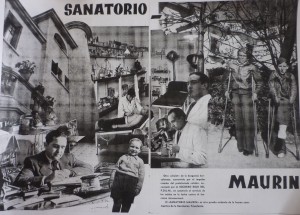 Below is a photo of the building today. The photo on the left above was taken further down to the left. Note the tower.
Below is a photo of the building today. The photo on the left above was taken further down to the left. Note the tower. 

(Thank you to Fernando Casal for the two articles above)
_________________________________________________________
3rd January 2013
“RUTA NEUGASS” Guide started on the web.
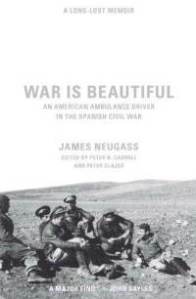
My work on discovering the many locations described in the book “War is Beautiful” allowed us in July 2012 to also film Jim’s emotional journey to discover his father here in Spain which will eventually be produced as a bilingual educational dvd by Director Aelwen Wetherby.
Early days yet, but I have now begun a virtual guide (A New Year’s Resolution!) for those curious to maybe visit the places from the book. As time permits I will add relevant materiel in order to eventually provide a complete Guide for those who wish to explore the Aragon Front with a copy of James Neugass’ book beside them. I am getting old now and not so fit as I used to be and at least I wish to leave a legacy for others to explore the beautiful landscape of this part of Spain and to hopefully understand the tragic events that took place here seventy five years ago.
Here is the website if it interests you. I will keep you posted as it develops chapter by chapter.
http://www.laguerraesbella.wordpress.com

________________________________________________________
2nd January 2013.
Moisès Broggi Vallés. 1908 to 2012 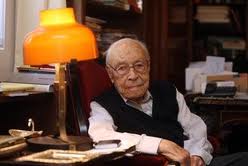 Dr Moisès Broggi Vallés has died aged 104 years old. Probably one of the oldest survivors from the Spanish Civil War died last Sunday at the ripe old age of 104 years. Dr Broggi was a surgeon with the 35th Division which included the XI, XIII and XV International Brigades. He worked at the Escorial Hospital during the battle of Brunete and on the Aragon Front including the recently identified Field hospital at Cuevas Labradas. He served with, amongst many others, Dr. Len Crome, Dr. Douglas Jolly, Dr. Reginald Saxton, Dr. Archie Cochrane, Dr. Edward Barsky and Dr. Leo Eloesser. He also remembered Welsh nurse Thora Silverthorn and often talked about George Nathan as the English equivalent of Don Quixote at the Battle of Jarama! In his autobiography “Memòries d’un Cirurgià” (La Butxaca, 2011) he was very struck by the death of ambulance driver Bob Webster who was killed on the road above the field hospital in “Paradise Valley” (now identified) near Urrea de Gaen on 12th of March 1938. This was the same location where American nurse Helen Freeman was badly wounded in the same aerial bombardment. James Neugass in “War is Beautiful” wrote: “Slim (Canadian chófer of one of the big evacuation ambulances) told me the story. “The planes were over all day,” he began, “ a two hundred pounder landed next to my car but it was a dud. At about 2 pm They let us have a shower of light stuff. A ten kilo bomb went off thirty five feet behind the operating tent. (Abraham) Friedman had been doing an amputation and Broggi a skull case. Both cases would have gone out if we had gotten into a trench so the eight who were there continued with their work. Helen, who’s over in the trench-“ “I know.” “-Helen (Freeman) got it in the head and the arm. We won’t be able to do her until it gets dark and the planes move off and we can use the tent- but I don’t know, there are so many rips in the roof that the light would shine through-but the generator’s smashed anyway-“ Sandor Voros in his autobiography “American Commissar” describes Dr Broggi at work in early April 1938 towards the end of the Retreats close to the River Ebro: The operating room is in a tent, the flaps are drawn tightly to prevent telltale gleams of light escaping into the night. The air is stifling hot under the bright gasoline lamp; amputated arms, hands, and legs overflow onto the packed dirt floor from the large wicker basket in the corner. Dr. Broggi, Division Surgeon, is operating on a bullet-perforated belly, his hairy arms are bloody past the elbows, his rubber apron is dripping blood on his shoes. He has been operating without a stop for more than twenty four hours. It is now way past midnight, but there is still a line of stretchers with belly and thigh wounds awaiting emergency surgery outside. I am standing at his side feeding him cigarettes, placing them in his mouth for short puffs. Although he is totally exhausted, his quick, sure fingers move with precision. He sews up the incision, drops his instruments, and staggers out. I follow him and catch him as he is about to collapse, lay him gently on the first stretcher near-by which is sticky with blood. By the time I lift his legs onto the stretcher he is asleep. I go back to the tent. The tiny operating nurse who looks like a girl stunted in early growth is also groggy, but she stays to clean up. No orderly is around and she tries to carry the heavy can full of dead tissue, blood, and muck out of the tent all by herself. I run over and take it from her. My hand wraps around a slimy, snakelike object that slops over the handle. It moves under my grip, a piece of large intestine. I nearly drop the can in fright but stagger outside with it, lay it down and retch. I retch and retch until nothing comes up any more, yet I retch and retch until I wake up in the morning aching in every bone….. “American Commissar” by Sandor Voros, page 426.
Dr Moisès Broggi Vallés has died aged 104 years old. Probably one of the oldest survivors from the Spanish Civil War died last Sunday at the ripe old age of 104 years. Dr Broggi was a surgeon with the 35th Division which included the XI, XIII and XV International Brigades. He worked at the Escorial Hospital during the battle of Brunete and on the Aragon Front including the recently identified Field hospital at Cuevas Labradas. He served with, amongst many others, Dr. Len Crome, Dr. Douglas Jolly, Dr. Reginald Saxton, Dr. Archie Cochrane, Dr. Edward Barsky and Dr. Leo Eloesser. He also remembered Welsh nurse Thora Silverthorn and often talked about George Nathan as the English equivalent of Don Quixote at the Battle of Jarama! In his autobiography “Memòries d’un Cirurgià” (La Butxaca, 2011) he was very struck by the death of ambulance driver Bob Webster who was killed on the road above the field hospital in “Paradise Valley” (now identified) near Urrea de Gaen on 12th of March 1938. This was the same location where American nurse Helen Freeman was badly wounded in the same aerial bombardment. James Neugass in “War is Beautiful” wrote: “Slim (Canadian chófer of one of the big evacuation ambulances) told me the story. “The planes were over all day,” he began, “ a two hundred pounder landed next to my car but it was a dud. At about 2 pm They let us have a shower of light stuff. A ten kilo bomb went off thirty five feet behind the operating tent. (Abraham) Friedman had been doing an amputation and Broggi a skull case. Both cases would have gone out if we had gotten into a trench so the eight who were there continued with their work. Helen, who’s over in the trench-“ “I know.” “-Helen (Freeman) got it in the head and the arm. We won’t be able to do her until it gets dark and the planes move off and we can use the tent- but I don’t know, there are so many rips in the roof that the light would shine through-but the generator’s smashed anyway-“ Sandor Voros in his autobiography “American Commissar” describes Dr Broggi at work in early April 1938 towards the end of the Retreats close to the River Ebro: The operating room is in a tent, the flaps are drawn tightly to prevent telltale gleams of light escaping into the night. The air is stifling hot under the bright gasoline lamp; amputated arms, hands, and legs overflow onto the packed dirt floor from the large wicker basket in the corner. Dr. Broggi, Division Surgeon, is operating on a bullet-perforated belly, his hairy arms are bloody past the elbows, his rubber apron is dripping blood on his shoes. He has been operating without a stop for more than twenty four hours. It is now way past midnight, but there is still a line of stretchers with belly and thigh wounds awaiting emergency surgery outside. I am standing at his side feeding him cigarettes, placing them in his mouth for short puffs. Although he is totally exhausted, his quick, sure fingers move with precision. He sews up the incision, drops his instruments, and staggers out. I follow him and catch him as he is about to collapse, lay him gently on the first stretcher near-by which is sticky with blood. By the time I lift his legs onto the stretcher he is asleep. I go back to the tent. The tiny operating nurse who looks like a girl stunted in early growth is also groggy, but she stays to clean up. No orderly is around and she tries to carry the heavy can full of dead tissue, blood, and muck out of the tent all by herself. I run over and take it from her. My hand wraps around a slimy, snakelike object that slops over the handle. It moves under my grip, a piece of large intestine. I nearly drop the can in fright but stagger outside with it, lay it down and retch. I retch and retch until nothing comes up any more, yet I retch and retch until I wake up in the morning aching in every bone….. “American Commissar” by Sandor Voros, page 426.  Born on the 18th May 1908 in the city of Barcelona. Moisès Broggi Vallés studied medicine at the University of Barcelona, where he graduated in 1931 under the direction of August Pi i Sunyer and Joan Trias Pujol, where he specialized in surgery. He took part in the Spanish Civil War as chief surgeon of the medical team of the 35th Division of the International Brigades.
Born on the 18th May 1908 in the city of Barcelona. Moisès Broggi Vallés studied medicine at the University of Barcelona, where he graduated in 1931 under the direction of August Pi i Sunyer and Joan Trias Pujol, where he specialized in surgery. He took part in the Spanish Civil War as chief surgeon of the medical team of the 35th Division of the International Brigades. 
Dr. Broggi in Puerta del Sol, Madrid sometime in 1937.

Dr Broggi (centre) with members of the Medical Team on the Aragon Front in 1937
During this period he pioneered, amongst other work, the use of mobile operating rooms in the front line. At the end of the conflict he was based at Barcelona Vallcarca Hospital, later to become the Hospital Clinic surgeon. He was ousted in a purge by the Franco regime.
Moisès Broggi continued, however, with his professional work, first in Terrassa and later in various centres in Barcelona that were noted for their nursing care. He was later appointed Chairman of the Ethics Committee of the Medical Association and was a founding member of the International Physicians for the Prevention of Nuclear War (IPPNW), which was awarded the Nobel Peace Prize in 1985 . In 1966 he became a member of the Royal Academy of Medicine of Catalonia, of which he became president in 1980. He died on December 31, 2012 in Barcelona, at 104 years of age.  A recent programme (in Catalan) concerning the life and times of Dr Broggi can be seen here: http://www.youtube.com/watch?v=lBeVznMBwjc&feature=youtube_gdata_player And here is an interview with Dr Broggi (in English) by Toni Strubell with some interesting comments concerning the present struggle for Catalan Independence: http://www.cataloniapress.com/2012/12/dr-moises-broggi-international-brigade.html?m=1
A recent programme (in Catalan) concerning the life and times of Dr Broggi can be seen here: http://www.youtube.com/watch?v=lBeVznMBwjc&feature=youtube_gdata_player And here is an interview with Dr Broggi (in English) by Toni Strubell with some interesting comments concerning the present struggle for Catalan Independence: http://www.cataloniapress.com/2012/12/dr-moises-broggi-international-brigade.html?m=1 
___________________________________________________________
24th December 2012
HAPPY CHRISTMAS!
I first would like to wish everyone who reads this blog a Happy Christmas. I also hope that the New Year will bring good things to you aswell as challenges to make you grow and appreciate what is good in the World. It is never easy, but together we can make this World a better place, I hope.
Just to give you an appreciation of the good things that we have, please give a thought to the Brigaders who were here in Spain over the Christmas of 1937, 75 years ago to the day. Miles away from loved ones and in a foreign country. Here is a description by Harry Pollitt (from a 1938 publication “Harry Pollitt visits Spain”) when he twice visited Mas de las Matas in the Aragon where the British battalion was resting

Right to left: Fred Copeman (looking down in khaki beret), Harry Pollitt (in leather coat and black beret), Bill Rust, General Walter and Copic in front of the group with other officers of the 35th Divison & XV Brigade, 17th December, 1937


The same building (with additions) behind Pollitt et al today.
Harry Pollitt wrote: Our next move brought us to the British Battalion. I was greeted by Wally Tapsell and Fred Copeman, who said they would work me to death now I had arrived. Then Tappy started to organise. He organised a meeting with the British comrades, the American comrades of the Washington-Lincoln Battalion, the Canadian comrades of the Mackenzie-Papineau Battalion, the Spanish comrades. I was never so well organised in my life. We had a full parade. The general had already addressed the British comrades, and had made my blood quicken by his assurance that they were a model of what soldiers ought to be. The parade was an exhilarating sight, the Spanish comrades proudly bearing the Spanish Republican flag and our boys the banner we had sent, entwined with a special banner, given by General Miaja.
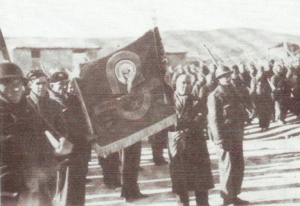
Harry Pollitt at Mas de las Matas with the British Battalion flag on December 17th 1937
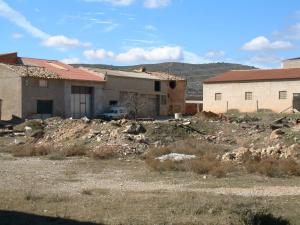
The same buildings (with additions) in the background
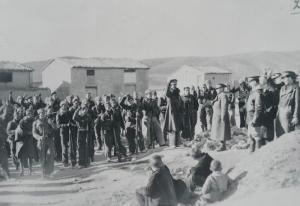 We took the salute. But here is Sam Wilde (sic), from Manchester, back again after wounds in previous battles. Sam couldn’t rest at home, and is now Commander of the Major Attlee Company of the British Battalion of the International Brigade. Then Lt.-Colonel Copic, an old and tried revolutionary, and former member of the Yugo-Slavian Parliament spoke, He described the part played by the British comrades at Jarama, Brunete, Cordoba, Belchite, Quinto, and then went on to speak of the tasks that lie ahead. Next it was my turn. I delivered the greetings from the democratic people of Britain, proud of their comrades in Spain. I did not hesitate to state that Clem Attlee, too, ought to be proud that a Company of such splendid men should be named after him, and I expressed the hope that the Labour party, inspired by this Company, would redouble its efforts to help the Spanish people with all the energy it could muster. I told the boys of the Tory opposition to Attlee and his defence of his actions in the House of Commons; I told them about the Labour Party’s campaign for Spain. They were obviously delighted to know that at last the great Labour Movement was trying to fulfil its obligations and that it would redouble its efforts to help the Spanish people with all the energy it could muster. We found that the visit of C. Attlee, M.P., Ellen Wilkinson, M.P., and Phillip Noel Baker, M.P, to the British battalion had created a very big impression, and there was the utmost eagerness to learn what effects their visit had had in Britain. We hope that one result will be that the whole Labour Movement will do much more, officially, to help the Dependents’ Aid Fund and to strengthen the British Battalion immediately. The type of comrade who is in the British Battalion is exemplified by Bill Alexander, who is temporary Commander during Fred Copeman’s illness. As I was leaving to return to London, Bill came up, placed nine dollars in my hand and asked me to pay his trade union contributions to the National Union of Printers and Bookbinders. A comrade who can think of this when he knew what he was shortly going to have to face, honours any Labour Movement of any country in the world. After the speeches, a little dinner followed. Then the singing began. American, Canadian, Yugo-Slav, Cuban, Spanish and Irish comrades all gave their contributions. Comrade Copic sang folk songs from Italy and Mexico in his clear, impressive voice; community singing followed. Later we adjourned to the local cinema, crowded with the lads stationed in the village; who were holding a festival. More songs; and then fists were raised and everyone joined in the “Internationale”. It was sung in a medley of every language under the sun. We couldn’t understand each other, but we all knew that the sacred words bound us in a common cause. And so ended a great night.
We took the salute. But here is Sam Wilde (sic), from Manchester, back again after wounds in previous battles. Sam couldn’t rest at home, and is now Commander of the Major Attlee Company of the British Battalion of the International Brigade. Then Lt.-Colonel Copic, an old and tried revolutionary, and former member of the Yugo-Slavian Parliament spoke, He described the part played by the British comrades at Jarama, Brunete, Cordoba, Belchite, Quinto, and then went on to speak of the tasks that lie ahead. Next it was my turn. I delivered the greetings from the democratic people of Britain, proud of their comrades in Spain. I did not hesitate to state that Clem Attlee, too, ought to be proud that a Company of such splendid men should be named after him, and I expressed the hope that the Labour party, inspired by this Company, would redouble its efforts to help the Spanish people with all the energy it could muster. I told the boys of the Tory opposition to Attlee and his defence of his actions in the House of Commons; I told them about the Labour Party’s campaign for Spain. They were obviously delighted to know that at last the great Labour Movement was trying to fulfil its obligations and that it would redouble its efforts to help the Spanish people with all the energy it could muster. We found that the visit of C. Attlee, M.P., Ellen Wilkinson, M.P., and Phillip Noel Baker, M.P, to the British battalion had created a very big impression, and there was the utmost eagerness to learn what effects their visit had had in Britain. We hope that one result will be that the whole Labour Movement will do much more, officially, to help the Dependents’ Aid Fund and to strengthen the British Battalion immediately. The type of comrade who is in the British Battalion is exemplified by Bill Alexander, who is temporary Commander during Fred Copeman’s illness. As I was leaving to return to London, Bill came up, placed nine dollars in my hand and asked me to pay his trade union contributions to the National Union of Printers and Bookbinders. A comrade who can think of this when he knew what he was shortly going to have to face, honours any Labour Movement of any country in the world. After the speeches, a little dinner followed. Then the singing began. American, Canadian, Yugo-Slav, Cuban, Spanish and Irish comrades all gave their contributions. Comrade Copic sang folk songs from Italy and Mexico in his clear, impressive voice; community singing followed. Later we adjourned to the local cinema, crowded with the lads stationed in the village; who were holding a festival. More songs; and then fists were raised and everyone joined in the “Internationale”. It was sung in a medley of every language under the sun. We couldn’t understand each other, but we all knew that the sacred words bound us in a common cause. And so ended a great night.
Harry Pollitt returned to Mas de las Matas on Christmas Day:
Soon we were on the move again. It was Christmas Eve, and we had promised to spend Christmas with the British Battalion. Through the night we drove, but transport difficulties prevented us arriving in time for the morning parade of the British comrades, where presents were given out by Lt.-Colonel Copic on behalf of the Brigade Staff to Comrades Fred Copeman, Fletcher, Miller and Stevenson. Sterling men, every one of them, rightly honoured for their great services in Spain. After this came Christmas presents to the village children. What excitement this caused! What sort of enemy was this that, instead of bombing civilians, gave Christmas presents to the children? The Washington-Lincoln Battalion, the Mackenzie-Papineau Battalions, did the same. It all created a wonderful effect. Then followed the great event of the day- Christmas dinner with the British comrades. The General of the Division and the Brigade Staff had been invited to be the guests of the comrades along with Comrade J.B.S. Haldane, Bill Rust and myself. We went to the dining place. After one look at “Hookey” Walker’s (the Quartermaster) face, we knew by that serene smile that it was going to be some dinner. It certainly was. The best Christmas dinner we have ever eaten. Then came the toasts. The general, Comrade Haldane and myself either moved them or responded; what did it matter what the order was? Our compère, Wally Tapsell, was the life and soul of the gathering. He rushed about attending to our comforts, then to see about the men in the village, next off to see that all was fixed for the concert and ball for the whole population, and between times he found time to dash twenty miles away to take Copeman a Christmas present from the boys! Now this was the only fly in the ointment. Fred was lying in hospital after a serious operation. He had been looking forward so much to this Christmas celebration. But doctors will insist that their orders are obeyed. Only a few nights previously I had listened to Fred giving the last orders to his officers and men regarding the urgent likelihood of their going into action. It had been in a room dimly lighted by a couple of candles. Everybody present felt the tension. This might be the eve of battle. Copeman’s instructions and advice were listened to with extreme attention and respect. As it happened, the call had not been made, but Fred was taken seriously ill with appendicitis. Fred had been more seriously ill than we knew, but is now well on his way to recovery, and will soon be back with his men.  The officers of the 57th English Battalion have the honour of inviting the mayor of Mas de las Matas and three lady companions to the Christmas dinner which will be celebrated in the dining room of the Headquarters on the 25th December at 6.30pm in the afternoon. Mas de las Matas (signed ) William Alexander 24th December 1937 Commander 57th Battalion The meal over, the toasts drunk, the singing started. At first only revolutionary songs, sung by all nationalities, then individual efforts. I can see Lieutenant George Fletcher now, sitting on a chair on the table, doing his turn- “One finger, one thumb, keep moving”. Did we get into a mess trying to follow all the various evolutions? I’ll say we did. Then quiet-looking Doctor Bradsworth, of Birmingham, who has done such valiant service in Spain, insisted upon singing “How can a guinea pig show he’s pleased if he hasn’t got a tail to wag?” When we got to this stage it was more than odds on where we would get to. Soon it came; an Australian nurse started it with “The Shade of an Old Apple Tree”, then Comrade Gibbons, from Canada, got up and sang “The Rose of Tralee”. Now we were off with a vengeance! “I Saw the Old Homestead” followed, and then all the old-time choruses came out. I looked at “Hookey” Walker, and could tell by the look in his eyes what he was going to sing; sure enough, up he got, and before we know where we are, we were full steam ahead with “Nellie Dean”. Oh, Gertie Gitana, you have had some music hall audiences singing that song, but never as we sang it on this Christmas night. This brought Sam Wilde into action with “Frankie and Johnnie”. Then Bill Rust waxed vocal with “Come, Landlord, Fill the Flowing Bowl”. The Tappy thought it was time to show the Carl Rosa Company that it had missed a treasure, for he started too! Then we adjourned to the local ball. The comrades had organised a dance which would have made Jack Hylton green with envy. You couldn’t move, let alone dance. So the singing started again. I had to make another little speech. Then we called for three cheers for victory for Republican Spain, which could have been heard a mile off. I am still hoarse from that effort. The Ball ended. We went round to the lads in their billets to wish them farewell, as we were leaving that night for Teruel. As I was leaving, a comrade came up to me and said: “I came from Palestine to fight for Republican Spain. Will you let them know in England that there are three hundred of us here from Palestine?”. Now back to headquarters to say farewell to the rest of the comrades. In a corner of the room a group was gathered round the wireless set. Someone was impersonating Gracie Fields singing “Good-night, My Love.” If Gracie could have seen the faces of the lads as they listened and joined in, I am sure it would have made her happier than being mentioned in the New Year’s Honours List. So ended Christmas Day, 1937. Victory will have been won for Republican Spain long before Christmas, 1938. Bob Clarke in his autobiography “No Boots to my Feet” remembers the priest’s house in Mas de las Matas: “Over the fireplace I was amazed to see a large plate with a painted view of Brighton and the words “A present from Brighton” embossed thereon. How on earth had that reached here, I thought. Had this village priest, years ago, visited England? Or some trader trudging through the mountains with wares from Barcelona sold it to him? (Yet that sounds highly unlikely). Maybe some friend had sent it to him. One could sit up all night and find various reasons for its presence. It may sound trivial but this plate caused a great deal of discussion, particularly among the London lads.” Here is a photograph of the Mackenzie Papineau battalion in the Plaza Mayor of Mas de las Matas over Christmas 1937. Sadly, the building behind them has been recently modernised, but here is a photo I luckily took a couple of years ago. Note the arched door, balconies and smaller window:
The officers of the 57th English Battalion have the honour of inviting the mayor of Mas de las Matas and three lady companions to the Christmas dinner which will be celebrated in the dining room of the Headquarters on the 25th December at 6.30pm in the afternoon. Mas de las Matas (signed ) William Alexander 24th December 1937 Commander 57th Battalion The meal over, the toasts drunk, the singing started. At first only revolutionary songs, sung by all nationalities, then individual efforts. I can see Lieutenant George Fletcher now, sitting on a chair on the table, doing his turn- “One finger, one thumb, keep moving”. Did we get into a mess trying to follow all the various evolutions? I’ll say we did. Then quiet-looking Doctor Bradsworth, of Birmingham, who has done such valiant service in Spain, insisted upon singing “How can a guinea pig show he’s pleased if he hasn’t got a tail to wag?” When we got to this stage it was more than odds on where we would get to. Soon it came; an Australian nurse started it with “The Shade of an Old Apple Tree”, then Comrade Gibbons, from Canada, got up and sang “The Rose of Tralee”. Now we were off with a vengeance! “I Saw the Old Homestead” followed, and then all the old-time choruses came out. I looked at “Hookey” Walker, and could tell by the look in his eyes what he was going to sing; sure enough, up he got, and before we know where we are, we were full steam ahead with “Nellie Dean”. Oh, Gertie Gitana, you have had some music hall audiences singing that song, but never as we sang it on this Christmas night. This brought Sam Wilde into action with “Frankie and Johnnie”. Then Bill Rust waxed vocal with “Come, Landlord, Fill the Flowing Bowl”. The Tappy thought it was time to show the Carl Rosa Company that it had missed a treasure, for he started too! Then we adjourned to the local ball. The comrades had organised a dance which would have made Jack Hylton green with envy. You couldn’t move, let alone dance. So the singing started again. I had to make another little speech. Then we called for three cheers for victory for Republican Spain, which could have been heard a mile off. I am still hoarse from that effort. The Ball ended. We went round to the lads in their billets to wish them farewell, as we were leaving that night for Teruel. As I was leaving, a comrade came up to me and said: “I came from Palestine to fight for Republican Spain. Will you let them know in England that there are three hundred of us here from Palestine?”. Now back to headquarters to say farewell to the rest of the comrades. In a corner of the room a group was gathered round the wireless set. Someone was impersonating Gracie Fields singing “Good-night, My Love.” If Gracie could have seen the faces of the lads as they listened and joined in, I am sure it would have made her happier than being mentioned in the New Year’s Honours List. So ended Christmas Day, 1937. Victory will have been won for Republican Spain long before Christmas, 1938. Bob Clarke in his autobiography “No Boots to my Feet” remembers the priest’s house in Mas de las Matas: “Over the fireplace I was amazed to see a large plate with a painted view of Brighton and the words “A present from Brighton” embossed thereon. How on earth had that reached here, I thought. Had this village priest, years ago, visited England? Or some trader trudging through the mountains with wares from Barcelona sold it to him? (Yet that sounds highly unlikely). Maybe some friend had sent it to him. One could sit up all night and find various reasons for its presence. It may sound trivial but this plate caused a great deal of discussion, particularly among the London lads.” Here is a photograph of the Mackenzie Papineau battalion in the Plaza Mayor of Mas de las Matas over Christmas 1937. Sadly, the building behind them has been recently modernised, but here is a photo I luckily took a couple of years ago. Note the arched door, balconies and smaller window: 

The reopened museum on the Battle of the Ebro at Fayon had a report about it recently. Here is a link to the report showing the inside of the Museum. Not too easy to get to, but an incredible collection. The weekend nearest to the 25th of July various re enactment groups come together at Fayon to cross the River Ebro (but from the other side!) and to fight it out close by. Of course, next year will be the 75th anniversary of the Battle and there is an idea that on the 25th of July re-enactors might also cross in boats where the XV International Brigade crossed! See you there?
http://www.youtube.com/watch?feature=player_embedded&v=MjWNrvHtrxY
The website of the Museum is at http://www.labatalladelebro.com
__________________________________________________________
6th December 2012
THE BLOG HAS BEEN TIDIED UP!
The good news is that I have at last tidied up this blog and have put the various reports into dedicated folders. I hope that this can help you delve into particular subjects that interest you. Some materiel, such an event announcements, have been deleted as irrelevant for now. Any comments, please write.
Regards,
Alan Warren
pdlhistoria@gmail.com
_________________________________________________________
4th December 2012

“Lost Cause” by John Wilson
Released last October, I have just finished this young adult’s book covering a part of the Spanish Civil War. I thoroughly enjoyed this book, especially as many of the places that are described in the book I know very well. The story describes the journey of Steve, a young Canadian on a task set by his deceased grandfather to return to Spain to collect a suitcase containing hidden clues of his earlier life. Slowly but surely he begins to understand his grandfather’s presence in Spain with the International Brigades by reading his journal of his experiences in the Battle of the Ebro. With the help of Laia, the great grandaughter of his grandfather’s Catalan lover (and the love interest), he is also adequately able to understand the present awkward (and painful) state of affairs in Catalonia (and Spain) by chance meetings with local people, as he is taken by Laia to the Ebro where together they are able to explore the places that the journal describes in a pleasing then and now sequence between July 1938 and the present day.
Like “A World between Us” by Lydia Syson, reviewed earlier in my blog, I think this book might intrigue young male adults to explore the subject. For the most part it is correct (though John Wilson describes the Mackenzie Papineau flag as the battalion prepared for the Ebro battle, it was never with the battalion at that time, having been captured by the 1st Navarre Division in Alcorisa in early March 1938 during the Retreats; we are still looking for it. Also we have identified the exact spot where the XV Brigade crossed which is actually south of Asco near Vinebre rather than between Flix and Asco. Though he mentions the five tanks that supported the assault on Gandesa, there is no evidence of Republican troops having actually entered the town, the closest they got to was the XI Brigade just outside the cemetery. The Mac Paps were actually based on Hill 403 supporting the British battalion’s attack on Hill 481 to the south west. His history of Placa Sant Felip Neri in Barcelona is open to debate too. But I should not nit pick. It is a good attempt, and if it can only inspire young people to read more about the subject then it is a success in my eyes ).
Scottish author John Wilson has obviously done his fieldwork, having visited Catalonia and having described the hero at various locations in Barcelona and some of the COMEBE Centres of Interpretation on the Ebro such as the Air Raid shelter at Flix, “Los Internacionales a l’Ebre” at La Fatarella, the Memorial to the Dead at Camposines and the “115 Dies” Centre at Corbera, though there is so much more that could have been seen and described. But it is good publicity to visit the area.
I congratulate him on writing such a book on the subject and hope it might inspire young people to visit the area and also to read more before coming. There is a lot to see!
“Lost Cause” by John Wilson is published by Orca Book Publishers of Canada.
Another good Christmas present for younger adults.
For more information and to buy a copy of the book direct from the publishers go to
http://www.orcabook.com/contributorinfo.cfm?ContribID=488
____________________________________________________________
3rd December 2012

I promise I will shut up about films, but I suddenly found this rather stirring clip from the 1955 East German film “Ernst Thalmann. Fuhrer seiner Klasse” by Kurt Maetzig. Good East German propaganda similar to “Funf Patronenhulsen” from 1960. Enjoy!

http://www.youtube.com/watch?v=OtQgNb1Z9p0&feature=youtube_gdata_player
“Funf Patronenhulsen”, DDR, 1960.
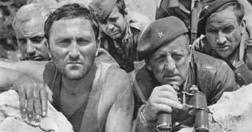
“Genossen Commissar” Witting and his chums.
And here are the first few minutes of “Funf Patronenhulsen”. The introduction, for me is the best bit, with Oleg, the Pole putting the contents of his water bottle into the Maxim machine gun casing rather than drink it! (The film deteriorates later with World War Two German sub machine guns all over the place, however). And Ernst Busch singing along too! Bliss!
http://www.youtube.com/watch?v=i5GrmDMG6es&feature=youtube_gdata_player
And for those who wish to watch it all, here is the complete film:
___________________________________________________________
2nd December 2012
“El Bosc “. A new Spanish film about the Spanish Civil War, the International Brigades…….. and Ghosts!

Tom Sizemore as “Captain Henry Pickett of the Abraham Lincoln Brigade”

Some of his men.
Just to let you know that a new film will be released in Spain this December 14th entitled “El Bosc “. Originally premiered at the Sitges Fantastic Cinema Festival last October, it is directed by Catalan director Óscar Aibar and based on a story by Albert Sanchez Piñol. It stars Alex Brendermuhl, Maria Molins, Pere Ponce and American actor Tom Sizemore, who has appeared in such action war films as “Saving Private Ryan “, “Pearl Harbor ” and “Black Hawk Down “. He appears in this film as “Captain Henry Pickett of the Abraham Lincoln Brigade “. You can catch a glimpse of him in this clip. Looks interesting…..
http://www.youtube.com/watch?v=bKpIL-3E_Ws&feature=youtube_gdata_player
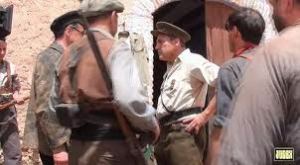
I cannot say much more until I see the film.It may be a great disappointment. But I hope not. And for American release? Dont forget that last year the Catalan film “Pa Negre” almost made it to the Oscars, but sweeped awards aplenty at the Goya Awards here in Spain earlier this year. Has anyone seen “Pa Negre”? Does anyone read this blog???

A Nationalist firing squad in the background?????? Certainly a nice captured T26 tank.

Though the film covers a farming family during the whole of the War, I think “El Bosc ” may involve the Great Retreats of March and April 1938, as it is set in Lower Aragon near Matarraña pretty close to where the Americans were at that time. Lets see. But if you wish to search on the web, you may find out more.
And here is a link to the excellent Catalan film “Pa Negre”. Set immediately after the War, it is a very moving story of a child’s life.
___________________________________________________________
DNA samples sought of relatives who disappeared during the Spanish Civil War
I add below the translation of a proposal to build up a database of DNA to attempt to identify missing persons during he Spanish Civil War. The reason why I am putting this publicity up is that I may be able to announce the discovery of a possible mass grave of American Brigaders from early April 1938. Things still have to be developed, but it might be of interest to American family members who lost loved ones at that time? A lot of exciting research is going on at present on this matter. And Archaeology is now rearing its head. Certainly more concerning this mass grave will be known on the 75th anniversary March between Batea and Corbera on March 30th to 31st next year. I have a number of Americans coming on the tour to Teruel starting from Barcelona on March 23rd (This will be over Semana Santa, or Easter, so let me know sooner or later to avoid disappointment booking rooms etc.) and then to Belchite to follow the Great Retreats and end up at Batea for the Conference and March on Sunday 31st March, followed by two days exploring the Ebro battlefield until back in Barcelona on 2nd April, but if anyone would like to join us then please contact me on pdlhistoria@gmail.com
The original document (in Catalan) can be found here: http://dom.cat/5br
Of course, this announcement applies to all those who are seeking family who have disappeared in the many mass graves all over Spain.
A DNA Bank for the future identification of relatives who have disappeared in the Spanish Civil War It is now deemed necessary to consider obtaining appropriate DNA samples from families, in order to open a door to the hope [1] which will allow us to compare such samples with DNA from all the unidentified remains exumed from mass graves. This is an individual action by each family in conjunction with the University of Barcelona, that will guarantee us ethically and legally the lawfulness of such work, that is a key in the process of identifcation of the missing. The Laboratori de Genètica Forense de la Facultat de Medicina of the University of Barcelona is regulated by the conditions of: Confdentiality[2] •Rigour[3] •Quality[4] Above all, these projects are carried out within of the Law of Biomedical Investigation 14/2007 and the Royal Decree 1716/2011, from which are established the requirements for the basics of authorisation and operation of the Biobanks with the aims of biomedic investigation and treatment of the human origin samples and regulates the operation aswell as the organisation of the National Register of Biobanks for biomedical investigation. We cannot lose more time, because in the near future we will have fewer living witnesses. On the other hand, this initiative can only make sense if the maximum number of famílies affected can take part. It is simple and at an affordable cost, with just four steps to follow: #1 It is first necessary that you construct a diagram of your genealogical family tree, so that you can determine the relative who has disappeared with the closest living relatives such as their brothers, sisters, cousins, cousins, sons, daughters, nephews or nieces. Here is a link to an example of the family tree of the Malagarriga-Picas / Sort- Sala-Ribalta family (http://dom.cat/5a4) and also the family tree of the Guinau- Heredia-Jornet family (http://dom.cat/5a5) as examples where four and three significant people respectively were identified as genetic witnesses for the missing Guillem Malagarriga and Jaume Guinau. #2 Call or email the Laboratori de Genètica Forense de la Facultat de Medicina of the University of Barcelona, or discuss with any of the famílies who already have followed this process, in order to confirm which people would be appropriate as genetic witnesses. Genètica Forense | Medicina Legal i Forense Facultat de Medicina de la Universitat de Barcelona carrer Casanova, 143 | 08036 Barcelona http://dom.cat/5a8 <geneticaforense@ub.edu> T· 934 035 289 Família Malagarriga-Picas/Sort-Sala-Ribalta <OnEtsOncleGuillem@gmail.com> T· 667 517 069 http://twitter.com/OnEtsOncleGuill Família Guinau-Heredia-Jornet <OnEtsPadriJaume@gmail.com> T· 619 315 568 #3 An extraction of a blood sample, from family members, that will be registered to the bank of DNA Bank of the Unit of the Laboratori de Genètica Forense de la Facultat de Medicina, for the future identifcation of your relative. The team of doctors asks that the extraction of blood can be done in just one session for all the family that have been summoned. The taking of samples is only five minutes of work for registering and a small puncture for the collection of blood from each person. #4 Collection of the samples in test tubes, with the dry extract of the blood where there is the purified DNA (the family also retains a part of the sample), with all the documentation that accredits it, and make the final payment of the required amount to the Fundació Bosch and Gimpera. Here is an image and a document of DNA samples with a report of the Preliminary Study of genetic identification (http://dom.cat/5a6) of the Malagarriga-Picas /Sort-Sala-Ribalta family. Such work would cost approximately €150 To view this example from the Fundació Bosch and Gimpera with the corresponding bill go to http://dom.cat/5a7. [1] It is difficult to speak of the reliability of the DNA tests as this depends on the closeness of kinship between the family member’s sample and the quality of conservation of samples of the disappeared relative. [2]All the data passed to the people interested, also how the resulting reports of the studies made, with confidentiality and custody as demanded by the legislation concerning professional secrecy. ((Codi Penal vigent – article 1992 & articles 413 to 428, Llei 41/2002, dated 14th November, covering regulations of the autonomy of the patient and of the rights and obligations covering informacion and clinical documentation). [3] The professional and scientific work of our researchers and docents of our team guarantees the of the studies. [4] Periodic quality controls made by our laboratory guarantee the maximum quality of our results. __________________________________________________________  La Fatarella 1938 Movie is Go! And speaking of movies, I am pleased to announce that the film project for “La Fatarella 1938” successfully reached its target of 4000 euros and will now be made. Thank you to all who supported the project. I understand that filming will begin in February next year. And I will hopefully see some of you on the Opening Night! I believe that 85 people helped fund the project. That works out at less than 50 euros per person. I am very excited by this approach. And you? http://www.verkami.com/projects/3406 I do feel driven to work on some book projects next year and will seriously consider using crowdfunding as a possible means of raising funds. I hope you might support this plan if I take it further.
La Fatarella 1938 Movie is Go! And speaking of movies, I am pleased to announce that the film project for “La Fatarella 1938” successfully reached its target of 4000 euros and will now be made. Thank you to all who supported the project. I understand that filming will begin in February next year. And I will hopefully see some of you on the Opening Night! I believe that 85 people helped fund the project. That works out at less than 50 euros per person. I am very excited by this approach. And you? http://www.verkami.com/projects/3406 I do feel driven to work on some book projects next year and will seriously consider using crowdfunding as a possible means of raising funds. I hope you might support this plan if I take it further.
_________________________________________________________
14th November 2012
A perfect Christmas Present for the younger generation?
“A World Between Us” by Lydia Syson
This is a first for me to write a review for this blog about a book on the Spanish Civil War. And a first for me to write a review for a children’s book. AND a first for me to write a review for an e book!
So where do I start? Of course, at the beginning!
I bumped into Lydia Syson in the pub, last July , following the International Brigade Memorial Trust commemoration at the London Eye. I was there with Jim Neugass, the son of James Neugass, following a whistle stop tour of the many places in Spain we have discovered from Neugass’ excellent book “War is Beautiful”. More about that later. As is the way of synchronicity, Lydia was introduced to Jim and started nattering, and mention was made of the forthcoming release of her children’s book, “A World between Us” by Hot Key Books on October 2nd 2012.
For some odd reason, I have taken three American authors to various places with the intention of writing children’s books on the Spanish Civil War over the past few months. And this is the first printed book for children that I have been presented with, though I had nothing to do with helping Lydia write this book.
I am not going to write a review per se. That is for each of us to do for ourselves and our friends and family. But as a historian studying the International Brigades, I cannot recommend this book highly enough as far as the historical accuracy within its pages. It has been well researched. And the story is engaging and appealing for not just teenagers and young adults, but also older adults too.
I am not going to give the game away as far as the story unfolds, but I would recommend this book as a possible Christmas gift for younger people. With a bit of a nudge/kick/ half Nelson from doting parents, it might inspire children with a bit of curiosity to enquire more? I hope so, in any case! Follow the adventures of Nathan through the Battle of Cable Street, Felix the brave nurse, and George in a story that races from London to the Battlefields of Spain with passion and betrayal; adventure and history in a very readable form.
“But my children don’t read books”, I hear you cry? Ha! Got you! Because, there is also a (and I quote) “Multi-touch iBook 2” version for an I Pad (NOT a KINDLE, but the book is available for the Kindle but without any of the buttons to press on the I Pad version) which has been released only this week.
And this “Multi-touch iBook 2” is quite incredible. Lots of multi media buttons to touch and explore, with photographs (I will not say too much on the captions or the subjects, but hopefully they can be altered a lot easier than a printed book), letters, music by the “Strawberry Thieves” and interviews with one of the last surviving British Brigaders, David Lomon (In a Spanish newspaper article following his visit to Madrid last weekend, he is named as “David Solomon”, and according to the report, the journalist seems to confuse David’s capture at Calaceite on March 31st 1938 with the Battle of the Ebro, but never mind), Lydia Syson herself, and historians Richard Baxell and Paul Preston. This multi media book is a very exciting technological advance in hopefully making people aware of the International Brigades and has good links to follow if interested.
One word of warning, however, is to be sure that your I Pad can accept this book. I had to upgrade to a more recent Operating System to read it, but it was well worth it. If you (or your children) have access to such a medium, I think you could do no better than to purchase this for them this Christmas. It won’t break the bank either.
The multi media book is available from I Tunes and should be accessible from all over the World, except in the United States, according to Hot Key Books (Sorry!).
To order a copy contact Hot Key Books at http://www.hotkeybooks.com.
See also Lydia’s webpage at http://www.lydiasyson.com
I heartily congratulate Lydia Syson and Hot Key Books on a book for young people that will hopefully raise interest in the Spanish Civil War and is a good read too.
_________________________________________________________
13th November, 2012
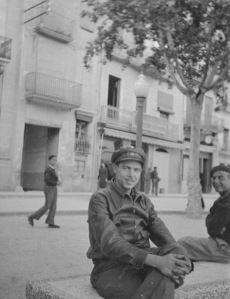
Harry Randall, May 1938 (probably taken in Tarrega, near Lerida)
Harry Randall. Rest in Peace.
I have just received the sad, but inevitable, news that Harry Randall, who took many of the photographs of the XV International Brigade and which we are identifying now here in Spain, died yesterday. This is very sad, and my mind is wondering if some sort of scholarship or Foundation could be made up to continue research into his incredible collection of photographs that he brought back from Spain in December 1938?
More news later, but for now I add Sebastiaan Faber’s announcement from the ALBA Volunteer (www.albavolunteer.org).
Harry Wayland Randall (1915-2012)
November 12, 2012
By Sebastiaan Faber
We just received the sad news that Harry Wayland Randall, one of the last surviving veterans of the Abraham Lincoln Brigade, passed away last night at a care facility in Snowflake, Arizona.
Harry was a Sergeant in Mac-Paps battalion and Chief Photographer of the Photographic Unit of the 15th International Brigade. His unit’s work is held at the Tamiment Library/ Robert F. Wagner Labor Archives, NYU, and can be seen online. Harry was born on December 20, 1915, in Spokane, Washington and raised in Portland, Oregon. He was the oldest of three children born to Harry W. Randall, Sr., an insurance adjuster, and Frances E. Randall, a schoolteacher. As a young man he developed an interest in motion pictures and, after graduating from Grant High School in 1934, enrolled in Reed College in Portland. While there he was drawn into a world of political action, joining with other progressive students on campus to support labor causes and to protest the rise of fascism in Europe. He collected food for striking maritime workers in 1934 and distributed leaflets at a lumber-workers strike in 1935. He left Reed after a year, found work as a projectionist for an advertising agency and, with a friend, began distributing foreign films in Washington State and Oregon. When the Civil War erupted in Spain, Randall enlisted in the International Brigades — battalions of foreign volunteers that supported the Republican Army — to fight against Franco’s fascist forces. Randall sailed from New York on the S.S. Georgic on June 12, 1937, arriving in Spain on July 1, 1937. Following training with the MacKenzie-Papineau Battalion in Tarazona he was promoted to the rank of Sergeant and became the Chief Photographer of the Photographic Unit of the 15th International Brigade. He served in Spain until the withdrawal of the volunteer forces and returned to the United States on the S.S. Ausonia on December 20, 1938. Randall relocated to Canada and found work with the National Film Board of Canada as the head of the Science Film unit. In 1944 he enlisted in the Canadian Army and served in England during the war making newsreels with the Film and Photo Unit. After the war, Randall resumed work with the National Film Board. He returned to New York City in 1952 and for the next 30 years produced, edited, and directed medical films. Randall married Doreen Cavalier, a registered nurse, in 1956 and the couple had two children and settled in Northern New Jersey. In 1983 Randall retired from the American Cancer Society after 18 years as the director of the organization’s film unit. The Photographic Unit of the 15th International Brigade was charged with creating a photographic record of the 15th Brigade for publication in the Brigade’s newsletter Volunteer for Liberty, and for distribution to news outlets in the United States, England, and Canada. The photos were intended to boost the morale of the volunteers in Spain and foster sympathy and support for the Republican Army abroad. In addition to Randall, the unit was staffed by photographers Benjamin Katine and Anthony B. Drossel, as well as lab technician William H. Oderaka. The team was given full access to move about the camps, chronicling the troops at rest, and venturing to the front to capture scenes of the battalions in the trenches and under fire. As part of their routine, each photographer logged and processed the film he shot. Every photograph was assigned a unique number, which was etched into the negative, and given a caption, which was recorded in one of five logs. Photographs were placed in albums, and copies were distributed to the press. Extra prints were sold to the troops for a nominal fee. Although initially successful in procuring the necessary photographic equipment to carry out their work, as the war progressed lack of film and printing paper hampered the unit’s operation. Film development under battle conditions also proved challenging. Like the rest of the Brigade the development lab was a mobile unit, and was required to retreat or advance on short notice. On more than one occasion film and equipment were sacrificed or lost. Following the war, Randall returned to the United States and brought with him the Brigade’s photographic archives – negatives, albums of prints, and logs. In January 1939 Randall spent several weeks in the New York Film and Photo League darkroom developing a complete set of fresh prints and making enlargements of all of the photographs taken by the unit in Spain. At the request of the British veterans, Randall also made 8×10 inch prints of images of the British Battalion and sent them along with copy negatives to the veterans’ organization in England. In the intervening years the prints, negatives, and logs passed through many hands (most often fellow veterans). In the course of changing stewardship, many prints were dispersed, the original logs separated, and the albums disassembled. This collection represents the most complete record of the Photographic Unit’s work in Spain.”
Thank you, Harry. I will say a quiet “thank you” every time we locate another photo.
Alan Warren and the fieldworkers here in Spain
_____________________________________________________________
DO YOU WANT TO HAVE YOUR NAME IN A FILM CREDIT???? HERE’S HOW!
Have I got your attention? Good. Like me, I expect you are also attracted by “the roar of the greasepaint and the smell of the crowd” as dear old Larrie used to say to me, and now you can help make it happen plus to get your name in lights too!
A short film based on the experiences of the Quinta de Biberon or “baby bottle” troops of 16 and 17 years old who fought and died in the Battle of the Ebro in July 1938 is being made by a group of professional film makers with the support of various local groups in the village of La Fatarella and Catalonia as a whole. The title of the film will be “La Fatarella, 1938” and details (in English) can be found here: http://www.lafatarella1938.com/en/what-is-la-fatarella-1938/
The group is seeking funding of 4,000 euros to complete the film and are using the new and exciting method of “crowdfunding”. Look up “Kickstarter” in the USA and the UK for how it works. This film has already raised 2,600 euros, but could do with more support. And by way of thanks for your support there are little rewards as detailed on the website below. From as little as 5 euros you can have your name in the credits and other gifts are also offered. I urge you to support this film as I strongly believe that it will be an empowering means of allowing culture to be funded by us as individuals than large concerns.
The group however, needs to raise the 4,000 euros over the next eleven days (there is a forty day window on these projects to achieve the full amount), so any contribution you would be able to give would be greatly received, and you could also be invited to the World Premiere!
For further details and to promise a donation go to
http://www.verkami.com/projects/3406
And I hope to see you on the Opening Night!
__________________________________________________________
A weekend at La Fatarella to remember Charley of the XV Brigada Mixta, and a visit to the recently excavated trenches of the 35th Division at Hill 402.
“Charley”
It was with great emotion that I attended the commemoration of Charley, a member of the XV Brigada Mixta (formerly the XV international Brigade), who was killed in the final defence of the fortified line above La Fatarella on November 15th 1938.
The trench with flowers where Charley was discovered.
The memorial to the XV Brigade will be placed above the position where Charley was found next November 16th 2013, almost on the 75th anniversary of his death
Flowers were laid and later a talk was given by Xavier Hernandez Cardona and Carmen Rojo Ariza from the University of Barcelona on the body, found last October just half an hour after the University archaeological team started digging.
The full paper on Charley and the excavation (in Spanish) from the excellent Ebre 38 journal, can be read here
http://digital.csic.es/bitstream/10261/47780/1/2012_Informe%20La%20Fatarella%202011_Gonzalez.pdf
Still a lot of research to do, but Associacio Lo Riu wish to place a memorial where Charley was found to commemorate the last stand of the XV Brigade over the weekend of November 16th 2013. We hope that people connected with the XV International Brigade can join us over that weekend then and pay our respects to Charley and all the others who lost their lives in this battle. Lo Riu’s new museum is a pleasure to behold and I am supporting the group in their work. It is now not large government funded bodies doing this work, but small groups of enthusiasts who are now taking part. This, I feel quite strongly, should be the way forward.

Bunker No. 3 in the second line of defence above La Fatarella, looking north.
Bunker No. 3 photographed by the Italian CTV after the final defence, looking north west.
Here are some news reports (in Catalan) concerning the event:
http://www.tv3.cat/videos/4332791/TN-comarques-Tarragona-12112012 (The report starts at 3’17”)
__________________________________________________________
An odd little story connecting Franco and Alvah Bessie….
A strange conversation was held at La Fatarella over the weekend concerning Franco and Alvah Bessie.
Some of you may know that Alvah Bessie wrote the original story for the 1944 film “Objective Burma”, starring Errol Flynn. It seems that the original story was partly based on his experiences in Spain, as written in his incredible book, “Men in Battle”. However, two older people in the group suddenly mentioned that when Franco died on November 20th 1975, one Spanish television channel showed a film. And the name of that film?
“Objective Burma”.
Seems that maybe Alvah had the last laugh on Franco.
And here is a link to the film:
____________________________________________________________
November 11th 2012. Cota 402
Cota 402 is just north west of Corbera on the Ebro battlefield where in July and part of August 1938 the Estado Mayor of the 35th Division comprised of the XI, XIII and XV International Brigades was based. The nerve centre of the fighting of the Division, Hill 481 (The British battalion’s “Hill of Death”), Hill 666 in the Sierra Pandols and Gandesa, the objective of the attack are clearly visible from this excellent viewpoint. A group of enthusiasts have spent the last year excavating the trenches and have now opened them to the public. Various artefacts are now housed in the excellent museum “La Trinxera” (no website) run by Pere Sanz in Corbera.
Here are some shots to make you curious. Early days yet, as there are masses more trenches to work on. A lot of things will be happening next year on the Ebro. The 75th anniversary of the Retreat of the Lincoln Washington Battalion from Batea to Corbera on March 30th and 31st 2013; the 75th anniversary of the Battle of the Ebro around 25th July and the Last Stand of the XV Brigade , east of Corbera on September 23rd 2013. Associoacio Cota 402 also plan to have a weekend of re enactors at Cota 402 on April 20th and 21st 2013. All welcome, but be aware that not many people in the area can speak English, but they are excellent sources of local knowledge as we have discovered.
Juan (?) and Vicens Julia (right) who has identified numerous photographs taken by the XV International Brigade Photographic Unit.
Some of the reconstructed bunkers
A reconstructed “cheveux de frise”
View from Cota 402. Left to right, Hill 666 in the Sierra Pandols, Hill 481 in Les Girones and to the far right , Gandesa.
View of the Sierra Caballs and Hill 565. Below Corbera. Note the artificial barbed wire
Not from Cota 402, but from Cota 357 north east of Corbera facing east. Just left of the road as it turns and disappears towards Camposines one can see Hill 287 where the Lincoln Washington Battalion was on the last day of fighting of the International Brigades on September 23rd 1938. Just at the edge on the left of the photo is Hill 356. Somewhere between Hills 287 and 356, Jim Lardner was killed. To the right of the road as it curves is the last position of the British Battalion. The survivors scrambled up the ridge and discovered the headquarters being arrested for leaving the line! George Fletcher’s machine gun company was giving cover as the survivors regrouped. A tragedy





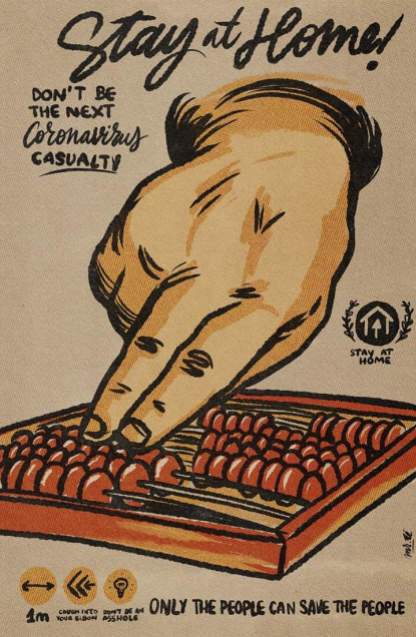









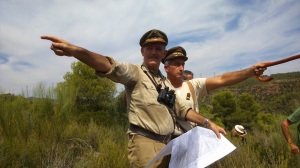
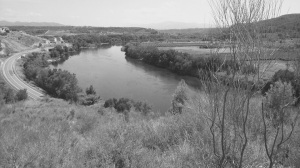

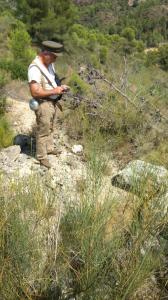
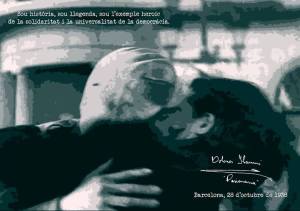
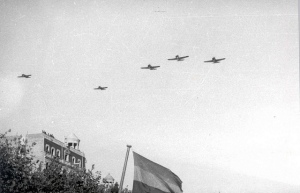

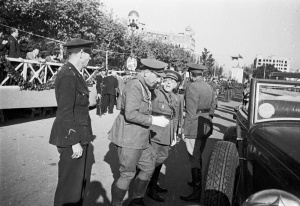

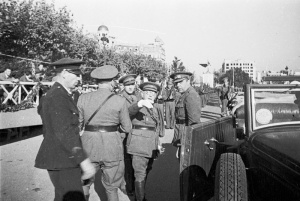

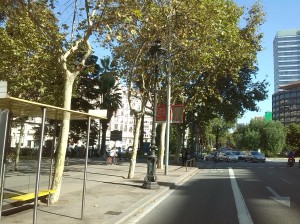
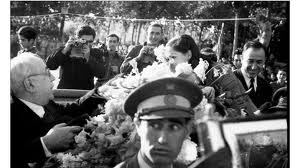







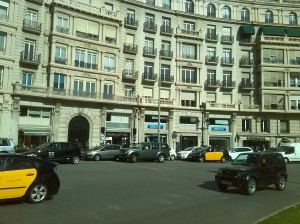
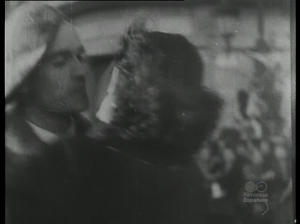




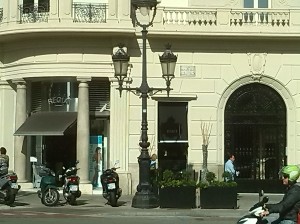









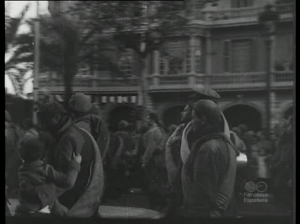


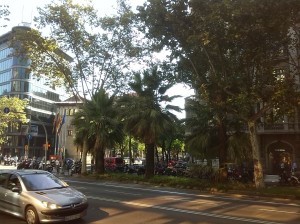


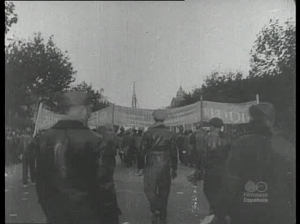
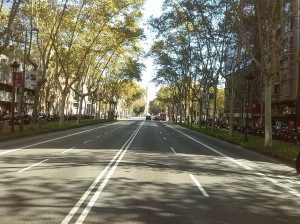
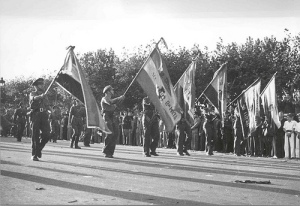


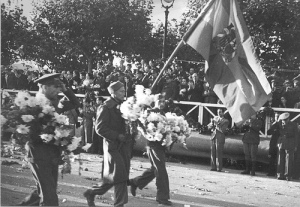
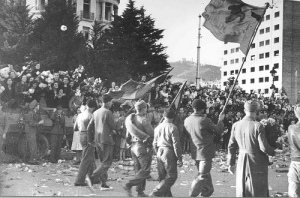




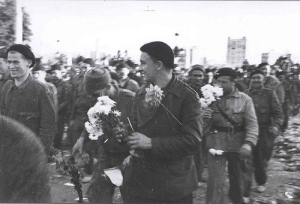

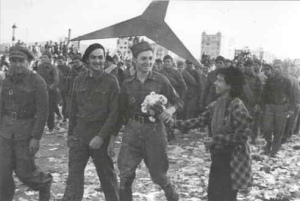
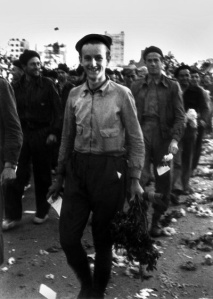
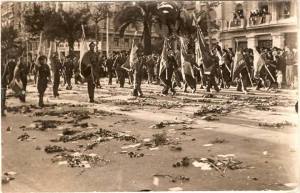

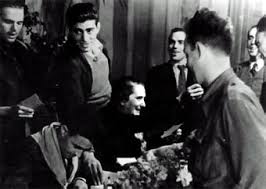



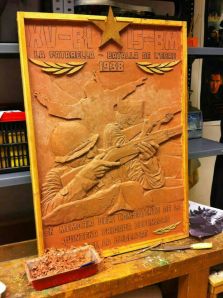
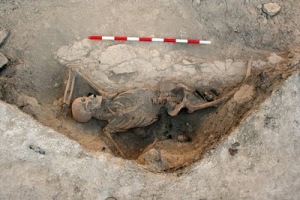


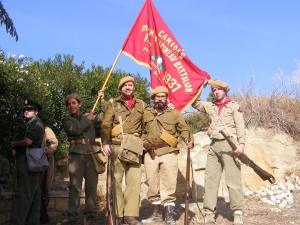
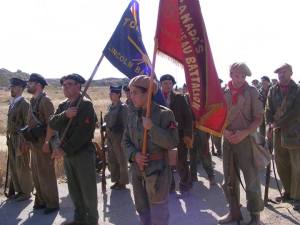

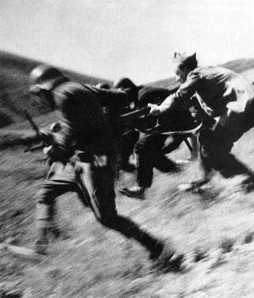










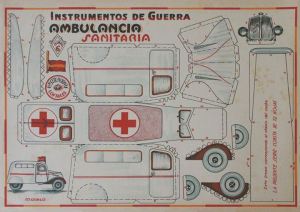

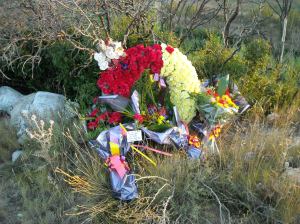
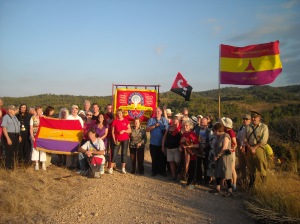




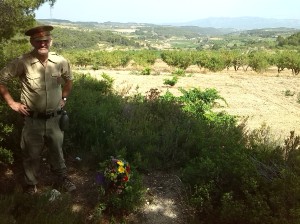
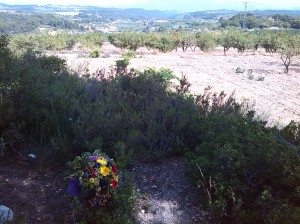
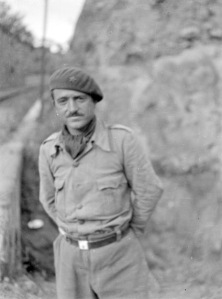

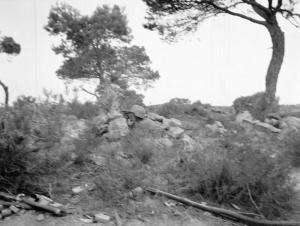

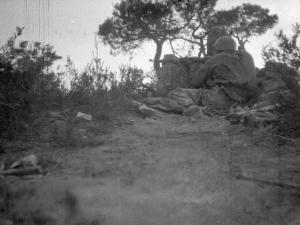
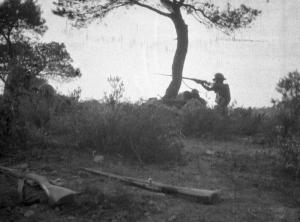
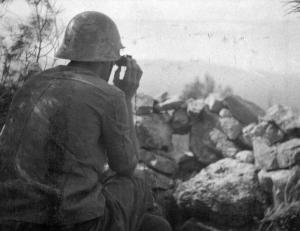


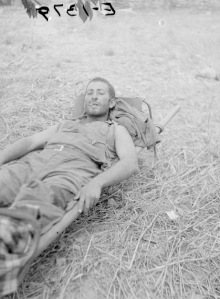








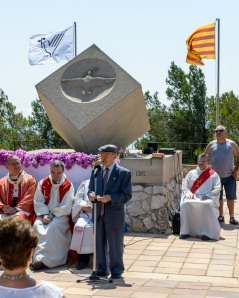
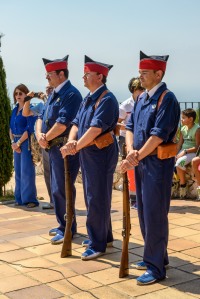




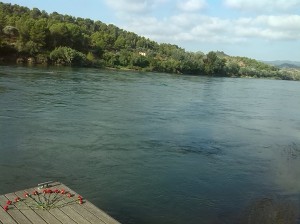

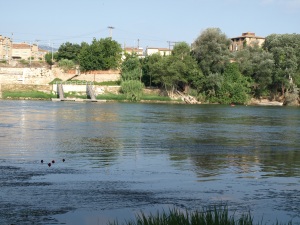


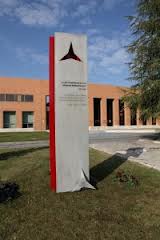



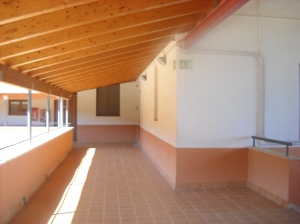
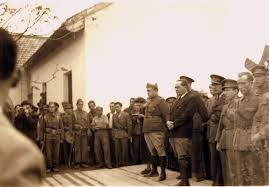
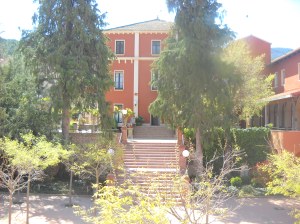
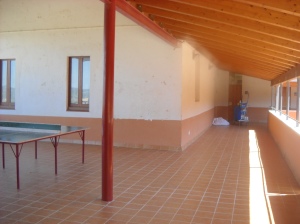

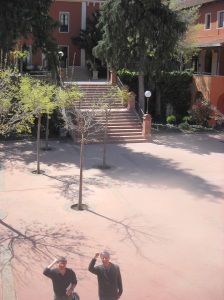

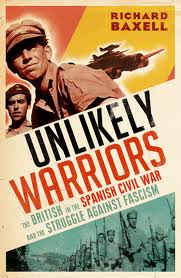
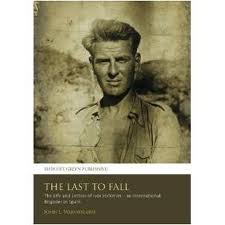
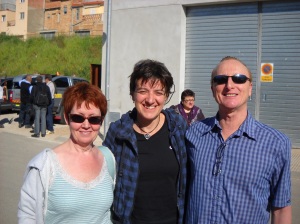


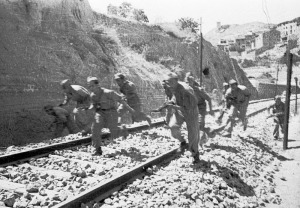



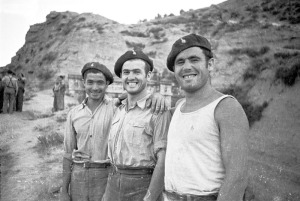

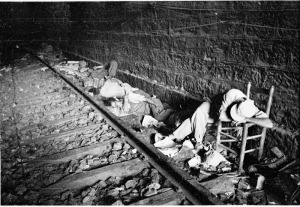
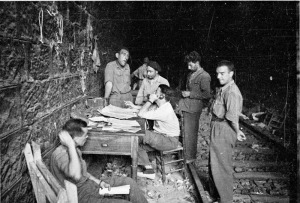

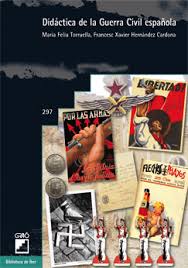



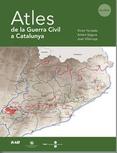
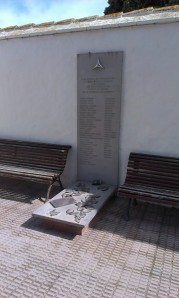

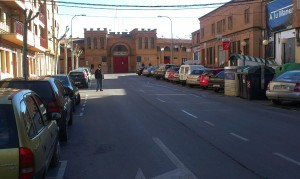


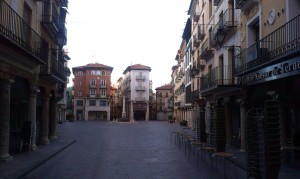
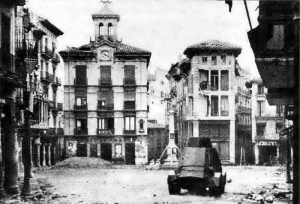

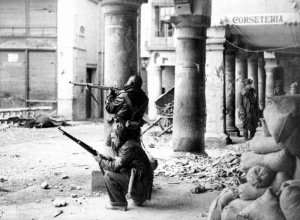
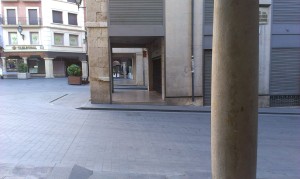



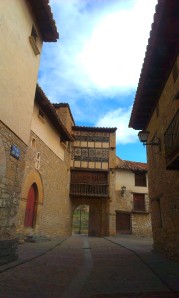




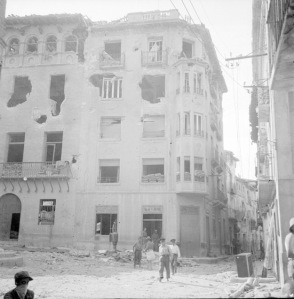

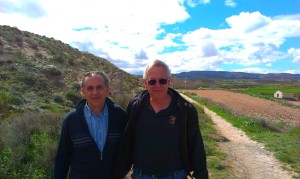
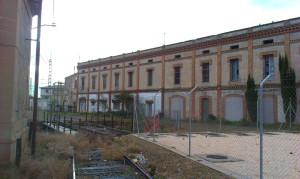
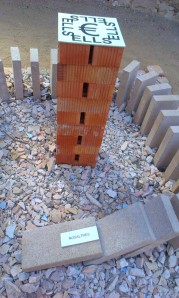
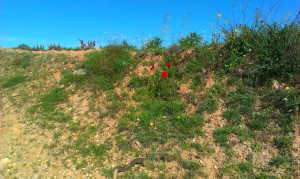
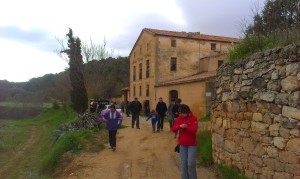



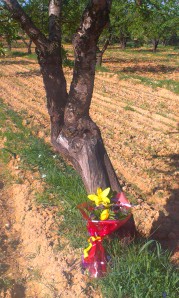
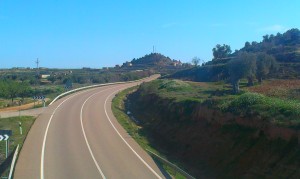











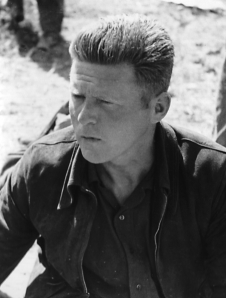



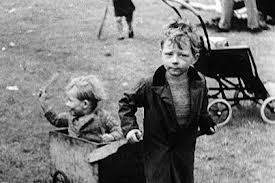
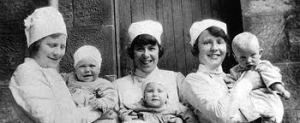








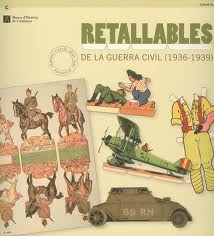

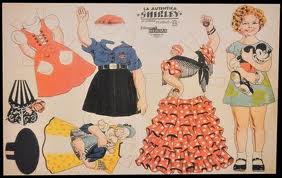


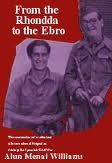
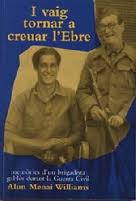





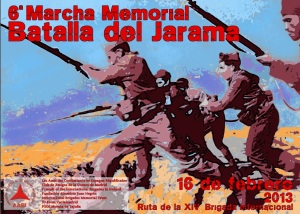
![177_183033s Jarama [Large group of men posed together, some with raised fists]](https://pdlhistoria.files.wordpress.com/2009/12/177_183033s-jarama-large-group-of-men-posed-together-some-with-raised-fists.jpg?w=300&h=207)


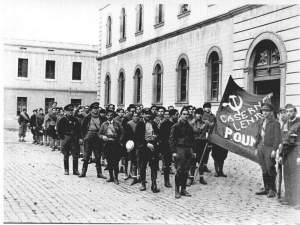
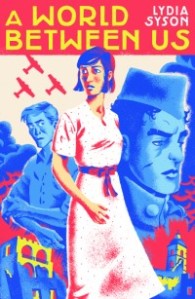



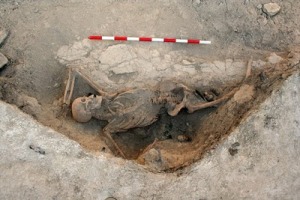

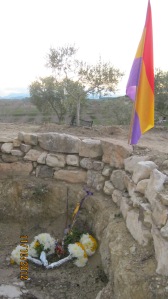







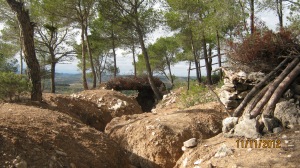


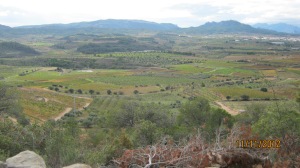

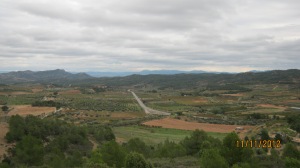
Salud
Great to see your web site is started best of luck Our Dad, Sam, was a Commander of British Battalion in IB
Mike in Sheffield UK
Thank you Mike. I have just had confirmed the date of the Opening of the new COMEBE exhibition for March 27th. There is a photo of your Father with George Fletcher in it and if at least some of your family could come. (aswell as George’s children?) you would be welcomed by la Fatarella with open arms. See stop press article sent round Iinternational Brigade Memorial Trust members last week.
Thanks for your support and talk with your family about coming over for the weekend.
Alan
Congratulations to all of you for reliving scenes and events of the Internationals in the Spanish war. I had picked over most of the battlegrounds of the Lincolns back in the 1960s in researching my books on the Lincoln Brigade and am profoundly moved by your reconstructions and elan. Wonderful! Keep up the good work.
Many thanks Cecil,
Your work has at times been part of the inspiration for further research. Though I greatly admire Peter Carrol`s work more for his research on the post war trials and tribulations of the Lincoln Brigaders I also greatly appreciate your publications in trying to show some of the realities of their experiences here in Spain.
Thanks for that – great to see the memories being preserved
Thank you Nick. There is a great deal more to be discovered. This is really just the tip of the iceberg. And working with Spanish people keen to discover their history makes the work very rewarding for us all.
Alan
great stories and pics Alan
Thanks
Thankyou for such an informative web site. My Great Uncle, Werner Jalmar Wihela, is one of those buried and listed on the Memorial at the Benicassim Cemetery. Werner was born in Oulu, Bayfield County, Wisconsin, USA on 17 Febuary, 1911. His parents, Jacob and Johanna Wihela, immigrated to Wisconsin from Kalajoki Finland. He was the 5th born son of 9 boys and a non-surving sister. Werner was 10 years old when both his mother and baby sister passed. It states that his age is unknown on the Memorial. Werner was 27 years old, at the time of his death. I am proud for what he stood for, and am glad that he is honored for his efforts. I am proud of the fact that he has a respectful and honorable resting place.
Thankyou for all your efforts,
Donald Wihela
Dear Alan,
I guess I wouldn’t have known about this first rate website had I not got inadvertently embroiled over the possible demolition of the hospital at Tarancon. I have listed the website on my favourites and will try to keep in touch.
Despite the Memoria Historica and many others striving to counter the 40 years of false history pedalled by the Francoists, the truth of the civil war still remains a fragile entity.
Your commitment to keep the flame of truth about the war alive, and the involvement of the International Brigades recorded, does you great credit.
Salud
Colin Carritt
PS Love to Merce.
Thanks for the updates Alan , always really interesting. Stirring events in Spain at the moment! Our Antifascistas exhibition and events in July 2011 in Sheffield will alert a lot of people to IB and SCW
Yours
Mike
Hello Mike,
many thanks for the positive feedback. It seems that our cat had done some creative writing whilst I was out and by walking over the keyboard had altered the title! Thanks for pointing that out to me!
There are a great deal of developments going on. There is the huge tour in late October through Spain from Madrid via Albacete to Barcelona, a new 6 part tv programme on the War in Aragon about to go on Aragon tv on Sunday 29th May and numerous other activities and events for the next couple of years to remember the 75th anniversary of the Spanish Civil War.
In June I have been asked to take 50 American students from the Universitat Pompeu Fabrera to the Ebro to show them where the Lincoln Washington battalion fought and on the 18th of June a local historical group (Lo Riu Associacio) will take a group up to the XV Brigade memorial and the newly discovered XV Brigade Estado Mayor located in the Sierra Pandols! Anyone want to come?
Fantastic job!
Honour forever to the heroes of the International Brigades!
I’m from Italy…. 12th Garibaldi’s friend
Hi,
I’ve just discovered your website and found it really interesting, I look forward to reading through it over the next few days.
I just started researching my fathers (Ron Barber) time in the Civil War, he died many years ago when I was 6 so I never got to hear his story from him.
I have had some valuable help from the IBMT.
One thing I do know is that he was on the Ciudad de Barcelona when it was sunk, he survived thanks to an American who pulled him out of the water when he was on the point of drowning. I guess I owe a lot to that American. I hope to visit the area where he eventually made shore (Malgrat) in May, the 75th anniversary.
Anyway a great website. Thanks,
Liam Barber
Hi Alan! You made contact with me on my last trip to Spain March when I visited Miravet as part of research on my novel about the Spanish Civil War. I am coming back to Spain for more research and want to visit Albacete and Madrigueras where several chapters of the book are set. I am planning to be in Albacete/Madrigueras on 24 June. Do you know of anyone there who would be my SCW guide? I know you’re based in Barcelona which I will also be visiting from 18 – 22 June. Perhaps we can meet up or a coffee and chat? Of course, I would love for you to be my guide in Albacete, but I’m guessing it wouldn’t be possible/affordable. Looking forward to hearing from you! All best, Anne
Hi Allan! Thanks for the excellent battlefield tour in August-September 2017 in Cataluna and Araron!
Mikko
Hello Mike,
I have written you in spanish, sorry, now in english.
i am preparing a book where I want to focus on the body during de civil war, and the memory. I am interested in the collage Angel Sola did in the refugee onf the XV brigade, with the ohoto you took. Is it possible to ask him for this compostiion?, I would need his email.
Thank you, and good work!
Susana Velasco
Hello Alan,
It was a great pleasure to read your account. I have had a little house (or shack) in Serra de Pandols, Gandesa for the last fifteen years or so. When I first bought it, it had quite a few shrapnel wounds in the walls…it still has. I came across your website looking for an image of the plaque to the International Brigade to show a friend of mine. It is located on Hill 705, just before the memorial top, which is just about a km from my shack. I’ve taken photos of it before, but they must be on another laptop.
The surrounding area is very interesting & ties in with your account. I can identify many of the locations you mentioned. I’m going to print it all out for the next visit to use as a reference, which I hope will be in the Spring, all being well.
I’m ready to read it all again now.
With kind regards,
Phil